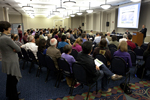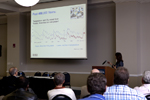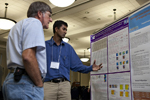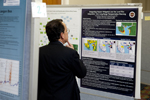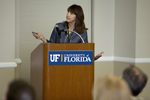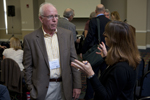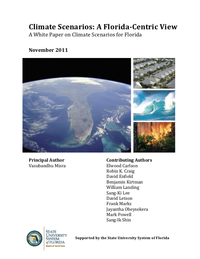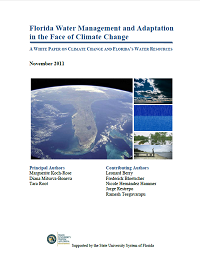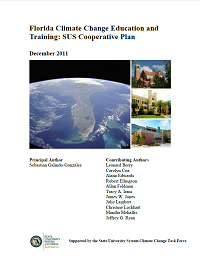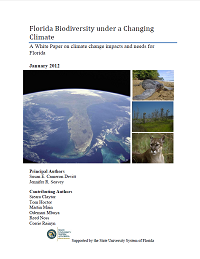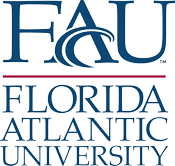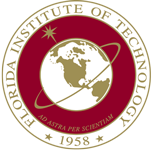News
2022
February 3, 2022: UF 7th Annual Climate Communications Summit: The Power of Listening, featuring Dr. Jennifer Elise Foerster and Dr. Faith Kearns. Gainesville, FL and Virtual.
[ Watch Event Recording ]
January 24, 2022: UF/IFAS/FCI Climate Mini-Workshop on Climate and Carbon Program, featuring Mr. Ernie Shea, Dr. Andrew Zimmerman, and Ms. Debbie Reed.
[ Watch Event Recording ]
2021
Sustainability Into Practice Series:
January 26, 2021: Sustainability Into Practice: Climate Change, Race & Housing, featuring Sekita Grant, Zelalem Adefris, Cleary Larkin, Pia Palomino, and Anne Ray. Virtual.
[ Watch Event Recording ]
March 4, 2021: Sustainability Into Practice: Climate Change, Health & Equity, featuring Dr. Song Liang, Dr. Sadie Ryan, Dr. Cheryl Holder and Dr. Sarah McKune. Virtual.
[ Watch Event Recording ]
April 1, 2021: Sustainability Into Practice: Climate Change and Community Resilience, featuring Dr. Jason von Meding, Lolita Jackson, Lindsay Kallman, and Dr. Marjorie Prokosch. Virtual.
[ Watch Event Recording ]
Legislative Primer Series:
January 29, 2021: Where We Build: Past, Present, and Future Mistakes featuring Gilbert Gaul, author of Geography of Risk. Virtual.
[ Watch Event Recording ]
February 4, 2021: Local Government Financing for Climate Change and Resilience featuring Chad Friedman, Erin Deady, Caroline Lewis, and Thomas Ruppert. Virtual.
[ Watch Event Recording ]
February 12, 2021: Climate, Health, and Equity featuring Naresh Kumar, Sadie Ryan, and Lisa Platt. Virtual.
[ Watch Event Recording ]
2020
November 17, 2020: UF 6th Annual Climate Communications Summit: Climate Reporting Master Class co-sponsored by Climate Matters in the Newsroom and Climate Central. Virtual.
[ Watch Event Recording ]
2019
October 29, 2019: UF 5th Annual Climate Communications Summit: Effectively Communicating Complexity. Gainesville, FL.
[ Watch Event Recording ]
2018
November 15, 2018: Building Agricultural Resistance to Hurricanes - Session 1: Tropical, Nursery and Citrus Industries. Gainesville, FL.
[ Watch Event Recording ]
November 15, 2018: Building Agricultural Resistance to Hurricanes - Session 2: Row Crops. Gainesville, FL.
[ Watch Event Recording ]
November 15, 2018: Building Agricultural Resistance to Hurricanes - Keynote Speaker: David Zierden. Gainesville, FL.
[ Watch Event Recording ]
November 15, 2018: Building Agricultural Resistance to Hurricanes - Session 3: Livestock and Grazing. Gainesville, FL.
[ Watch Event Recording ]
November 15, 2018: Building Agricultural Resistance to Hurricanes - Session 4: Crisis Communications and Assessing Needs of FL Extension Professionals Following 2017 Hurricanes. Gainesville, FL.
[ Watch Event Recording ]
November 7, 2018: Climate Matters in the Newsroom: A UF Climate Change for Journalists Program. Gainesville, FL.
[ Watch Event Recording ]
November 7, 2018: UF 4th Annual Climate Communications Summit: The Forecast Calls for Change: Telling the Story of Climate Science Through Weather. Gainesville, FL.
[ Watch Event Recording ]
February 8, 2018: Malone Lecture with Maxine Burkett, Professor of Law at the William S. Richardson School of Law (U Hawaii) & Global Fellow at the Woodrow Wilson International Center for Scholars: The New Veil: Climate Migration, Regime Shift, and A New Theory of Justice. Gainesville, FL.
[ Watch Event Recording ]
2017
November 15, 2017: Lecture with Rolling Stone's Jeff Goodell, author of the new book The Water Will Come: Rising Seas, Sinking Cities, and the Remaking of the Civilized World. Gainesville, FL.
[ Watch Event Recording (Runtime 71 minutes) ]
November 9, 2017: Lecture on "Wild Futures in Conservation and Climate" with Mac Stone and Shaun Martin. Gainesville, FL.
[ Watch Event Recording (Runtime 128 minutes) ]
October 12, 2017: UF Campus Climate Communication Summit: Diving Deeper: Immersive Storytelling for Climate Science. Gainesville, FL.
[ Watch Event Recording with slides (Runtime 98 minutes) ]
January 19, 2017: Integrating Climate Change into Urban Development Scenarios: The Case of Emerging Latin-American Cities. Lecture at UF with Juan Carlos Vargas-Moreno, Gainesville, FL.
[ Watch Event Recording with slides (Runtime 79 minutes) ] [ Download Flier (PDF) ]
2016
October 12, 2016: Higher Ground: Science, Storytelling and the Climb Toward Better Understanding of Climate Change. UF Climate Communications Summit w/ Ann Christiano, Anthony Leiserowitz, and Neela Banerjee, Gainesville, FL.
[ Watch Event Recording with slides (Runtime 193 minutes) ] [ Download Flier (PDF) ]
September 26, 2016: Sea Level Rise in Days and Decades: What’s Coming and What We Can Do About it. UM 'Cane Talk w/ Ben Kirtman, New York, NY.
[ Watch Event Recording (Runtime 13 minutes) ]
March 30, 2016: Bob Inglis, former South Carolina Congressman, 2015 JFK Profiles in Courage Award winner, and founder of RepulicEn - Free Enterprise Solutions for Climate Change. FCI and Malone Distinguished Scholar Seminar, Gainesville, FL.
[ Watch Seminar with slides (Runtime 107 minutes) ] [ Download Flier (PDF) ]
March 29, 2016: Dr. Marcia McNutt, Editor in Chief of Science Family of Journals - Climate Intervention: A Last Resort? FCI and Malone Distinguished Scholar Seminar, Gainesville, FL.
[ Watch Seminar with slides (Runtime 78 minutes) ] [ Download Flier (PDF) ]
March 10, 2016: Dr. Clyde Fraisse, Associate Professor, Agricultural and Biological Engineering/IFAS, University of Florida - Integrating Big Data, Models and Social Sciences: The Future of Climate Smart Agriculture. FCI Faculty Fellow Seminar, Gainesville, FL.
[ Watch Seminar with slides (Runtime 60 minutes) ]
January 21, 2016: Dr. Andrea Dutton, Assistant Professor, Department of Geological Sciences, University of Florda - What the Past Can Teach Us about Sea-Level Rise Due to Polar Ice-Sheet Mass Loss . Florida Climate Institute Faculty Fellow Seminar, Gainesville, FL.
[ Watch Seminar with slides (Runtime 63 minutes) ] [ Download Flier (PDF) ]
January 11, 2016: Drs. Cheryl Palm and Pedro Sanchez, Earth Institute, Columbia University - Agricultural Intensification: Assessing Tradeoffs and Synergies (Palm) and Cuba´s Search for Food Security (Sanchez) . Gainesville, FL.
[ Watch Seminar with slides (Runtime 91 minutes) ]
2015
November 20, 2015: Dr. David Titley, Professor of Practice in Meteorology, Pennsylvania State University - The Arctic & National Security: People Not Polar Bears. York-Malone Distinguished Lecture, Gainesville, FL.
[ Watch Seminar with slides (Runtime 66 minutes) ] [ Download Flier (PDF) ]
November 2, 2015: Dr. Naomi Oreskes, Professor of the History of Science, Harvard University - Should We Trust Science? Perspectives from the History and Philosophy of Science. York-Malone Distinguished Lecture, Gainesville, FL.
[ Watch Seminar with slides (Runtime 123 minutes) ] [ Download Flier (PDF) ]
October 21, 2015: FSU College of Law - Fall 2015 Environmental Forum: Energy and Clean Power Plan . Tallahassee, FL.
[ Watch Seminar with slides (Runtime 92 minutes) ]
March 9, 2015: Dr. Gary Mitchum, Professor of Physical Oceanography and Associate Dean in the College of Marine Science at the University of South Florida - Climate Lessons from the Venerable Tide Gauge. Distinguished Scholar Seminar, Gainesville, FL.
[ Watch Seminar with slides (Runtime 55 minutes) ] [ Download Flier (PDF) ]
February 20, 2015: Dr. Michael Gerrard, Andrew Sabin Professor of Professional Practice at Columbia Law School - Climate Action in an Era of Congressional Hostility. Distinguished Scholar Seminar, Gainesville, FL.
[ Watch Seminar with slides (Runtime 71 minutes) ] [ Download Flier (PDF) ]
2014
April 28, 2014: Dr. Carlos Duarte, Research Professor with the Spanish National Research Council (CSIC) at the Mediterranean Institute for Advanced Studies (IMEDEA) in Mallorca, Spain, and Director of the Oceans Institute at The University of Western Australia - The Role of Coastal Vegetation in Climate Change Mitigation and Adaptation. Distinguished Scholar Seminar, Gainesville, FL.
[ Watch Seminar with slides (Runtime 82 minutes) ]
April 25, 2014: Dr. Ermias Kebreab, Professor and Endowed Chair in Sustainable Agriculture, Deputy Director, Agricultural Sustainability Institute, University of California Davis - Modeling Environmental Sustainability of Livestock Systems. Food Systems Hub Seminar, Gainesville, FL.
[ Watch Seminar with slides (Runtime 61 minutes) ]
April 24, 2014: Dr. Rajendra Pachauri, Chair of the Intergovernmental Panel on Climate Change - Energy Scenarios and Climate Impacts. Patel College of Global Sustainability Lecture, Tampa, FL.
[ Watch Lecture (Runtime 38 minutes) ]
April 22, 2014: Dr. Dmitry Dukhovskoy, Associate Research Scientist, FSU Center for Ocean-Atmospheric Prediction Studies - Global Warming and Arctic Climate. Novaya Gazeta Real-Time Online Lecture.
[ Novaya Gazeta announcement ]
April 22, 2014: Dr. Eric Chassignet, Director, FSU Center for Ocean-Atmospheric Prediction Studies - Climate Variability of the Atlantic Meridional Overturning Circulation. National Academies Board on Atmospheric Science and Climate Meeting, Tallahassee, FL.
April 22, 2014: Dr. Vasu Misra, Associate Professor, FSU Center for Ocean-Atmospheric Prediction Studies - Overview of Climate Challenges in the Southeast US and Climate Research at FSU; Downscaling Issues with GCMs. National Academies Board on Atmospheric Science and Climate Meeting, Tallahassee, FL.
April 22, 2014: Dr. Zhaohua Wu, Assistant Professor, FSU Center for Ocean-Atmospheric Prediction Studies - Temporal-Spatial Evolution of Long-Term Variability and Change of Land Surface Air Temperature. National Academies Board on Atmospheric Science and Climate Meeting, Tallahassee, FL.
April 4, 2014: Dr. Charles Godfray, Oxford Martin Programme on the Future of Food, Oxford University, UK - The Role of Sustainable Intensification in Global Food Security. FCI Distinguished Scholar Seminar, Sponsored by Kevin and Jeanette Malone, Gainesville, FL.
[ Watch Seminar with slides (Runtime 84 minutes) ]
February 21, 2014: Dr. John M. Antle, Professor of Applied Economics, Oregon State University - Building Better Food Systems: Towards a New Generation of Data and Models. Food Systems Hub Seminar, Gainesville, FL.
[ Watch Seminar with slides (Runtime 72 minutes) ]
February 19, 2014: Dr. Roger Noll, Co-Director of the Center for Regulatory Policy and Professor Emeritus of Economics at Stanford University - The Future of Climate Change. Bob Graham Center for Public Service Seminar, Gainesville, FL.
[ Watch Seminar (Runtime 62 minutes) ]
January 16, 2014: Dr. Ellen E. Martin, Professor, UF Department of Geological Sciences - From the Greenhouse to the Icehouse: Climate Change 33 Million Years Ago ; Dr. Rafael Muñoz-Carpena, Professor, UF Agricultural and Biological Engineering Department - A Peep into Environmental Complexity and Resilience? Global Sensitivity and Uncertainty Evaluation of Mathematical Models. Faculty Fellows Seminar, Gainesville, FL.
[ Watch Seminar with slides (Runtime 83 minutes) ]
January 7, 2014: Mr. David Zierden, State Climatologist, Florida Climate Center - Climate Roundup: 2013 Summer Review and 2014 Winter Outlook. USDA-NIFA Climate Program Project Directors Meeting, Gainesville, FL.
[ Download slides ]
2013
December 16, 2013: Dr. Len Berry, Director, Florida Center for Environmental Studies - Sea Level Rise and Climate Change: Florida's Distinctive Vulnerability. Knight Science Journalism at MIT Energy and Climate Boot Camp, Cambridge, MA.
[ Download slides ]
November 25, 2013: Dr. David Lobell, Associate Professor at Stanford University in Environmental Earth System Science and Associate Director of Stanford’s Center on Food Security and the Environment - Feeding Nine Billion in a Hotter World. Fall FCI Distinguished Scholar Seminar, Gainesville, FL.
[ Watch Seminar with slides (Runtime 78 minutes) ]
November 22, 2013: Dr. Peter J. Jacques, Associate Professor at the University of Central Florida Department of Political Science - Talking Climate Science in a Skeptical World. Woodrow Wilson Center Environmental Change and Security Program/National Communications Association 99th Annual Convention, Washington, DC.
[ Watch YouTube video (210 minutes) and download slides ]
November 19, 2013: Dr. Michael Mann, Distinguished Professor of Meteorology at Penn State - The Hockey Stick and the Climate Wars: Dispatches from the Front Lines. E.T. York Lecture, Gainesville, FL.
[ Watch Seminar with slides (Runtime 99 minutes) ]
November 15, 2013: Dr. Timothy Martin - Long-term cooperative research in southern pines: The greatest good and Dr. Matthew Cohen Sometimes you can see a lot just by looking: How sensors are changing our understanding of rivers. Faulty Fellows Seminars, Gainesville, FL.
[ Watch Seminar with slides (Runtime 70 minutes) ]
November 14, 2013: Fall 2013 Environmental Forum: Adaptation Challenges and A Review of Ongoing Initiatives. FSU College of Law/Environmental and Land Use Section of the Florida Bar, Tallahassee, FL.
[ Watch Seminar with slides (Runtime 89 minutes) ]
November 7, 2013: Dr. Don P. Chambers, Associate Professor, College of Marine Science, University of South Florida - Sea-Level Rise: What we know, what we don't know, what we need to know. Marine Science Speaker Series, Pinellas County Sea Grant Extension, St. Petersburg, FL.
[ Watch Seminar with slides (Runtime 53 minutes) ]
November 6, 2013: Dr. Ann E. Carlson - The Obama administration, climate change, and the Clean Air Act. FSU College of Law/Journal of Land Use and Environmental Law: Environmental Distinguished Lecture, Tallahassee, FL.
[ Watch Seminar with slides (Runtime 70 minutes) ]
April 2-3, 2013: - Sustaining Economies and Natural Resources in a Changing World: Key Role of Land Grant Universities. Gainesville, FL.
[ Event Presentations ]
March 21, 2013: Dr. Stefan Gerber - Modeling the Biogeochemical Cycles of Carbon and Nitrogen on Land & Dr. Baron H. Henderson - The Role of Models in Fundamental Atmospheric Science. Gainesville, FL.
[ Watch Seminar with slides (Runtime 87 minutes) ]
February 21, 2013: Dr. Lisa Goddard - Creating Near-Term Climate Scenarios. Gainesville, FL.
[ Watch Seminar with slides (Runtime 72 minutes) ]
2012
October 25, 2012: Dr. Katharine Wilkinson - Between God & Green: How Evangelicals are cultivating a Middle Ground on Climate Change. Gainesville, FL.
[ Watch Seminar with slides (Runtime 70 minutes) ]
October 10, 2012: Dr. Marshall Shepherd - Multiple facets of climate change in the Southeast: A discussion of natural, greenhouse gas, and urban related changes. Gainesville, FL.
[ Watch Seminar with slides (Runtime 63 minutes) ]
April 19, 2012: Dr. Kenny Broad - Cognitive Challenges to Using Climate Information. Gainesville, FL.
[ Watch Seminar with slides (Runtime 81 minutes) ]
April 5, 2012: Dr. Benjamin Horton - Past sea-levels for the Atlantic coast of the USA. Gainesville, FL.
[ Watch Seminar with slides (Runtime 57 minutes) ]
April 4, 2012: Dr. Zhaohua Wu - On the Time-Varying Trend in Global-Mean Surface Temperature. Tallahassee, FL.
[ Download Slides || Watch Seminar (Runtime 56 minutes) ]
March 14, 2012: Dr. Vasu Misra - Understanding climate change in the southeast US from (recent) past, present and future. Tallahassee, FL.
[ Download Slides || Watch Seminar (Runtime 34 minutes) ]
February 15, 2012: Dr. Bill Hu - Simulating groundwater flow and solute transport in karst aquifers with conduits. Tallahassee, FL.
[ Download Slides || Watch Seminar (Runtime 60 minutes) ]
2011
December 2, 2011: Dr. Markus Jochum - The new Community Earth System Model - An overview of the recent improvements with a focus on diapycnal mixing. Tallahassee, FL.
[ Download Slides || Watch Seminar with slides (Runtime 46 minutes) ]
November 14-15, 2011: Dr. Gary Peter - PINEMAP - Mapping the Future of Southern Pine Management in a Changing World. Gainesville, FL.
[ Watch Seminar with slides (Runtime 24 minutes) ]
November 14-15, 2011: Dr. Andrea Dutton - Empirical Constraints on Future Sea Level Rise: Lessons from the Past. Gainesville, FL.
[ Watch Seminar with slides (Runtime 26 minutes) ]
November 14-15, 2011: Dr. Vasubandhu Misra - Climate with Borders: A Perspective on Florida's Climate. Gainesville, FL.
[ Watch Seminar with slides (Runtime 22 minutes) ]
November 14-15, 2011: Dr. Gary Mitchum - Sea Level Changes in the Southeastern United States: Past, Present and Future. Gainesville, FL.
[ Watch Seminar with slides (Runtime 32 minutes) ]
November 14-15, 2011: Dr. Julie Harrington - Economic, Policy and Other Issues Related to Climate and SLR Research in Florida. Gainesville, FL.
[ Watch Seminar with slides (Runtime 18 minutes) ]
November 3, 2011: Panel Discussion organized by FCI, FSU Sustainable Campus Initiative, the City of Tallahassee "Sustainability and You". Panelists: Jeff Chanton, Mark Isaac, Antron Mahoney and Andy Opel. What does "sustainability" really mean and how are the 3 pillars (Economy, Society and Environment) interconnected? Tallahassee, FL.
[ Download Slides || Watch Seminar (Runtime 85 minutes) ]
October 31, 2011: Huang W. Integrated Hydrodynamic and Ecological Models for Assessment of Climate-Change Impacts on Apalachicola Bay Ecosystem. FCI Seminar. Tallahassee, FL.
[ Download Slides || Watch Seminar (Runtime 22 minutes) ]
October 31, 2011: Ye M. and Donoghue J. Numerical Modeling and Uncertainty Analysis for Effects of Near-Term Sea-Level Rise on Barrier Islands. FCI Seminar. Tallahassee, FL.
[ Download Slides || Watch Seminar (Runtime 28 minutes) ]
October 14, 2011: Knutson, T. Atlantic Hurricanes and Climate Change. FCI Special Guest Seminar. Tallahassee, FL.
[ Download Slides || Watch Seminar (Runtime 60 minutes)]
October 6, 2011: Hayhoe, K. Climate Projections for Florida: Can we Trust the Models? Seminar, UF Water Institute, Gainesville FL
[ Download Slides || Watch Seminar (Runtime 57 minutes) ]
September 9, 2011: Field, C. Climate Change Science in a Skeptical Era. FCI Seminar. Gainesville, FL.
[ Watch Seminar with slides (Runtime 98 minutes) ]
September 7, 2011: Whung, P.-Y. Climate Smart Agriculture for Development - Adaptation Practices and Needs. FCI Seminar. Gainesville, FL.
[ Download Slides ]
July 15, 2011: Nelson, G. (IFPRI); Food Security, Farming, and Climate Change to 2050: Scenarios, Results, Policy Options. UF Gainesville FL
[ Download Slides ]
June 5, 2011: Jones, J. Climate change. University of Florida Classroom Presentation. Gainesville, FL.
May 25, 2011: Jones, J. Welcome from the Florida Climate Institute. Climate Information for Managing Risks Symposium. Orlando, FL.
May 4, 2011: Jones, J. Assessment of climate change impacts and adaptation potential: cropping systems in the SE USA. UF Water Institute: Public Water Supply Utilities Climate Impacts Working Group Workshop. Orlando, FL.
April 21, 2011: Brown, D. Process Modeling of Landscape Dynamics in Coupled Natural Human Systems - Video. Gainesville, FL.
April 14, 2011: Kirtman, B. April 14, 2011: Kirtman, B. - Impact of Ocean Model Resolution on CCSM4 Simulations (pdf). mp4 Video of Presentation with PDF. FCI Seminar. Tallahassee, FL.
April 7, 2011: Putz, F. Sustaining Tropical Forests with Forestry Management. FCI Seminar. Gainesville, FL.
April 7, 2011: Dutton, A. Empirical Constraints on Future Sea Level Rise: Sea Level and Ice Sheet Dynamics During Warm Interglacial Periods. FCI Seminar. Gainesville, FL.
March 24, 2011: Fuelberg, H. Transport of Asian Biomass Burning Emissions to the Arctic-Climatological Considerations. FCI Seminar. Tallahassee, FL.
March 24, 2011: Dewar, W. Inviscid Dissipation in Ocean Climate Models (Click movie1, movie2, movie3, movie4 to view more). FCI Seminar. Tallahassee, FL.
March 22, 2011: Robert H. Socolow. How Would We Act If We Took Climate Change Seriously?. FCI Seminar. Gainesville, FL.
February 17, 2011: Griffin, D. Climate Change and Climate Systems Influence and Control the Atmospheric Dispersion of Desert Dust: Implications for Human Health. FCI Seminar. Tallahassee, FL.
February 3, 2011: Asseng, S. Impact of Heat Stress Events on Wheat Yields. FCI Seminar. Gainesville, FL.
February 3, 2011: Cameron Devitt, S. Integrating Current Distribution and Paleoenvironment to Uncover Patterns of North American Songbird Diversity. FCI Seminar. Gainesville, FL.
January 13, 2011: O'Brien, J. Optimum Big Rain Indicator of Extremes for SE USA. FCI Seminar. Tallahassee, FL.
January 13, 2011: Ruhl, J. B. Climate Change Mitigation and (or Versus?) Adaptation. FCI Seminar. Tallahassee, FL.
January 13, 2011: Elsner, J. On the Increasing Intensity of the Strongest Hurricanes. FCI Seminar. Tallahassee, FL.
2010
November 29, 2010: Morris, J. G. Ciguatera and climate change: don't eat the barracuda. FCI Seminar, Gainesville, FL.
November 29, 2010: Southworth, J. Changing climate variability and its impacts on African savanna ecosystems. FCI Seminar. Gainesville, FL.
November 16, 2010: Jaishankar, S. Research: the key to Florida's future. FCI Kickoff. Tallahassee, FL.
November 16, 2010: Jones, J., and E. Chassignet. Florida Climate Institute Kickoff Overview. FCI Kickoff. Tallahassee, FL.
November 16, 2010: Shea, E. Climate services for society: challenges and opportunities. FCI Kickoff. Tallahassee, FL.
November 16, 2010: van der Tak, L. A practical framework for integrating climate risk and water management. FCI Kickoff. Tallahassee, FL.
November 16, 2010: Wiley, N. Florida: on the frontlines of climate change. FCI Kickoff. Tallahassee, FL.
November 15, 2010: Chanton, J. Permafrost thawing at high latitudes and its affect on the carbon cycle. FCI Seminar. Tallahassee, FL.
November 15, 2010: Outka, U. The renewable energy footprint. FCI Seminar. Tallahassee, FL.
November 15, 2010: Sura, P. Estimating the black swan population: a null hypothesis for the statistics of extreme events in weather and climate. FCI Seminar. Tallahassee, FL.
October 25, 2010: Thomas Ruppert, Esq. Coastal Planning Specialist, Florida Sea Grant College Program. Climate Variability and Change: The Role of Florida Sea Grant. Gainesville, FL.
October 25, 2010: Sanford Berg, Distinguished Service Professor, Economics, Director of Water Studies (PURC). Infrastructure Operations, Governance, and Adaptation to Economic Change. Public Utility Research Center Initiatives. Gainesville, FL.
October 11, 2010: Graham, W. Impacts of climate variability and climate change on water resources. FCI Seminar. Gainesville, FL.
October 11, 2010: Jones, J. W. Opportunities for collaborative interdisciplinary programs through the Florida Climate Institute. FCI Seminar. Gainesville, FL.
October 11, 2010: Martin, T. Carbon management in natural resources and agriculture. FCI Seminar. Gainesville, FL.
September 27, 2010: Chassignet, E. P. Florida Climate Institute. FCI Seminar. Tallahassee, FL.
September 27, 2010: Misra, V. Influence of the Atlantic on Florida sea breeze variations. FCI Seminar. Tallahassee, FL.
September 27, 2010: O'Brien, J. J. ENSO US landfall probabilities revisited. FCI Seminar. Tallahassee, FL.
July 29, 2010: Jones, J. W. Introducing the Florida Climate Institute: a joint venture between the University of Florida and Florida State University. Gainesville, FL.
January 18-20, 2010: Jones, J. The Florida Climate Institute: science for societal responses to a changing and uncertain climate, a work in progress. Archbold Biological Station. Venus, FL.
2009
November 9, 2009: Jones, J. W. The Florida Climate Institute, a work in progress: integrating projects into an interdisciplinary program. Gainesville, FL.
| Download or subscribe to The Environmental Minute podcast on iTunes |
|
| Follow The Environmental Minute on Facebook |

The natural world explained in one-minute segments by experts from FSU!
Environmental experts from the Florida State University provide information on a range of topics, including sea-level rise, greenhouse gas emissions, renewable energy, green technologies, pollution, hurricanes, ocean circulation, El Niño and many more. This program aired weekly on 88.9 WFSU-FM (Tallahassee, Florida) from May 2011 through April 2012. Production was co-sponsored by The Florida State University College of Arts and Sciences; The Florida State University Department of Earth, Ocean and Atmospheric Science; and the Florida Climate Institute.
Listen to the segments and explore the WFSU Environmental Minute webpage:
- Wind power: what's in it for Florida?
By Dr. Mark Powell, Atmospheric Scientist stationed at the Florida State University
- How do climate variations affect Florida's manatees?
By Dr. Lydia Stefanova, Meteorologist at the Florida State University
- What is a LEED home?
By Dr. Mark Powell, Atmospheric Scientist stationed at the Florida State University
- Why is the air temperature so varied across town?
By Paul Rusher, Associate Professor of Meteorology at the Florida State University
- What is a biofuel?
By Vladislav Lobodin, Researcher at the Future Fuel Institute
- What can I do to improve my personal sustainability footprint at school, work, and home?
By Elizabeth Swiman, Director of Campus Sustainability at the Florida State University
- Where does Florida get its drinking water?
By Linda Jamison, Researcher at the Florida State University
- What is the potential sea-level rise scenario for the next century, and how will it affect Florida?
By Dr. Joseph Donoghue, Associate Professor of Geology at the Florida State University
- Why are pine trees not always a good thing locally?
By Bruce Means, Courtesy Professor of Biology at the Florida State University
- What are greenhouse gases, and how do they warm our planet?
By Robert Ellingson, Professor of Meteorology at the Florida State University
- Can tsunamis occur in the Atlantic Ocean, and what are the risks to the eastern United States?
By James Tull, Professor of Geology at the Florida State University
- What causes sea level to rise?
By Bill Dewar, Professor of Oceanography at the Florida State University
- What is the long-term impact of the BP oil spill?
By Ian MacDonald, Professor of Oceanography at the Florida State University
- What is the butterfly effect on weather?
By Jon Ahlquist, Associate Professor of Meteorology at the Florida State University
- Why do we get so much rain in the "Sunshine State"?
By Melissa Griffin, Assistant State Climatologist at the Florida State University
- What is lightning?
By Dr. Henry Fuelberg, Professor of Meteorology at the Florida State University
- How does ocean circulation affect Earth's climate?
By Dr. Eric Chassignet, FCI Co-Director and Director of the Center for Ocean-Atmospheric Prediction Studies
- Why do ocean wave crests seem to be almost parallel to the coast in very shallow water, yet they have more of an angle to the coast as one goes into deeper water offshore?
By Todd Walton, Director of the Beaches and Shores Research Center at the Florida State University
- What is the difference between weather and climate, and climate change and global warming?
By David Zierden, State Climatologist at the Florida State University
- Can energy be harnessed from ocean currents?
By Dr. Alexandra Bozec, Oceanographer at the Florida State University
- What can we learn about Earth's climate from space?
By Dr. Mark Bourassa, Associate Professor of Meteorology at the Florida State University
- What does a forecast of 20% chance of rain mean?
By Dr. Vasu Misra, Assistant Professor of Meteorology at the Florida State University
- Can high magnetic fields affect the weather?
By Dr. Gregory Boebinger, Professor of Physics and Director of the National High Magnetic Field Laboratory
- What is El Niño and how does it affect the Big Bend region?
By Dr. Allan Clarke, Professor of Oceanography at the Florida State University
- Performance based septic systems are required by code for new constructions in some counties and are now considered for others. What are these systems and do they really reduce nitrogen levels in our groundwater?
By Dr. Jeff Chanton, Professor of Oceanography at the Florida State University
- Why don't hurricanes form over land and why do they tend to die when they make landfall?
By Dr. James O'Brien, Professor Emeritus of Meteorology and Oceanography at the Florida State University
Have you got any feedback for us? We are interested and listening to you as it helps us to improve the program. Email us your comments, questions or suggestions at envmin@coaps.fsu.edu or use this form.
The Environmental Minute is sponsored by the FSU College of Arts and Sciences, the FSU Department of Earth, Ocean and Atmospheric Science, and the Florida Climate Institute. FSU Center for Ocean-Atmospheric Prediction Studies' Professor Vasu Misra is leading the development of this program.
Media Releases
This page is currently under construction and will be available very soon.
Click here to join our mailing list.
| 2025 | Feb Mar Apr |
| 2024 | Feb Mar Apr May Jun Sep Oct Nov Dec |
| 2023 | Jan Feb Mar Apr May Jun Jul/Aug Sep Oct Nov Dec |
| 2022 | Jan Feb Mar Apr May Jun Sep Oct Nov Dec |
| 2021 | Jan Feb Mar Apr May Jun Jul/Aug Sep Oct Nov Dec |
| 2020 | Jan Feb Mar Apr May Jun Jul/Aug Sep Oct Nov Dec |
| 2019 | Jan Feb Mar Apr May Jun Jul/Aug Sep Oct Nov |
| 2018 | Jan Feb Mar Apr May Jun Jul/Aug Sep Oct Nov/Dec |
| 2017 | Jan Feb Mar Apr May Jun Jul Aug Sep Oct Nov Dec |
| 2016 | Jan Feb Mar Apr May Jun Jul Aug Sep Oct Nov Dec |
| 2015 | Jan Feb Mar Apr May Jun Jul Aug Sep Oct Nov Dec |
| 2014 | Jan Feb Mar Apr May Jun Jul/Aug Sep Oct Nov Dec |
| 2013 | Feb Apr Jun Sep Nov Dec |
| 2012 | Jan Feb Mar Apr May Sep Oct |
| 2011 | Jan Feb Mar Apr May Jun Summer Sep Oct Nov Dec |
(click on the header to expand)
Climate change experts to meet Nov. 14 and 15 at UF | November 7, 2011
Writer: Donna Hesterman, 352-846-2573, This email address is being protected from spambots. You need JavaScript enabled to view it.
Sources: Carolyn Cox, This email address is being protected from spambots. You need JavaScript enabled to view it., 352.392.1864 x 233
GAINESVILLE, Fla. -- Scientific experts focusing their research on Florida’s changing climate will gather next week for a two-day event that features panel discussions, poster sessions, and keynote speakers.
Events will begin Nov. 14 at UF’s Emerson Alumni Hall with a poster session that marks the opening of the Florida Climate Institute, or FCI, annual meeting. The annual meeting will then roll into the Florida Climate Change Task Force, or FCCTF, workshop beginning at 5 p.m. and last through the following day. Interested parties must register online to attend. Seating is limited.
At the FCCTF workshop, researchers will reveal findings for four climate studies that began early in 2011. The reports describe how climate change could affect biodiversity, current climate patterns, and diminish Florida’s freshwater resources. The studies are the culmination of yearlong projects and include an outreach plan for making climate science education more accessible to the public.
Andrea Dutton, a UF assistant professor of geology will open a series of talks for FCI’s annual meeting by discussing her work using geochemical analysis techniques to answer questions about the Earth’s past climate. Other speakers will present on topics ranging from a pine forest carbon sequestration project, to sea level changes that threaten Florida’s coast, to a session on economic policy issues related to climate change.
FCI is offering a training workshop for scientists as part of their annual meeting agenda. The purpose of the training is to help researchers learn to explain their work more effectively to the media and lay audiences. FCI coordinator Carolyn Cox said that she felt this type of training is critical to ensuring that government officials and industry leaders understand the latest scientific data available as they plan for Florida’s future.
For more information, visit http://www.floridaclimateinstitute.org
Download Full Story as Word Document
The two day event began with the Florida Climate Institute Annual Event (click here for event program) on Monday which offered attendees diverse presentations about various climate scenarios for Florida and the impacts on the environment and economy. Many also participated in a communications workshop to better bridge the gap between science, policy, and citizenry. The evening keynotes, Steve Seibert and Virginia Burkett, presented an interesting balance of social responsibility and climate science.
On Tuesday, November 15, The State University System of Florida Climate Change Task Force Event (click here for event program) featured Jayantha Obeysekera with a keynote that led to panel discussions with leaders from around the state and country about climate impacts.
Over the 2 days, there were 17 presentations, 175 attendees, and 64 posters contributing the success of the events.
Thanks to all who participated!
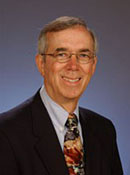 James W. Jones, FCI Director, was elected to the National Academy of Engineering for his contributions to understanding climate change, environmental impacts, and sustainable agricultural systems.
James W. Jones, FCI Director, was elected to the National Academy of Engineering for his contributions to understanding climate change, environmental impacts, and sustainable agricultural systems.
The National Academy of Engineering (NAE) has elected 66 new members and 10 foreign associates, announced NAE President Charles M. Vest on Thursday, February 9, 2012. This brings the total U.S. membership to 2,254 and the number of foreign associates to 206.
Election to the NAE is among the highest professional distinctions accorded to an engineer. Academy membership honors those who have made outstanding contributions to "engineering research, practice, or education, including, where appropriate, significant contributions to the engineering literature," and to the "pioneering of new and developing fields of technology, making major advancements in traditional fields of engineering, or developing/implementing innovative approaches to engineering education."
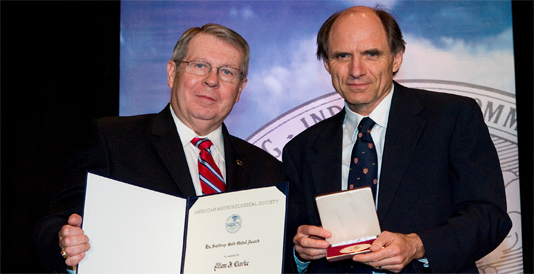 The American Meteorological Society has awarded Professor Allan J. Clarke, Department of Earth, Ocean and Atmospheric Science, Florida State University, the 2012 Sverdrup Gold Medal Award for fundamental contributions to the dynamics of ocean currents and air-sea interactions with particular emphasis on the El Niño-Southern Oscillation.
The American Meteorological Society has awarded Professor Allan J. Clarke, Department of Earth, Ocean and Atmospheric Science, Florida State University, the 2012 Sverdrup Gold Medal Award for fundamental contributions to the dynamics of ocean currents and air-sea interactions with particular emphasis on the El Niño-Southern Oscillation.
Researchers throughout Florida have been expressing a need for high-resolution regional climate and climate projection datasets for quite a while. I am delighted to introduce to you our new arrival: the COAPS Regional Downscaling for the Southeast United States. We are providing hourly model output (surface temperature, precipitation and much more) at a 10km resolution, for two categories of simulations:
- downscaling of Global Reanalyses (sub-project CLARReS10) for the period 1979-2000, and
- downscaling of three Global Climate Models (sub-project CLAREnCE10) for the periods 1968-2000 and 2038-2070.
This is a uniquely detailed and comprehensive dataset that, we hope, would be useful as the climate driver to a range of hydrological and ecological modeling studies. The downscaling procedure has been successfully validated in a peer-reviewed publication. We invite you to visit the CLARReS10/CLAREnCE10 datasets here.
Let This email address is being protected from spambots. You need JavaScript enabled to view it. know what you think!
The University of Florida and the Guana Tolomato Matanzas National Estuarine Research Reserve (GTM NERR) have received a highly competitive NERRS Science Collaborative Grant to pilot a sea level rise adaptation planning process in the Matanzas Basin near St. Augustine. The project team will work with stakeholders and coastal decision makers to deliver a habitat vulnerability assessment for the basin and to identify opportunities for protecting coastal to inland ecological connectivity. The methodologies will be carefully designed and evaluated to ensure robustness and transferability to other NERR System sites and coastal areas. The interdisciplinary project team includes several UF faculty members: Kathryn Frank, principal investigator and assistant professor of urban and regional planning, Dawn Jourdan, assistant professor of urban and regional planning, Paul Zwick, associate dean and professor of urban and regional planning, Tom Hoctor, director of the Center for Landscape Conservation Planning, Bob Grist, associate professor of landscape architecture, Greg Kiker, associate professor of agricultural and biological engineering, and Thomas Ruppert, coastal planning specialist, Florida Sea Grant. The three-year project, funded at $618,377, kicked off in December.
FCI Member and FSU Professor Allan Clarke, with Assistant Scientist Lucia Bunge received a NSF grant to work on a new project "Understanding Observed Equatorial Pacific, Indian and Atlantic Ocean Interannual Flow Using Theory and High Resolution ECCO2 Model Results". Fundamental to an understanding of El Niño/Southern Oscillation climate fluctuations is an understanding of the anomalous equatorial Pacific surface flows which move the surface waters and change the sea surface temperature. Through the advent of accurate satellite altimeter measurements from late 1992 to the present, they now have an unprecedented opportunity to examine these flows not just in the Pacific, but also in the Indian and Atlantic Oceans. The main goal of this project will be to describe the anomalous equatorial surface flows in all three ocean basins and understand major aspects of them using theory and the dynamically consistent high resolution ECCO2 global numerical model. The scientific community is beginning to take advantage of the ECCO2 global ocean model, and a secondary benefit of the analysis will be the evaluation of the accuracy of this model and its dynamics near the equator in all three ocean basins. The foundational knowledge gained during this project should be helpful to the many scientists who will analyze future long records of equatorial climate data gathered in the multinational Atlantic Ocean PIRATA and Indian Ocean RAMA observational programs.
Research on global systems suggests that coastal communities and regions are becoming increasingly vulnerable to sea level rise and climate change. As a result, researchers and practitioners are developing processes, tools, and strategies for adapting to future impacts. Building on existing and previous UF research, three sea level rise adaptation planning projects "Development of Sea Level Rise Adaptation Planning Procedures and Tools Using NOAA Sea Level Rise Impacts Viewer", "A Spatial-Temporal Econometric Model to Estimate Costs and Benefits of Sea Level Rise Adaptation Strategies", "Rural Coastal Region Adaptation Planning for Sea Level Rise" led by DCP faculty, Zhong-Ren Peng, Kathryn Frank and Dawn Jourda recently received funding from the National Oceanic and Atmospheric Administration (NOAA) through the Florida and Mississippi-Alabama Sea Grant programs.
Four new White Papers were presented during the Florida Climate Change Task Force workshop - an event supported by the State University System of Florida
Climate Scenarios: A Florida-Centric View
Leader: Vasubandhu Misra
Contributors: Elwood Carlson, Robin K. Craig, David Enfield, Benjamin Kirtman, William Landing, Sang-Ki Lee, David Letson, Frank Marks, Jayantha Obeysekera, Mark Powell, Sang-lk Shin
Florida Water Management and Adaptation in the Face of Climate Change
Leaders: Marguerite Koch-Rose, Diana Mitsova-Boneva, and Tara Root
Contributors: Leonard Berry, Frederick Bloetscher, Nicole Hernández Hammer, Jorge Restrepo, Ramesh Teegavarapu
Florida Climate Change Education and Training: SUS Cooperative Plan
Leader: Sebastian Galindo-Gonzalez
Contributors: Leonard Berry, Carolyn Cox, Alana Edwards, Robert Ellingson, Allan Feldman, Tracy A. Irani, James W. Jones, Julie Lambert, Christine Lockhart, Mantha Mehallis, Jeffrey G. Ryan
Florida Biodiversity under a Changing Climate
Leaders: Susan E. Cameron-Devittt, Jennifer R. Seavey
Contributors: Sieara Claytor, Tom Hoctor, Martin Main, Odemari Mbuya, Reed Noss, Corrie Rainyn
Click here for climate education opportunities in the State University System of Florida.
Incorporating Climate Change Effects into Next-Generation Coastal Inundation Decision Support Systems is an integrated and community-based approach that will develop the next generation Coastal Inundation Decision Support System (CIDSS), by incorporating the projected impact of climate change on hurricanes and SLR in the next 20-30 years and the next 80-100 years.
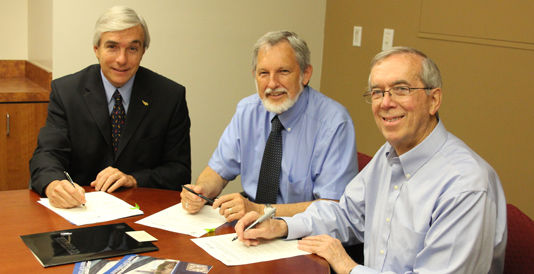
The Florida Climate Institute and the International Center for Tropical Agriculture signed a Cooperative Agreement on Monday, April 16 that will help to strengthen decision making and policy analysis, capacity building and knowledge management, especially as these relate to climate change and tropical agriculture.
Pictured: Dr. Ruben Echeverria, Director General CIAT, Dr. David Sammons, Dean for International Programs, UF, and Jim Jones, Director of FCI, UF.

Grower Kirk Brock talks about adapting to rainfall extremes on his dryland farm in Florida and how seasonal climate forecasts should help him improve his operation.
To view the full video, visit the ClimateWatch Magazine.
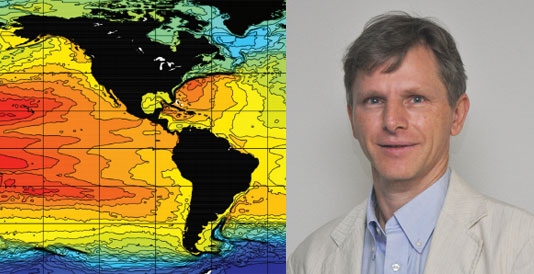
FSU's Distinguished Research Professor Award is the third highest faculty award at Florida State. Dr. Chassignet received the award at the Faculty Awards Ceremony April 9.
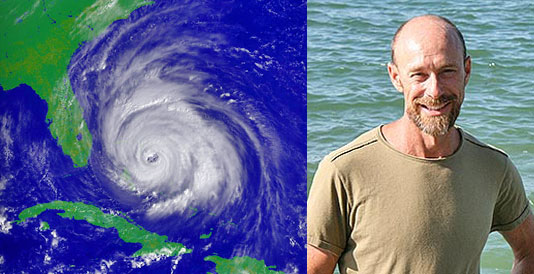
During a recent Florida Climate Institute Distinguished Scholar Seminar, Dr. Kenny Broad, University of Miami, shared a new tool he developed with Dr. Robert Meyer of the University of Pennsylvania with funding from the National Science Foundation. The interactive simulation is designed to learn about how we make decisions while preparing for hurricanes and tropical storms. Stormview has participants view information about a storm forming in the distant Atlantic over time until the storm intensifies and decisions are needed. Days pass, various information sources are offered, choices for preparations are explored, and several scenarios for the storm’s impact are possible.
Go to https://cessna.wharton.upenn.edu/stormview to try it
Username and password: storm
See complete archived seminar here - April 19, 2012, Gainesville, FL: Cognitive Challenges to Using Climate Information.
Dr. Broad is the Director of the Leonard and Jane Abess Center for Ecosystem Science and Policy and a Professor in the Division of Marine Affairs and Policy at UM’s Rosenstiel School of Marine and Atmospheric Science. He also holds a joint appointment at Columbia University where he serves as Co-Director of the Center for Research on Environmental Decisions.
Dr. Meyer is the Gayfryd Steinberg Professor and Co-Director of Wharton's Risk Management and Decision Processes Center.
A team of FCI scientists at the Florida State University Center for Ocean-Atmospheric Prediction Studies (FSU COAPS) has just released the fourth annual FSU COAPS Atlantic hurricane season forecast. This year's forecast calls for a 70 percent probability of 10 to 16 named storms and 5 to 9 hurricanes. The mean forecast is for 13 named storms, 7 hurricanes, and an average accumulated cyclone energy (ACE; a measure of the strength and duration of storms) of 122. These numbers are based on 51 individual seasonal forecasts conducted since May 25, 2012 using sea surface temperatures predicted by NOAA.
The forecast mean numbers are slightly below the 1995-2010 average of 14 named storms and 8 hurricanes, and reflect the possible emergence of El Niño conditions in the tropical Pacific and cooling surface water temperatures in the tropical North Atlantic.
The scientists use a numerical atmospheric model developed at COAPS to understand seasonal predictability of hurricane activity. The model is one of only a handful of numerical models in the world being used to study seasonal hurricane activity and is different from the statistical methods used by other seasonal hurricane forecasters. FSU is the only university in the United States issuing a seasonal hurricane forecast using a global numerical atmospheric model. The model uses the high performance computers at FSU to make predictions of the atmosphere six months into the future. Based on these atmospheric predictions, tropical activity is objectively determined and forecasts are issued around June 1st.
The COAPS forecast is already gaining recognition for its accuracy only three years after its launch. The 2009 forecast predicted 8 named storms and 4 hurricanes, and there ended up being 9 named storms and 3 hurricanes that year. The 2010 forecast predicted 17 named storms and 10 hurricanes, and there were actually 19 named storms and 12 hurricanes. The 2011 forecast predicted an average of 17 named storms and 9 hurricanes, and there were actually 19 named storms and 7 hurricanes. Re-forecasts conducted using data since 1982 shows that the model has a mean absolute error of 1.9 hurricanes and 2.3 named storms. Details about past forecasts are archived here.
To learn more about this forecast, contact lead scientist Tim LaRow (This email address is being protected from spambots. You need JavaScript enabled to view it.; (850) 644-6926) and see the following article:
Source: http://coaps.fsu.edu/hurricanes/
By Elizabeth Bettendorf, FSU News, 6/14/2012
The ancient reserves of methane gas seeping from the melting Arctic ice cap told Jeff Chanton and fellow researchers what they already knew: As the permafrost thaws, there is a release of methane, a powerful greenhouse gas that causes climate warming.
The trick was figuring out how much, said Chanton, the John W. Winchester Professor of Oceanography at Florida State University.
The four-member team — whose findings were published in the respected journal Nature Geoscience — documented a large number of gas seep sites in the Arctic where permafrost is thawing and glaciers receding (they found 77 previously undocumented seep sites, comprising 150,000 vents to the atmosphere). Until recently, the cryosphere (frozen soil and ice) has served to plug or block these vents. But thawing conditions have allowed the conduits to open, and deep geologic methane now escapes.
The team studied the link between natural gas seepage and the melting ice cap, using aerial photos and field data to figure out the number — and location — of seep holes.
So, here’s the rub: The more the ice cap melts, the more methane is released into the atmosphere — and the more the climate warms.
Why should this matter to you?
People who live in coastal areas of Florida could be directly affected, said Chanton, who analyzed the methane and dated it to more than 40,000 years old.
All this seeping methane causes more melting ice, Chanton said, which causes sea levels to rise and could affect coastal real estate values — sooner rather than later.
How soon?
Possibly over the next 50 to 100 years, Chanton said.
“Methane is a very strong greenhouse gas that’s grown three times faster than carbon dioxide since the industrial era,” Chanton said. “As the Arctic warms, the ice caps melt and the fissures open, so methane escapes and causes more warming.”
This phenomenon causes sea levels to rise, which is particularly problematic in Florida:
“Along the flat Florida coastline, a 1-foot rise in sea level could cause anywhere from 10 to 100 feet of shoreline retreat — erosion,” Chanton said. “For us here in Florida, this is really important because we can expect the coast to recede.”
That beach house, he warned, might be in peril: “It may not be there for your grandchildren.”
Source: http://news.fsu.edu/More-FSU-News/Study-Seeping-Arctic-methane-has-serious-implications-for-Florida-coastline
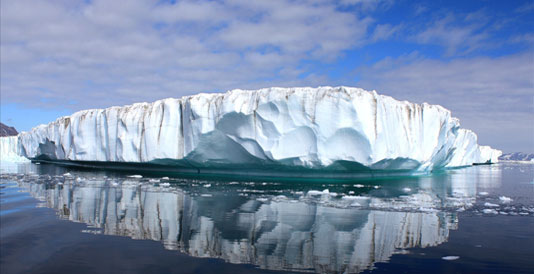
GAINESVILLE, Fla. — A new study by a University of Florida researcher finds that sea level peaked between 18 and 30 feet above current sea level during the last interglacial period approximately 125,000 years ago.
That’s significant, the researchers say, because knowing how high sea level peaked previously tells us something about how the earth may respond as global temperatures rise again.
The finding differs from many studies on sea level during the previous warming period because the researchers use fossil coral reef data to estimate sea levels and then factor in the physics of how ever-changing ice sheets have affected those estimates. The range of sea level maximums that they estimate for the period suggests that part of the Greenland ice sheet had collapsed, as well as a large portion of the West Antarctic ice sheet and possibly sectors of the East Antarctic ice sheet.
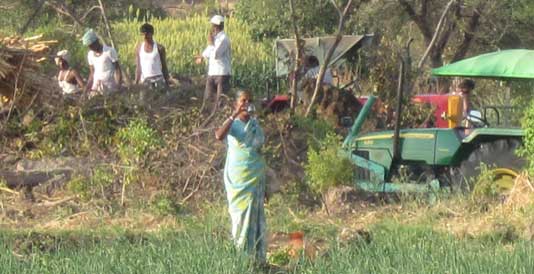
Dr. Jim Jones, FCI director at the University of Florida, is co-leading an international research initiative aimed at assessing climate impacts on regional and global food security now and in the future. Also part of this AgMIP (Agricultural Model Intercomparison and Improvement Project) team at UF are Ken Boote, Senthold Asseng, and Cheryl Porter. The project was featured in the August issue of Nature Climate Change and brings together experts who use computer models to understand how the world's major economic crops are vulnerable to changing climate. Within this program, a Modeling Group on Livestock and Grasslands was launched. The aim is to intercompare and further develop a range of models to be applied internationally, especially for climate change impact projections. Dr. Jim Jones’s team is part of the Grassland & Rangeland modeling sub-group. Activities and meetings are starting now; results will be discussed in the Fall 2013. For more information, download the press release.
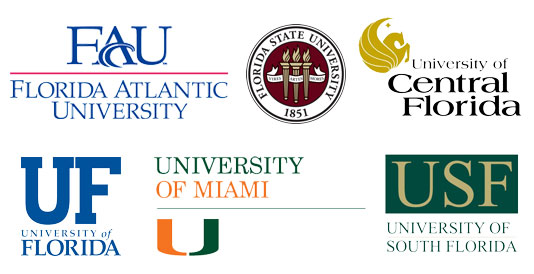
We are pleased to announce that the Florida Climate Institute is expanding to increase the effectiveness of collaborations among universities and state and local agencies in Florida. The FCI will include Florida Atlantic University, the University of Central Florida, the University of Miami, and the University of South Florida (including the Patel School of Global Sustainability), in addition to the University of Florida and Florida State University. By bringing together even more outstanding scientists from across the state, we are able to increase both the breadth and the depth of our research and better inform Floridians about the economic and environmental opportunities and risks our state faces due to climate variability, climate change, and sea level rise.
The Florida Climate Institute, along with the Patel College of Global Sustainability, hosted the National Climate Assessment Southeast Town Hall Meeting in Tampa.
The event featured speakers from academic institutions, federal agencies, water utility and management, as well as authors of various chapters. These talks were streamed and can be viewed at (need link from UCAR).
The U.S. Global Change Research Program (USGCRP) released the National Climate Assessment (NCA) draft report last month to be reviewed by scientists and experts from inside and outside the federal government, the National Academy of Sciences, and the public. The report analyzes the effects of global changes on the natural environment, agriculture, energy production and use, land and water resources, transportation, human health and welfare, human social systems, and biological diversity; and analyzes current trends in global changes, both human-induced and natural, and projects major trends for the subsequent 25 to 100 years. The report includes a chapter on the southeastern USA and key messages for this region. More information about the National Climate Assessment can be found online at http://assessment.globalchange.gov.
Both the FCI and Southeast Climate Consortium (SECC) played major leadership and writing roles in this assessment for the southeastern states. Keith Ingram of UF (Director of the SECC) was the lead author on the SE technical report and Jim Jones (UF Director of the Florida Climate Institute) was co-lead author on the SE Assessment chapter in this report. At the meeting, a summary of the SE Assessment Report was presented.
All videos of the Southeast Regional Town Hall Meeting can be accessed directly from the YouTube Channel: http://www.youtube.com/NCAengagement.
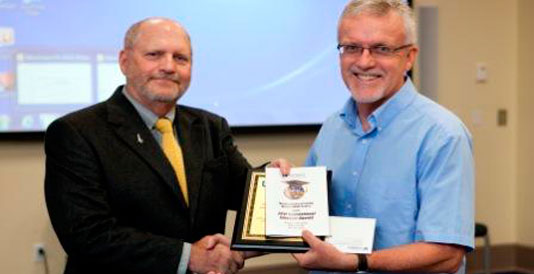
Dr. Clyde Fraisse is recognized internationally as a leader in climate variability and change adaptation research and extension and in the development of climate-based decision support systems. The AgroClimate system developed by Dr. Fraisse for the southeastern U.S. is now an open source platform being replicated in Africa and Latin America. Educated in the U.S., Belgium, and Brazil, he is naturally comfortable in multiple cultures as he collaborates on research projects and co-publishes with international colleagues. Dr. Fraisse is a member of the World Meteorological Organization Expert Team on “User response to climate variability and change”. He is currently implementing an AgroClimate system for Cooperatives in Paraguay and was selected by the Government of Jordan to help develop synergetic approaches for complying with the Rio convention protocols. Dr. Fraisse is also collaborating with the World Bank in the development of climate smart tools for farmers in Kenya and Ethiopia and is the principal investigator for a project funded by the Department of Education and CAPES for the exchange of students between the University of Florida and universities in Brazil. His accomplishments have had a worldwide impact and greatly contributed to the internationalization of IFAS.
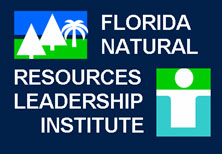
The Florida Natural Resources Leadership Institute (NRLI) is now accepting applications for Class XIII, which begins August 6, 2013 and continues through April , 2014. The 8 month fellowship will focus on "The Future of Water in Florida."
The program meets once per month at a different community in Florida to explore the natural resource topic and participate in discussions and activities with stakeholders in that community.
Institute graduates will be better able to help the people, industries, and institutions of Florida collaborate in achieving the often conflicting goals of protecting the environment and the people while fostering economic development. For more information and for the full schedule, please visit http://nrli.ifas.ufl.edu/.
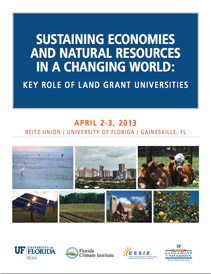
The symposium held April 2-3 at the University of Florida drew 250 attendees and featured speakers from other academic institutions around the world, businesses, and agencies. The event helped to honor the 150th anniversary of the Morrill Act which helped to make higher education accessible to all in America. Please visit the event website for recorded presentations, program, poster abstracts, panel session notes, and photos.
University of Florida Researchers have found, for the first time, that crop models predicting yields for one of the world’s most important crops begin to disagree under climate change scenarios. By knowing where those models break down, researchers will be better able to improve them. The computerized models predict crop yields for wheat, one of the world’s most-consumed foods. For full press release about the newly published study in Nature Climate Change, click here.
Understanding how climate change will affect crop yields in the future is vitally important to agricultural decision makers today. However the models we are using to predict potential impacts often disagree. AgMIP researchers have just published a letter online in the June issue of Nature Climate Change, “Uncertainty in simulating wheat yields under climate change” that proposes a new methodology to decrease uncertainty and improve predictions. For full story and link to article, click here.
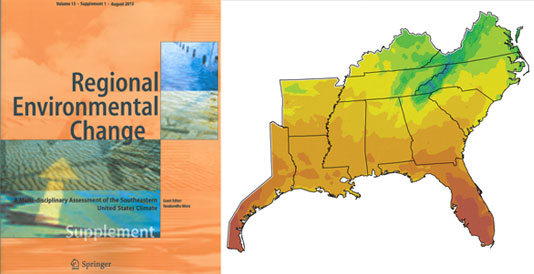 August 15, 2013 - A new special issue in the journal Regional Environmental Change (a Springer publication) entitled "Multi-disciplinary assessment of the Southeastern US climate" is a result of a vibrant interdisciplinary effort by several groups, including the Florida Climate Institute, the Southeast Climate Consortium, and the Florida Water and Climate Alliance. The authors come from a milieu of universities, government agencies and laboratories, and industry spread across the Southeastern US.
August 15, 2013 - A new special issue in the journal Regional Environmental Change (a Springer publication) entitled "Multi-disciplinary assessment of the Southeastern US climate" is a result of a vibrant interdisciplinary effort by several groups, including the Florida Climate Institute, the Southeast Climate Consortium, and the Florida Water and Climate Alliance. The authors come from a milieu of universities, government agencies and laboratories, and industry spread across the Southeastern US. Source: http://fsu.floridaclimateinstitute.org/resources/publications/regional-environmental-change
The special issue may be accessed online at http://link.springer.com/journal/10113/13/1/suppl/page/1

This document provides a brief overview of the observed changes in the climate of the Southeast United States as well as possible future climate conditions as simulated by climate models, based on two scenarios of future greenhouse gas emissions. It summarizes the detailed findings presented in one of nine regional and national climate descriptions created by the National Oceanic and Atmospheric Administration (NOAA) in support of the National Climate Assessment (NCA). It is also hoped that these findings are of direct benefit to decision makers and communities seeking to develop adaptation plans. The full Regional Climate Trends and Scenarios report is available at http://scenarios.globalchange.gov/regions/southeast-and-caribbean.
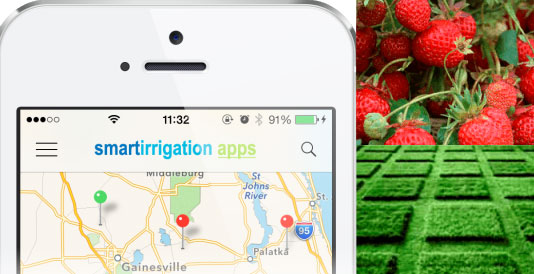 October 16, 2013 - A new project from AgroClimate focuses on the development of Smartphone apps for citrus, cotton, strawberry, and urban lawn to provide real-time and forecasting information that can then be used for more efficient irrigation and water conservation.
October 16, 2013 - A new project from AgroClimate focuses on the development of Smartphone apps for citrus, cotton, strawberry, and urban lawn to provide real-time and forecasting information that can then be used for more efficient irrigation and water conservation.Source: http://smartirrigationapps.org/
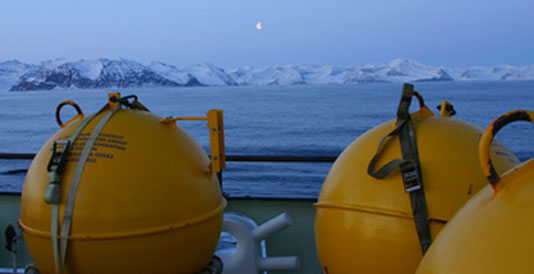 October 18, 2013 - Oceanographers from University of Miami, Duke University, and the Woods Hole Oceanographic Institution have received $16 million in grants from the National Science Foundation to deploy a new observing system in the subpolar region of the North Atlantic. The observing system will measure the ocean’s overturning circulation, a key component of the global climate system.
October 18, 2013 - Oceanographers from University of Miami, Duke University, and the Woods Hole Oceanographic Institution have received $16 million in grants from the National Science Foundation to deploy a new observing system in the subpolar region of the North Atlantic. The observing system will measure the ocean’s overturning circulation, a key component of the global climate system.Source: http://www.rsmas.miami.edu/news-events/press-releases/2013/changes-in-ocean-circulation
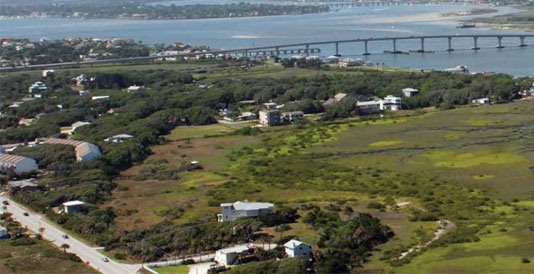 November 12, 2013 - This month’s Landscape Architecture Magazine features the Planning Matanzas project, led by the FCI's Kathryn Frank, in an article titled ”Think or Swim,” by Jonathan Lerner. Lerner attended the project's Spring 2013 professional stakeholder workshops. In his exposition, Lerner does a wonderful job of capturing the unique and vulnerable beauty of the Matanzas Basin as well as the complexity of the planning task at hand.
November 12, 2013 - This month’s Landscape Architecture Magazine features the Planning Matanzas project, led by the FCI's Kathryn Frank, in an article titled ”Think or Swim,” by Jonathan Lerner. Lerner attended the project's Spring 2013 professional stakeholder workshops. In his exposition, Lerner does a wonderful job of capturing the unique and vulnerable beauty of the Matanzas Basin as well as the complexity of the planning task at hand. Source: http://planningmatanzas.org/2013/11/12/project-in-the-news-think-or-swim/
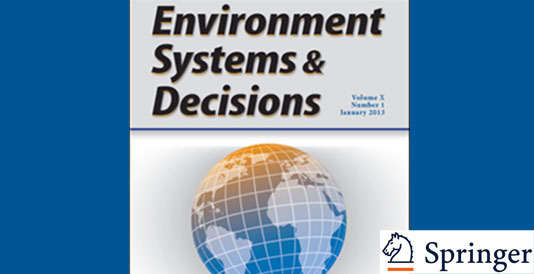 November 12, 2013 - The Editorial Board of the journal Environment, Systems, and Decisions, published by Springer, announces a special Call for Papers addressing the challenges of climate and energy decision-making under uncertainty. Manuscripts are encouraged to be submitted prior to March 1, 2014. The special issue will be co-edited by the FCI's Greg Kiker.
November 12, 2013 - The Editorial Board of the journal Environment, Systems, and Decisions, published by Springer, announces a special Call for Papers addressing the challenges of climate and energy decision-making under uncertainty. Manuscripts are encouraged to be submitted prior to March 1, 2014. The special issue will be co-edited by the FCI's Greg Kiker. Full Announcement (PDF)
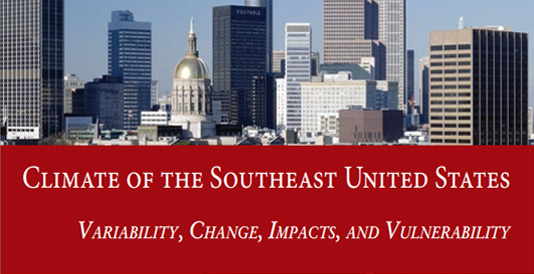 November 13, 2013 - People who live in the southeastern United States should begin to prepare for more drastically changing weather conditions — everything from heat waves to poorer air quality – caused by climate change, according to a new book, edited by a University of Florida researcher. The book, which the FCI's Keith Ingram helped write, is titled “Climate Change of the Southeast United States: Variability, Change, Impacts and Vulnerability.” Ingram was the book’s lead editor.
November 13, 2013 - People who live in the southeastern United States should begin to prepare for more drastically changing weather conditions — everything from heat waves to poorer air quality – caused by climate change, according to a new book, edited by a University of Florida researcher. The book, which the FCI's Keith Ingram helped write, is titled “Climate Change of the Southeast United States: Variability, Change, Impacts and Vulnerability.” Ingram was the book’s lead editor.Source: http://news.ufl.edu/2013/11/13/climate-change-book/
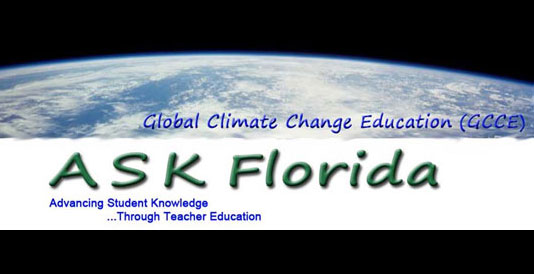 December 18, 2013 - Teaching materials are now available online from a NASA-funded project conducted by the University of South Florida and Florida State University to advance middle-school student knowledge of climate change through teacher education.
December 18, 2013 - Teaching materials are now available online from a NASA-funded project conducted by the University of South Florida and Florida State University to advance middle-school student knowledge of climate change through teacher education. Content and methods were built on current standards and best practice, including K-12 climate literacy standards, national science standards, Florida’s state standards, national PD standards, and content-specific pedagogy, such as inquiry learning and targeting to specific assessment results. The content related local, Florida, and Southeastern U.S. topics to global topics. The major climate change topic areas are Climate Fundamentals, Energy Transfer and Climate, Weather and Climate, Causes of Climate Change, Humans and Climate Change, Hurricanes, Sea Level, and Sinkholes. Effective teaching methods were embedded throughout.
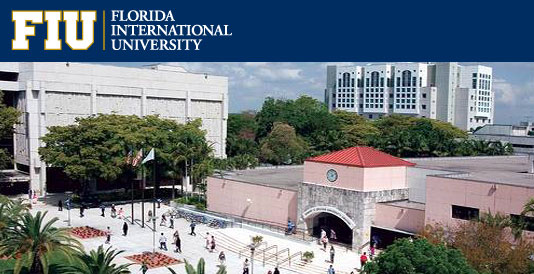 December 19, 2013 - We are pleased to announce that Florida International University (FIU) has joined the FCI! FIU is located in the Greater Miami area and is part of the State University System of Florida. The primary FCI contacts from FIU are Dr. Richard Olson, Director of Extreme Events Research and Professor in the Department of Politics & International Relations, and Dr. Michael Sukop, Associate Professor in the Department of Earth and Environment.
December 19, 2013 - We are pleased to announce that Florida International University (FIU) has joined the FCI! FIU is located in the Greater Miami area and is part of the State University System of Florida. The primary FCI contacts from FIU are Dr. Richard Olson, Director of Extreme Events Research and Professor in the Department of Politics & International Relations, and Dr. Michael Sukop, Associate Professor in the Department of Earth and Environment.
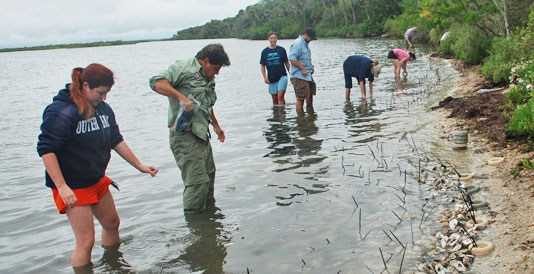 December 19, 2013 - The Southeast Archeological Center (SEAC) of the National Park Service (NPS) has partnered with the Center for Ocean-Atmospheric Prediction Studies (COAPS) at the Florida State University to conduct an assessment of the risks posed by ongoing climate change to cultural resources at national parks in the Southeast. Preliminary studies have identified modern, colonial, and pre-colonial atmospheric and oceanographic data that can be used to assess the risks to irreplaceable cultural resource sites within Canaveral National Seashore and Everglades National Park. At these sites, rising sea level combined with the exposure of the Florida Peninsula to hurricanes are the most prominent risks to cultural resources.
December 19, 2013 - The Southeast Archeological Center (SEAC) of the National Park Service (NPS) has partnered with the Center for Ocean-Atmospheric Prediction Studies (COAPS) at the Florida State University to conduct an assessment of the risks posed by ongoing climate change to cultural resources at national parks in the Southeast. Preliminary studies have identified modern, colonial, and pre-colonial atmospheric and oceanographic data that can be used to assess the risks to irreplaceable cultural resource sites within Canaveral National Seashore and Everglades National Park. At these sites, rising sea level combined with the exposure of the Florida Peninsula to hurricanes are the most prominent risks to cultural resources. A new website provides users access to a wide range of atmospheric and oceanographic data resources. The data will support NPS as they develop strategies for adaptation or mitigation of future climate impacts on cultural resources.
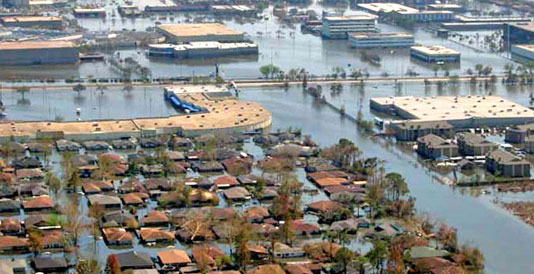 January 23, 2014 - A new paper co-authored by Drs. Thomas Wahl, Francisco Calafat, and Mark Luther and accepted in the Geophysical Research Letters journal finds evidence of rapid changes in seasonal sea level cycles along the US Gulf coast, which in turn increases the risk of hurricane-induced flooding in certain areas.
January 23, 2014 - A new paper co-authored by Drs. Thomas Wahl, Francisco Calafat, and Mark Luther and accepted in the Geophysical Research Letters journal finds evidence of rapid changes in seasonal sea level cycles along the US Gulf coast, which in turn increases the risk of hurricane-induced flooding in certain areas. Geophysical Research Letters Journal Article
Nature News Article
American Geophysical Union Press Release
Tampa Bay Times News Article
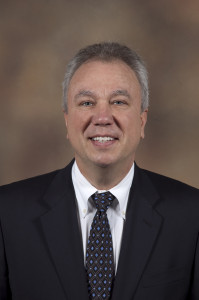 January 29, 2014 - Dr. Scott Hagen, branch director of the Florida Climate Institute at the University of Central Florida, has been elected a fellow of the American Society of Civil Engineers (ASCE). Dr. Hagen is a professor at the University of Central Florida and a member of the Board of Governors for the ASCE Coasts, Oceans, Ports & Rivers Institute. Hagen established and directs the internationally recognized Coastal Hydroscience Analysis, Modeling & Predictive Simulations Laboratory. The primary focus is on massively parallel, high-performance computational modeling of ocean, coastal, and inland shallow water flows. Hagen’s recent efforts expand into transport and biological modeling, particularly with respect to the coastal dynamics of sea-level rise, and are aiding coastal planners around Florida. He also served as guest editor of a focus issue on sea-level rise implications to coastal engineering for the ASCE Journal of Waterway, Port, Coastal, and Ocean Engineering. In 2012 he chaired the 10th International Conference on Hydroscience & Engineering, where he received the Outstanding Achievement Award for Advancement of the State-of-the-Art.
January 29, 2014 - Dr. Scott Hagen, branch director of the Florida Climate Institute at the University of Central Florida, has been elected a fellow of the American Society of Civil Engineers (ASCE). Dr. Hagen is a professor at the University of Central Florida and a member of the Board of Governors for the ASCE Coasts, Oceans, Ports & Rivers Institute. Hagen established and directs the internationally recognized Coastal Hydroscience Analysis, Modeling & Predictive Simulations Laboratory. The primary focus is on massively parallel, high-performance computational modeling of ocean, coastal, and inland shallow water flows. Hagen’s recent efforts expand into transport and biological modeling, particularly with respect to the coastal dynamics of sea-level rise, and are aiding coastal planners around Florida. He also served as guest editor of a focus issue on sea-level rise implications to coastal engineering for the ASCE Journal of Waterway, Port, Coastal, and Ocean Engineering. In 2012 he chaired the 10th International Conference on Hydroscience & Engineering, where he received the Outstanding Achievement Award for Advancement of the State-of-the-Art.
 January 29, 2014 - There are approximately 1 billion biodiversity research specimens in US collections alone, but it is estimated that information from just 10% of them is currently digitized and online. Digitization of the specimens grants researchers access to vast quantities of information in their investigations of timely subjects such as climate change, invasive species, and the extinction crisis.
January 29, 2014 - There are approximately 1 billion biodiversity research specimens in US collections alone, but it is estimated that information from just 10% of them is currently digitized and online. Digitization of the specimens grants researchers access to vast quantities of information in their investigations of timely subjects such as climate change, invasive species, and the extinction crisis. About 20,000 specimen images from Florida State University's Robert K. Godfrey Herbarium and Valdosta State University's Herbarium are currently featured on a new crowdsourcing site called Notes From Nature (http://www.notesfromnature.org/). Notes from Nature is part of the Zooniverse suite of projects (https://www.zooniverse.org/), which have previously focused on astronomy but which has expanded to include climate, humanities, and life sciences research. Another climate-related crowdsourcing project in Zooniverse is the popular Old Weather project (http://www.oldweather.org/).
If you have a moment to check out Notes from Nature and transcribe label data from a few specimens, it'd be great (it's fun!). To learn more about the herbarium at FSU, you can visit herbarium.bio.fsu.edu or read the blog post about the Robert K. Godfrey Herbarium at http://blog.notesfromnature.org/2013/04/28/featured-collection-fsus-robert-k-godfrey-herbarium/. To learn more about the herbarium at Valdosta, you can visit http://ww2.valdosta.edu/~rcarter/herbintro.htm; Richard Carter at Valdosta will post to the Notes from Nature blog soon.
The Director of FSU's Robert K. Godfrey Herbarium, Austin Mast (This email address is being protected from spambots. You need JavaScript enabled to view it.), is a member of the steering committee of Notes from Nature. He would be very pleased to receive constructive comments on the interface.
About Climate Change, Climate Variability, and Florida
To submit a question, please email This email address is being protected from spambots. You need JavaScript enabled to view it..
General |
For Young Scientists |
Climate & Florida |
Sea Level Rise |
Beaches & Coastal Resilience |
Ports & Navigational Channels |
General
What's the difference between weather and climate?
Both weather and climate rely on observations of temperature, pressure, sunlight, clouds, rain, and snow. The main difference between the two is the time scale over which the conditions are described. Weather is generally a snapshot of the atmosphere at a single time or over a few days. Climate generally refers to conditions spanning months, years, and even decades. One way to remember the difference between weather and climate is: Weather tells you what to wear on any given day; climate tells you what wardrobe to own.
What's the difference between global warming, climate change, and climate variability?
"Global warming" refers to an increase in Earth's annually averaged air temperature near the surface. Thermometer readings are collected from many thousands of weather stations around the world—over land and ocean—and then used to produce a global average temperature for each year. The resulting series of annual averages of global temperature from 1880 to 2012 show that Earth has warmed by 1.5°F (0.85°C).[1] Most of that warming has occurred since 1976.
"Climate change" is a broadly inclusive term that refers to a long-term (decades to centuries) change in any of a number of environmental conditions for a given place and time—such as temperature, rainfall, humidity, cloudiness, wind and air circulation patterns, etc. These oscillations and other similar phenomena can influence weather and climate patterns around the globe.
"Climate variability" refers to short-term (weeks to decades) changes in some of these same environmental conditions for a given place and time. Climate variability is often the result of natural oscillations in Earth's climate system — such as the El Niño-Southern Oscillation (ENSO), the North Atlantic Oscillation (NAO), the Pacific-North American Teleconnection Pattern, etc. These oscillations and other similar phenomena can influence weather and climate patterns around the globe.
Source: NOAA Climate.gov Global Warming FAQs
Are humans causing or contributing to global warming?
Yes, human activities have increased the abundance of heat-trapping gases in the atmosphere, which a large majority of climate scientists agree is the main reason for the 1.5°F (0.85°C) rise in average global temperature since 1880. Carbon dioxide is the heat-trapping gas primarily responsible for the rise but methane, nitrous oxide, ozone, and various other very long-lived heat-trapping gases also contribute. Carbon dioxide is of greatest concern because its rate of increase is exerting a larger overall warming influence than all of those other gases combined, and because carbon dioxide levels in the atmosphere will remain elevated for centuries unless we implement a way to remove carbon dioxide from the atmosphere effectively and economically. Most carbon dioxide from human activities is released from burning coal and other fossil fuels. Other human activities, including deforestation, biomass burning, and cement production also produce carbon dioxide.
Source: NOAA Climate.gov Global Warming FAQs
What's the difference between a projection, forecast, prediction, and scenario?
The term "projection" is used in two senses in the climate change literature. In general usage, a projection can be regarded as any description of the future and the pathway leading to it. However, a more specific interpretation has been attached to the term "climate projection" by the IPCC when referring to model-derived estimates of future climate.
When a projection is branded "most likely" it becomes a forecast or prediction. A forecast is often obtained using deterministic models, possibly a set of these, outputs of which can enable some level of confidence to be attached to projections.
A scenario is a coherent, internally consistent and plausible description of a possible future state of the world. It is not a forecast; rather, each scenario is one alternative image of how the future can unfold. A projection may serve as the raw material for a scenario, but scenarios often require additional information (e.g., about baseline conditions). A set of scenarios is often adopted to reflect, as well as possible, the range of uncertainty in projections. Other terms that have been used as synonyms for scenario are "characterisation", "storyline" and "construction".
How can Earth's climate be accurately predicted years or decades in the future when weather cannot be accurately predicted more than 2 weeks from now?
Weather forecasters look at initial conditions and then make short-term deterministic predictions about future events (from minutes to days, to less than 2 weeks). Due to the fluid and chaotic nature of the atmosphere, it is impossible to make accurate deterministic predictions about weather events more than 2 weeks in the future. Climate forecasters look at the state of the key controlling parameters of the climate system and then make long-term probabilistic predictions about future conditions (from more than 2 weeks to years, to decades). People do this all the time with high reliability. For example, while you don't know what the weather will be a like on a given day in Washington, D.C., in the year 2020, you can be confident that temperatures will be warmer in the summer than in the winter.
Another way to understand the differences between deterministic and probabilistic predictions is to consider how other types of experts use them. For example, a doctor may have a hard time determining exactly when a particular overweight, middle-aged person who smokes cigarettes is going to die. But a life insurance agent can easily make a probabilistic prediction of the person's life expectancy based on the average life spans of millions of overweight, middle-aged people who smoked.
Source: NOAA Climate.gov Global Warming FAQs
What is an "extreme event"? Is there evidence that global warming has caused or contributed to any particular extreme event?
An extreme event is a time and place in which weather, climate, or environmental conditions — such as temperature, precipitation, drought, or flooding — rank above a threshold value near the upper or lower ends of the range of historical measurements. Though the threshold is arbitrary, some scientists define extreme events as those that occur in the highest or lowest 5% or 10% of historical measurements.
Human-caused climate change is not the sole cause of any single extreme event. However, changes in the intensity or frequency of extremes may be influenced by human-caused climate change. Heat waves will tend to be a bit hotter— both the daily high and daily low temperatures. And, because a warmer atmosphere holds more water vapor, precipitation events will tend to be heavier (as measured by total rainfall or snowfall). These are just two examples of how extreme events are becoming more extreme.
Establishing causes of a specific extreme event can be difficult and requires case-specific methods. Scientists can assess whether a specific event (e.g., the 2012 U.S. drought, or the storm surge from Superstorm Sandy) has become more or less likely, or stronger or weaker, as a consequence of human-caused climate change. In nineteen recent analyses of twelve extreme events in 2012, scientists found that some events had direct ties to climate change, while others did not.
Source: NOAA Climate.gov Global Warming FAQs
Can we slow or even reverse global warming?
In principle, we can slow the rate of global warming by slowing the emission rates of heat-trapping gases—mainly carbon dioxide—and black carbon aerosol to the atmosphere. Some continued warming is inevitable. Stabilizing global temperature at its current level would be very difficult because it would require cutting the emission of heat-trapping gases all the way to zero. If and when zero emissions becomes possible, temperatures won't start to recover until heat-trapping gases are actually removed from the atmosphere. Such removal happens naturally on time scales ranging from less than a year (e.g., black carbon aerosol) to centuries (e.g., carbon dioxide). Additionally, technical means exist to remove some heat-trapping gases (including carbon dioxide) from the atmosphere.
Ultimately, global warming could be reversed by returning the abundance of heat-trapping gases in the atmosphere to pre-industrial levels (circa 1750). The challenge in slowing or reducing global warming is finding a way to make these changes on a global scale that is technically, economically, socially, and politically viable. Reducing our emission of carbon dioxide has the added benefit of slowing the rate at which humans are making the ocean's water more acidic, which is a threat to shell-forming organisms and the marine food chain.
In response to a request from the U.S. Congress, the U.S. National Academy of Sciences published a series of peer-reviewed reports, titled America's Climate Choices, to provide authoritative analyses to inform and guide responses to climate change across the nation. Relevant to this question, the NAS report titled Limiting the Magnitude of Future Climate Change explains policies that could be adopted to slow or even reverse global warming. The report says, "Meeting internationally discussed targets for limiting atmospheric greenhouse gas concentrations and associated increases in global average temperatures will require a major departure from business as usual in how the world uses and produces energy."
Alternative methods to slow or reduce global warming have been proposed that are, collectively, known as "climate engineering" or "geo-engineering." Some geo-engineering proposals involve cooling Earth's surface by injecting reflective particles into the upper atmosphere to scatter and reflect sunlight back to space. Other proposals involve seeding the oceans with iron to stimulate large-scale phytoplankton blooms, thereby drawing down carbon dioxide out of the atmosphere through photosynthesis. Such methods could work, in principle, but many climate scientists oppose undertaking geo-engineering until we have a much better understanding of the possible side effects. Additionally, there are unresolved legal and ethical issues surrounding geo-engineering.
Given these concerns, the American Meteorological Society published a position paper (readopted in January 2013) in which it said: "...research to date has not determined whether there are large-scale geo-engineering approaches that would produce significant benefits, or whether those benefits would substantially outweigh the detriments. Indeed, geo-engineering must be viewed with caution because manipulating the Earth system has considerable potential to trigger adverse and unpredictable consequences."
Source: NOAA Climate.gov Global Warming FAQs
end faq
For Young Scientists
When did climate change/global warming start? How could scientists tell it was starting?
Man-made or anthropogenic climate change is generally considered to start with the industrial revolution, around the middle of the 19th century (1850). It was at this time that big factories started to flourish, and they needed an energy source to fire the steel mills and provide power. Coal was the big fuel at first and used in the factories, but also to generate electric power once electricity became available. About that time oil was also discovered in Pennsylvania and became another source of energy. All this burning of coal, oil, and natural gas (fossil fuels) increased the concentration of carbon dioxide in the atmosphere over natural levels.
In 1896 Svante Arrhenius, a Swedish scientist, was the first to publish the theory that excess carbon dioxide in the atmosphere will absorb more long wave or infrared radiation, leading to a general warming of the planet.
With the two world wars and most research effort being put into weather prediction, not a lot more was learned about global warming in the first half of the 20th century. In 1958 Charles Keeling began taking very accurate measurements of CO2 in the atmosphere on the top of Mauna Loa in the Hawaiian Islands. This was the first continuous series of accurate measurements of CO2 in the atmosphere. Concentrations were around 315 parts per million (ppm) in 1958, but have risen steadily since then until they are over 400 ppm today.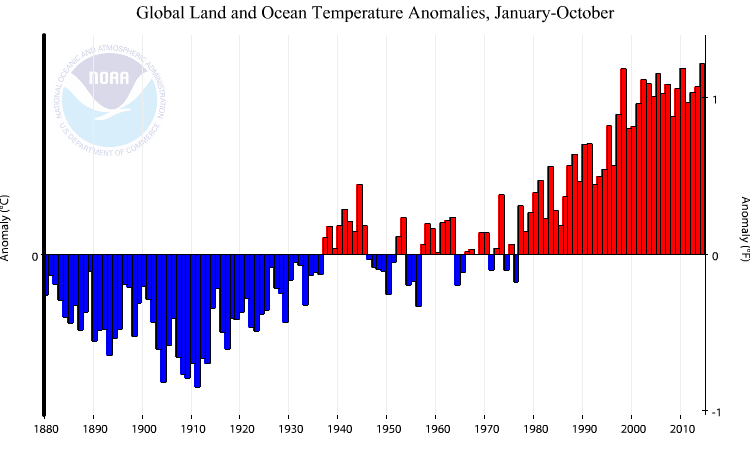
We did not have widespread and accurate temperature measurements around the globe prior to 1850 or so. However, we do have pretty good records since 1900 and they show a corresponding increase in the global average temperature of about 0.8 degrees Celsius, or nearly 2 degrees Fahrenheit. Scientists also see changes in ocean temperatures, snow and ice cover, sea ice, and rising sea levels that all point to a general warming of the planet.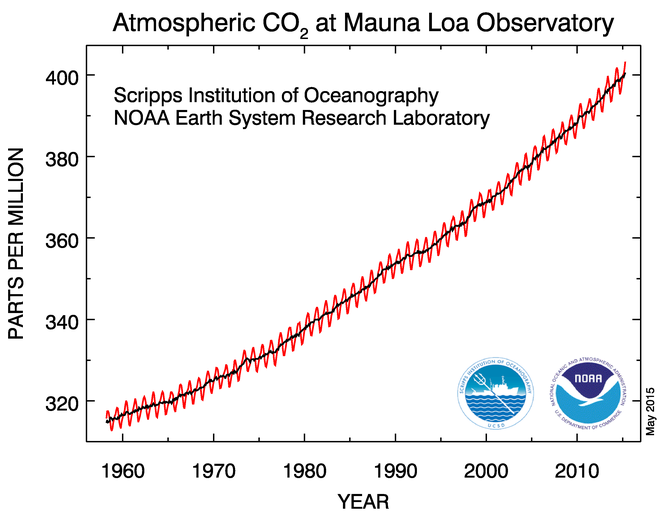
How has the problem changed over the last 10, 5, 2 years?
The short answer is not much. Some countries like the United States and European Union countries have reduced emissions of C02 in recent years (mostly due to the availability of natural gas from fracking in the U.S.), others like China and India continue to increase greatly each year. Even with reduced emissions, we are still putting a bunch of excess C02 in the atmosphere and concentrations continue to rise. Climate science has made substantial advances in the last decade, so we know better how things like the how Arctic and Antarctic ice are reacting, along with changes in heavy rainfall, droughts, and other extreme weather. Still, society as a whole has not made any real strides in stopping or slowing climate change.
With President Obama's support, the EPA has proposed guidelines that will cut CO2 emissions from power plants by 30% by 2030. We have also reached an agreement with China, the world’s largest source of CO2, that they will reach their peak emissions by 2030. This is a great start to the worldwide summit to be held in Paris later this year where each nation will pledge their own cuts.
As for the climate itself, the rate of global warming has slowed since 1998 in what is now known as the "global warming hiatus". Skeptics point to this hiatus as proof that climate change is not that big a deal. Climate science has shown there is around a 30-year cycle in warming and cooling of the planet, and being in the cooling phase of this cycle is what has slowed global warming. Other studies suggest that the deep ocean is absorbing some of the excess heat. Regardless, 9 of the worlds 10 warmest years have occurred since 2000 and most scientists agree that the cycle will return to a more rapid warming soon.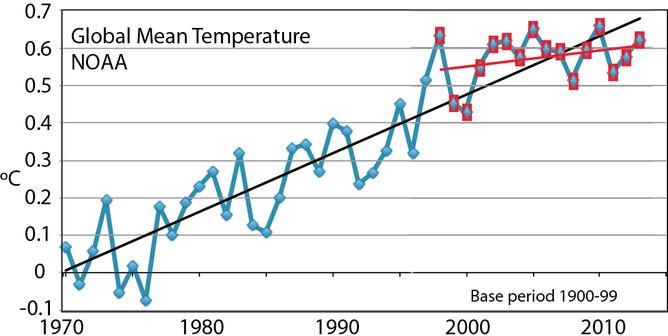
Are there opposing viewpoints about the situation?
On some things the science is very clear and there is nearly universal agreement among scientists. There is no debate that humans have changed the amount of C02 and other greenhouse gasses in the atmosphere. All scientists also agree that the world has been warming over the last century and that the greenhouse gasses play a part. A vast majority of scientists also accept that humans have played the largest role in this warming, but some question if natural variations or cycles are not also a cause.
Where disagreement becomes stronger is in the details, where the science is not as well established and there is considerable uncertainty. Questions like just how sensitive is the climate system to C02? Are extreme events changing and by how much? Will sea level continue to rise at the current rate, or get much higher? How will temperature, rainfall, extreme events change where I live? And the big one, will climate change be slow enough for the planet, plants and animals, and us to easily adapt, or will it be more abrupt and cause major disruptions to society and catastrophic ecological consequences? Will the world be able to change how it uses energy enough to make a difference, and should we? Questions like these are where the real debate lies and science does not give us concrete answers, yet.
Are there any policies or laws in place that are meant to address the issue?
Before we talk about policies, let me explain the difference between adaptation and mitigation. Adaptation refers to how we react to the current and projected changes in climate, how we deal with the reality of climate change. Measures like protecting and relocating coastal communities in the face or rising sea levels or changing farming practices to deal with more heat and variations in rainfall are examples of adaptation. Mitigation means trying to stop or slow climate change by reducing our emissions of greenhouse gases.
On the national level, climate change policies mostly deal with mitigation. The only real policy in place is the EPA's requirement that emissions from power plants be cut by 30% by 2030. President Obama also rolled out his Climate Action Plan in November of 2014, including an agreement with China where we pledge to cut all carbon emissions by 28% by the year 2025. Some say these goals are overly ambitious and will harm the economy and our way of life. Others say they are not enough and will not make much difference in slowing climate change. Either way, many state governments and members of the House of Representatives and the Senate will oppose these measures.
On the State level, Florida's Governor Rick Scott does not view climate change as a pressing issue. He made national news recently for allegedly banning the use of the terms "climate change" and "global warming" in the various State agencies.
In spite of this culture, there is a lot good work going on in the State concerning climate change, mostly from the adaptation side. Florida Department of Transportation factors in rising sea levels in the design of new or upgraded roads and bridges. We are working with the Department of Health to assess how climate and human health and disease are related and how that can change in the future. On the local level, the four Southeast Florida coastal counties have formed the Southeast Florida Regional Climate Compact that follow common standards for upgrading roads, utilities, and other infrastructure as well a community planning and zoning.
How can the average Floridian help reduce climate change/global warming?
There is actually a lot that the average citizen can do to reduce their contribution to carbon dioxide emissions and climate change. The first thing is to conserve energy... do everything you can to make your home more energy efficient, use heating air conditioning, hot water less, try to take fewer trips in the car or combine trips and own a fuel efficient vehicle. Other bigger steps are to install solar energy panels on your home to help provide electricity and heat water. Another overlooked step that also has beneficial health impacts is to eat less meat. Beef, poultry, pork, etc. take much more energy to raise than vegetable crops, especially since grains and grasses that feed the animals have to be grown also, which takes energy.
Will climate change ever bring benefit to some areas?
This may be the best question of the bunch. Some agricultural areas will likely see benefits from longer growing seasons, more rainfall, and even more CO2 in the atmosphere can benefit some crops as plants use it for photosynthesis. With human health, far more people die worldwide from extreme cold than from heat waves. A shift towards a warmer planet may actually prevent some deaths. These are just some examples, I am sure there are many more. Too often the news media and even climate research itself focuses on the negatives of climate change, disregarding the possible positive outcomes.
Could climate change/global warming ever wipe us out?
No, not in our lifetime anyway and its very unlikely that it would in your future children's or grandchildren's lifetime either. Human civilization faces a whole host of challenges and stressors going forward the next several hundred years and climate change is only one of them. Ever increasing population, degradation of the environment, clean water supply, availability and security of food, availability of energy, unstable global economy, war and terrorism, disease and antibiotic resistant bacteria are all very serious concerns that could have a great impact on human society. And all of these threats are interrelated, influencing the others. Climate change could very well make many or all of these problems worse, but they will still be problems with or without the influence of climate change.
Many scientists also believe that the earth/ocean/atmosphere/ice system wants to find a balance, and that it will adjust to the excess greenhouse gasses without too drastic a change. Others believe there may be a "tipping point", where too high a concentration of greenhouse gasses will lead to runaway warming. That being said, the most sophisticated computer climate models around the world predict various degrees of warming by the end of this century, but none of them predict runaway climate change.
Also keep in mind that the earth's climate has seen more drastic changes in its history than what is occurring now from global warming. During one prehistoric period the earth was completely frozen and covered in ice, in others the poles were ice-free and the ocean warm near the North Pole. Most recently, we came out of the last ice age about 12,000 years ago and humans survived through it. Due to subtle changes in the earth's orbit and tilt, we will likely enter another ice age sometime in the next 10,000 years.
Enough doom and gloom...human beings are the most adaptable creatures this world has ever seen and we have great potential to solve and deal with problems through technology and working together towards the common good. Sooner or later this will be the case with our energy use and climate change.
end faq
Climate & Florida
How much has the temperature of Florida and the southeastern U.S.A. risen over the last century?
The southeastern U.S.A., including northern and central Florida, is one region of the globe that has not experienced any appreciable warming from greenhouse gases. Our historic data records show that the climate of the Southeast was characterized by relatively warm decades in the 1920's, 1930's, and 1950's and cooler decades in the 1960's through 1980's. In northern Alabama and northern Georgia, some of the hottest years on record and many daily heat records occurred in the 1930's.
In Florida, the greatest impact that man has had on climate is through changing the land surface. Temperatures have risen along the southeastern Florida coast by over 1°F in the last 40 years, especially in the summer months. Much of this can be attributed to urban development, where cities built of concrete and asphalt now absorb and hold more heat than the natural environment they replaced. Similar trends are observed in other urbanized areas, such as Jacksonville, Tampa, Orlando, and the I-4 corridor. Other changes to the land surface have also impacted the local climate, such as the draining of vast wetlands and their conversion to sugar cane fields around Belle Glade on the south shore of Lake Okeechobee.
Will temperatures rise in the coming decades?
It is difficult to determine if the Southeast will continue to lag behind the rest of the globe with respect to rising temperatures. While global climate models have some skill at predicting changes to the global average temperature, they have a much harder time predicting regional or local changes. Our geography and proximity to the Gulf of Mexico and Atlantic Ocean suggests that temperature changes will be less here in Florida than in other parts of North America.
Have we seen an increase in the number or strength of hurricanes?
Perhaps the greatest weather- and climate-related risk to people and property in Florida is hurricanes. The IPCC report states there is a "low confidence" (less than 20%) that we have seen a human-caused increase in intense hurricanes, which is even less confident than the 2007 assessment. Influencing this conclusion is a widely cited 2010 review paper published by ten of the leading hurricane experts, "Tropical Cyclones and Climate Change." These authors found there was no significant increase in landfalling storms and that it is uncertain whether the changes observed in past hurricane activity were outside the variability expected from natural causes.
Will hurricanes become stronger or more frequent in the future?
The IPCC report states that it is more likely than not (greater than 50% confidence) that there will be a human caused increase in intense hurricanes by 2100 in some regions. This is less confidence than in the 2007 assessment (66%). Common sense would dictate that warmer ocean temperatures would lead to more strong storms, but reality is not that simple. In addition to the heat and moisture from the oceans surface that is needed to feed hurricanes, there also needs to be a favorable atmospheric environment with moist air and little wind shear. It is unclear from the climate models how these environment factors may change in the future. A recent study from Kerry Emanuel at MIT using global climate model output driving a high-resolution hurricane model indicates that intense hurricanes will increase by 2100. Another study using similar methods by a different model showed a decrease. Bottom line, there is more uncertainty than is known about how climate change will affect the number of strong hurricanes.
Has Florida seen changes in precipitation?
Here in Florida, the climate is subject to both drought and heavy precipitation. Because of the nature of our summer convective rainy season and the influence of El Niño/La Niña cycle, the year-to-year variability of rainfall overwhelms other trends or patterns. Florida will continue to be vulnerable to drought, especially when seasonal dryness in winter and spring extends into the summer. Florida is also subject to heavy precipitation events, whether from tropical systems, mid-latitude lows and fronts that tap the Gulf Moisture, or slow-moving summer thunderstorms.
While there has been no trend over the last century in annual rainfall in Florida, there has been a subtle change in the seasonal distribution. The month of May is 10% to 40% drier since 1990 than in the decades earlier. This means that while we still average the same amount of rainfall during the summer, the season has been shortened to some extent. Whether this is the result of climate change, natural variability, or pure random chance is not known at this time.
How will precipitation patterns change in the future?
As difficult as it is to make a definitive statement about changing precipitation patterns in the past, projections of the future are even more uncertain. Global climate models lack the resolution (size of the grid used for calculations) to represent local and regional processes important to rainfall such as the afternoon seabreeze. Because of limited physics of cloud and rainfall formation, even when downscaled, these models struggle to accurately represent the correct day-to-day variations of rainfall, diurnal cycle, or even the seasonal cycle.
Will extremes in rainfall become more common?
The underlying theory is that as the atmosphere warms, it can hold more moisture and that will lead to more extreme rainfall events. Conversely, warmer temperatures will cause greater evapotranspiration rates leading to more periods of drought. In short, we could be looking at both more drought and extreme rainfall events in a warming climate. However, the IPCC report only gives "low confidence" (20% chance) that we have already observed a human-cause change in the intensity or frequency of drought, less than the 50% confidence in the 2007 report. The report also states it is likely that the frequency of heavy rain events has increased in some regions, including North America.
Is Florida experiencing more extreme temperatures?
The IPCC 5th Assessment Report states that the earth is already seeing an increase in the number of hot days and a decrease in the number of cold days. "Changes in many extreme weather and climate events have been observed since about 1950. It is very likely that the number of cold days and nights have decreased and the number of warm days and nights has increased on the global scale." Again, this statement may be true for many regions and for the globe as a whole, but Florida is not following suit.
Historical temperature records from many parts of the State actually show more 95-degree days in the 1930's and 1950’s than we are experiencing today. Likewise, more freezing days have occured the 1980's. Florida experienced a string of devastating freezes from 1977 through 1989, and the winter of 2010 as a whole (January - March) was the coldest on record.
According to the Fifth National Climate Assessment, the number of very warm nights (when nighttime temperatures stay above 75ºF) has been increasing across the Southeast U.S. particularly in the last two decades. The number of very warm nights during the first part of the 21st century has nearly doubled when compared to the occurrence of very warm nights in the mid-20th century (1930–1954). This trend is projected to intensify, with some areas experiencing more than 100 additional warm nights per year by the end of the century.
How will climate change affect Tallahassee and the Big Bend region of Florida?
While Tallahassee is more sheltered from some of the direct impacts of a changing climate relative to other parts of Florida, such as coastal flooding from sea level rise and storm surge, this city and region are vulnerable to a range of anticipated impacts. Northern Florida, like most areas of the Southeast U.S., is expected to see more extreme temperatures with extreme heat becoming more common. The Southeast U.S. is expected to continue seeing more extreme precipitation events (more heavy downpours). Tallahassee and all of Florida remain vulnerable to changes in tropical cyclone activity due to climate change, such as increased storm intensity and more extreme flooding associated with these storms. Some examples of how certain sectors will be impacted by climate change in this region include:
- Agriculture – Increased heat is expected to result in elevated soil temperatures, heat-related illness for outdoor workers, and cumulative stress on livestock. However, there may be fewer freeze events and freeze-related crop damages, though these could still occur. Wind and flooding from tropical cyclones will remain a threat to agriculture. For example, Hurricane Michael in 2018 maintained its strength and structure well inland and led to catastrophic damages to tomatoes in Gadsden County, as well as to pecans and timber in north Florida and Georgia.
- Infrastructure – More extreme precipitation events will increase the risk of flash flooding and increasingly test aging infrastructure. Drainage systems not built to accommodate greater amounts of heavy rainfall will be overwhelmed during heavy downpours and this will likely contribute to greater flash flooding. As the rate of sea level rise accelerates, drainage of surface and ground water to the coast will become less efficient, which means floodwaters that are unable to drain quickly could stick around longer.
- Water quality – Wakulla Springs and other waterways are vulnerable to sea level rise and groundwater intrusion, which can cause a reversal of spring flows. With ongoing sea level rise, the normal transport of water from the springs to the coast does not function properly and becomes backed up at critical outflow points. This can contribute to poorer water quality in springs.
- Public health – While southern Florida will be particularly susceptible to the health impacts of extreme heat, north Florida will also see more days above 95 degrees F and increases in the summer heat index due to higher humidity levels. The Tallahassee area is also projected to see more warm nights (with minimum temperatures > 75 degrees F). Currently, the area experiences an average of about 10 - 20 warm nights per year, but this is expected to increase to 30 – 50 nights per year under a lower emissions scenario (RCP4.5) to as much as 50 – 75 nights per year under a high scenario (RCP8.5). Lack of nighttime relief from excessive heat will also have adverse public health impacts.
- Coastal-Inland impacts - At the Apalachicola tide gauge station, local relative sea level rise trends are 2.57 mm/year, which is equivalent to a change of 0.84 feet in 100 years. Local relative sea level rise is projected to be an additional 0.4 m (1.3 feet) in a low emissions scenario to 2.5 m (8.2 feet) in a high emissions scenario by the year 2100. While Tallahassee is not coastal, coastal flooding will impact areas further inland as described above. Also, with its inland location and higher elevation, Tallahassee could become a “receiving community” as more people relocate from high risk coastal areas across the state. Understanding these future population shifts and demographic trends is necessary so that cities like Tallahassee can plan for this type of future growth.
end faq
Sea Level Rise
How has sea level rise affected Florida’s coasts?
With hundreds of miles of low-lying coasts, Florida is highly vulnerable to rising sea level as a result of the changing climate. Miami-Dade is considered one of the most at-risk locations in the country and has teamed up with three other counties to form the Southeast Florida Regional Climate Change Compact to assess the risk of rising sea levels and make planning and policy decisions on how to react. Even a modest amount of sea level rise there will cause tremendous problems with water storage, stormwater, and saltwater intrusion into the Biscayne Aquifer.
The latest IPCC report states that global sea level has risen 19 cm (7.5 inches) between 1901 and 2012 and that the rate has accelerated to a rate of 3.2 cm/decade in the last 20 years, matching tide gauge and satellite observations.
Local sea level rise can be either higher or lower than the global average due to differences in prevailing winds and ocean currents and underlying geologic processes such as crustal rebound. Florida is fairly stable, geologically speaking, and measurements from tide gauges on both coasts are in line with the global values, perhaps rising at a slightly lower rate. Tide gauge records from Key West and Mayport (near Jacksonville) show a very steady rate of sea level rise at a little over 2 mm per year (2 cm/decade).
How much will the sea level rise in the next century?
The 2013 IPCC report projects that global sea level will rise another 26 to 98 cm by 2100. This represents a modest increase from the 2007 projections. There is also a chance that sea level could rise an even greater amount than the higher limit, but higher estimates were not included due the primitive understanding of glacier and ice sheet dynamics and their potential rate of melt. There are a number of new studies predicting an even greater rate of sea level rise whose results were not included in the IPCC report.
What are the economic effects of sea level rise, and what are our response options?
The costs of sea level rise in Florida remain challenging to calculate. An analysis by The Nature Conservancy estimated that $26.7 billion of property value in the Florida Keys alone could be inundated with only 1 meter of sea level rise. Due to current tidal flooding problems, some local Florida governments have begun to respond. To date, most activity has been limited to general comprehensive plan language related to sea level rise. However, some local governments have begun to implement responses to sea level rise. For example, Miami Beach has incorporated 20 years of predicted sea level rise into a current project for stormwater upgrades, and has the flexibility to adjust to longer predictions for more sea level rise.
Florida can expect dramatically increased costs for stormwater drainage and other types of infrastructure as sea levels—and associated tide and storm-surge levels—increase and damage infrastructure. However, Florida communities are not all starting from scratch. Communities can improve on a strong existing foundation of hurricane resilience and become more capable of coping with sea level rise.
Where can I find out about potential local impacts of sea level rise?
Sea level rise is occurring globally across coastal areas, but how much occurs at any given place can vary due to rising or falling of the land as well as dominant winds and currents or other factors. Sea levels are measured both by tide gages and by satellites. Local sea level rise is usually calculated by reference to a nearby tide gage. Sea level trends for Florida tide stations are available at from the National Oceanic & Atmospheric Administration’s Tides & Currents webpage.
Typically the local impacts of sea level rise are determined as part of a local “vulnerability assessment.” Depending on the resources available at the local level to conduct a vulnerability assessment, the resulting information may be very general or very detailed. To help understand potential local inundation, the National Oceanic & Atmospheric Administration developed the Sea Level Rise and Coastal Flooding Impacts Viewer, which can be used to help visualize potential flooding scenarios based on varying levels of sea level rise.
What are the planning options for adapting to sea level rise?
Responses to sea level rise break down into three general categories of activities: 1) protection, 2) accommodation, and 3) relocation/avoidance. “Hard” protections such as sea walls and bulkheads have historically been the approach to control flooding or sea level rise. However, their extensive use limits sand for beaches and sediment for coastal marshes and the ability for the coasts to naturally accrete and counteract sea level rise. This has led to increased use of “soft” armoring approaches, such as beach nourishment and creation of “living shorelines” that can help protect coast lines and retain their ability to accrete and provide coastal fisheries habitats.
Accommodation means learning to live with the impacts of increased sea levels for as long as possible, meaning that for some regions, this is really just delayed “relocation.” Adaptation can be either passive, such as by letting a flooded area become a new coastal wetland, or active, such as by reengineering drainage infrastructure to prevent the worst of the flooding.
Relocation/avoidance means moving at-risk people and infrastructure further away from the risk. While this is often the least popular potential response, it can be the safest and most permanent solution. In all but the most straightforward situations, a mix of protection, accommodation and relocation strategies may be required to accomplish the goal of maintaining a viable coastal community.
end faq
Beaches & Coastal Resilience
How is climate change currently affecting coastal infrastructure?
Sea level rise is currently the most obvious aspect of climate change affecting Florida’s infrastructure. We can see the effects of rising seas in the “king tides” in the southeast part of the state, which flood canals, streets, homes, and businesses twice a day for several days a few times a year. During a king tide, the normal high tide is bigger because of the way that the sun, moon, and Earth are aligned. For the past few years, people have been noticing that sea level rise is making these king tides even higher. Sea level rise is also making flooding worse during storms, especially when storms occur during high tide. In response, communities have spent millions of dollars on pumps and flood-control structures.
Rising sea levels are also causing beach erosion and shoreline changes that affect coastal buildings and roads, particularly during storms. While these effects are most pronounced in coastal areas, Florida’s relative flatness also means that flood waters can reach far inland and groundwater levels are raised, limiting storm water storage capacity during high rainfall events. The types of infrastructure that are often affected by storm surge include roads, homes, power lines, canal structures, sewer systems and sewage treatment plants, businesses, power plants, and drinking water pumping facilities. Finally, saltwater is percolating further inland through limestone bedrock each year, creating problems for pumping fresh water for drinking and agriculture.
What tools are there to help communities assess risk to coastal infrastructure?
The best tools for communities to assess risk to their infrastructure will vary depending on the community. Larger communities often have extensive staff resources and databases of information that will allow development of detailed vulnerability analyses for different types of infrastructure. Communities with fewer resources may benefit from many tools available on the internet. For example, NOAA’s Coastal Snapshots includes critical facilities in floodplains (note that floodplains do not correspond to storm surge zones). This can be combined with NOAA’s Critical Facilities Flood Exposure Tool. The vulnerability of transportation infrastructure to sea level rise can be assessed locally by use of the Florida Sea Level Scenario Sketch Planning Tool.
Part of assessing vulnerability is assessing the future state of the oceans and climate. For example, does your community have critical infrastructure located in a coastal floodplain? How will the floodplain change if sea level rises one foot, or two feet? An increasing number of resources are available to local governments from reputable sources such as the National Academy of Sciences, the U.S. Geological Survey, the National Oceanic & Atmospheric Administration, and the United States Global Change Research Program. These resources allow local stakeholders to determine the scenarios for which they will assess their vulnerability.
What will the effects of climate change on Florida's fisheries be?
Between 2002 and 2012, Florida’s saltwater and freshwater commercial fisheries landings totaled approximately 500,000 metric tons of fish with an income to the State of over 2 billion dollars. Florida was ranked the highest state in income from recreational fishermen’s purchases, with the greatest employment associated with fishing as a recreational sport- 32-66 thousand jobs in 2011. Florida’s importance as one of the “fishing capitals” of the country is inextricably linked to a healthy coastal environment, including nursery grounds for larval and juvenile fish and shellfish- marshes, mangrove, seagrasses, and coral reefs. Warming average water temperatures, greater temperature and rainfall extremes, rising sea level, and other projected environmental changes will make Florida’s natural environment, the factory that makes the fish that underpin the fisheries, less stable.
Climate change can affect marine organisms directly and indirectly. For example, the direct effects of higher temperature cause stress in many marine organisms, particularly those that currently live at their limits of high temperature tolerance (such as corals on reefs). Indirect effects on fisheries have to do with the relationship between oxygen and temperature. As ocean and coastal temperatures rise, water’s capacity to hold oxygen decreases. This hypoxia (low oxygen) can increase the rate of fish “die-offs” or fish kills in coastal zones, and limit how fast open ocean fish can move and find habitat with enough oxygen. In coastal areas, sea level rise can reduce the area of fish habitat, particularly for species that require nursery areas in coastal marshes, mangroves, and other fringing habitats. More research needs to be done to determine how individual areas will respond to sea level rise. For example, if a particular marsh can’t expand inland, it may be lost as a nursery habitat for fish.
What is ocean acidification, and how is it affecting Florida's species?
Ocean acidification is referred to as the “other CO2 problem”. Seawater soaks up much of the CO2 (carbon dioxide) released when fossil fuels are burned. As carbon dioxide is absorbed, a chemical change increases the acidity of seawater. This has negative consequences for corals, shellfish and other marine life that use carbon to form their skeletons or shells. For example, oyster shells become more brittle and fragile, and coral reefs grow more slowly and can’t compete with weedy algae.
While more research needs to be done on this and other possible consequences of ocean acidification, we know from Florida and elsewhere that coral reefs are already under stress. The rate of ocean acidification is happening more quickly than it has in thousands of years. Recent research suggests there will be “winners and losers.” Coral reefs and calcifying plankton in the open ocean are likely to be the “losers,” and non-armored plankton in the open ocean and algae-dominated reefs the “winners”. This will mean big changes for ocean food webs.
More...
About 30% of the fossil fuel carbon that has been produced since the industrial revolution (~530 tons) has been absorbed by the world’s oceans. This has caused the oceans to acidify or increase their concentration of hydrogen ions by about 30% (a pH drop from 8.2 to 8.1 units). While the most obvious effect of acidification is the inhibition of marine organisms from creating their calcified (hard) shells, changing the pH can have other consequences. pH affects how sound moves in the ocean, which can create problems for both whales and dolphins, as submarines that navigate using sonar. A lower pH can also make it harder for fast-swimming fish to absorb enough oxygen through their gills. With more carbon in the water, algae may be able to grow more quickly, making harmful algal blooms or “red tides” last longer or happen more often.
Some corals appear to be able to tolerate modest levels of low pH, while other species are highly sensitive. Although this provides some hope, natural cold water vents in the Mediterranean and in Papua New Guinea show very few calcifying organisms present and reefs primarily dominated by fleshy algae and seagrasses. Many questions remain about how fundamental changes in the base of marine food webs and habitats affected by acidification will cascade through ecosystems to fisheries and other marine ecosystem services that humans value.
end faq
Are natural areas and native species on Florida’s coasts threatened by sea level rise and increasingly intense storm surges?
Florida’s natural areas and built environments are susceptible to the negative effects of sea level rise and storm surge. Although Florida’s species and ecosystems have adapted and adjusted their distributions in response to sea level fluctuations for millions of years, today human land use, especially urbanization, makes such adjustment much more challenging, because many movement routes are blocked. Also, the sea levels are now rising faster than they have for many thousands of years.
More...
Florida is extremely susceptible to the effects of sea level rise due to a combination of low land elevations, a high water table, peninsular geography, vulnerability to tropical storms, and a large and growing human population that is largely concentrated near the coasts. Coastal ecosystems in Florida, such as salt marshes and mangrove swamps, have been responding to fluctuations in sea level for millions of years, moving landward when sea level rises and moving seaward when sea level drops. Probably some species went extinct during these fluctuations, and geological evidence shows that coastal ecosystems were sometimes “drowned in place” during periods of rapid sea level rise, such as when the glaciers melted after the last ice age. Nevertheless, these ecosystems generally recovered over time, and extinctions of species were probably rare. The exceptions were likely those species that existed only on islands (such as the Key deer does today), which would have been eliminated when rising sea level inundated the islands.
Today, however, coastal ecosystems and species on both islands and the mainland are trapped by coastal and near-coastal development. Urban areas, highways, sea walls, and other human structures along much of Florida’s coast prevent species and habitats from moving landward as the sea rises. Also, the rapid sea level rise may prevent some species from moving landward even if habitats exist because of their slow movements or inability to increase elevations at the rate of sea level rise, such as coastal wetlands. Thus, some ecosystems and species may not be able to keep up with sea level rise, even on undeveloped coastlines.
end faq
Are some species and ecosystems in Florida more threatened by sea level rise and storm surge than others?
Vulnerability to sea level rise and storm surge varies tremendously among species in Florida. Species and natural communities whose distributions are only on islands and low coastal areas, who are intolerant of salt water, and who do not have access to pathways to higher ground are most at risk.
More...
Yes, some species and ecosystems are much more vulnerable to sea level rise and storm surge than others. Species obviously at greatest risk are those whose entire known ranges are in low-lying coastal areas that are projected to be inundated by rising sea level within the next few decades or so. For example, species that inhabit (or nest on) beaches, dunes, coastal grasslands, salt marshes, mangroves, and low-lying forests near the coast are highly vulnerable. These species are especially at risk if no natural movement corridors to higher ground exist (which is the case for island species) or if natural movement routes are now blocked by human development.
Factors other than location, however, affect the vulnerability of species to sea level rise and storm surge. One factor that determines vulnerability, other than location, is the ability to move. A bird, bat, or flying insect has a chance of potentially moving landward as sea level rises, and perhaps flying above coastal development and colonizing new habitat on the other side. Plants with wind-dispersed seeds, or seeds dispersed by flying animals, may also have a chance to escape the rising sea. More sedentary or flightless animals and plants are not so fortunate.
Species also differ in their sensitivity to environmental change. For example, as the sea rises, ground water becomes more salty. Salt spray from storms also directly affects many plants and animals. A species that is more tolerant of high salinity will be much more likely to survive than less tolerant species entirely dependent on fresh water. The level of genetic diversity within and among populations of species will also affect their ability to adapt – the more genetic diversity, the more likely that some individuals have the right genes to move more rapidly or tolerate higher salinity, for instance. Species with shorter generation times are also more likely to evolve favorably in response to sea level rise and other environmental changes.
end faq
Are some stretches of Florida’s natural coastline more vulnerable than others? Which natural regions are most vulnerable, and which have more opportunities to adapt?
Islands and low-lying coastal natural areas bordered by urban development are most vulnerable to sea level rise and storm surge. The Florida Keys and many barrier islands are particularly at risk. Largely undeveloped mainland coastlines, such as much of the Everglades and the “Big Bend” of the Gulf Coast provide more opportunities for species and natural communities to shift their ranges landward.
More...
Yes, some species and ecosystems are much more vulnerable to sea level rise and storm surge than others. Species obviously at greatest risk are those whose entire known ranges are in low-lying coastal areas that are projected to be inundated by rising sea level within the next few decades or so. For example, species that inhabit (or nest on) beaches, dunes, coastal grasslands, salt marshes, mangroves, and low-lying forests near the coast are highly vulnerable. These species are especially at risk if no natural movement corridors to higher ground exist (which is the case for island species) or if natural movement routes are now blocked by human development.
Generally speaking, the most vulnerable natural areas are islands, such as the Florida Keys and our many barrier islands. Low-lying islands farther from the mainland, such as the Lower Keys, are most vulnerable to sea level rise and increasing storm surge. Other vulnerable areas include coastal habitats that are bordered on the landward side by human development. This includes most of the southeastern coast of Florida, much of the Gulf Coast from around New Port Richey to Naples, and the developed coasts of the Panhandle.
The coastal regions with the greatest natural adaptation potential are those with the least human development, because this means coastal ecosystems can move inland without being blocked by roads and buildings. For example, the Everglades, Big Cypress, and Ten Thousand Islands region of SW Florida has considerable opportunities to adapt. The “Big Bend” coast, approximately from Chassahowitzka National Wildlife Refuge northward to St. Marks National Wildlife Refuge, also has little human development. In fact, in these and other undeveloped stretches of coastline in Florida, there is abundant evidence of salt marsh plants and mangroves moving landward over the last few decades in response to rising sea level. Encouraging this adaptive response would improve ecosystem resilience. Historical evidence shows that mangrove surface elevations have kept pace with sea level rise over thousands of years in some areas, with the key factors being external sediment inputs (i.e., rivers supplying sediment to estuaries) and the growth of subsurface roots. Unfortunately, some studies suggest that the present or near-future rate of sea level rise is too high for these species to respond adaptively by trapping sediment and building the ground surface or by moving landward, so the rate of sea level rise is critical.
end faq
How can we help conserve coastal species and ecosystems in the face of sea level rise and increasingly intense storms?
The most useful things we can do to help Florida’s species and ecosystems persist in the face of sea level rise and increasingly intense storms are to focus coastal development into the least vulnerable areas, protect existing natural areas, take care of natural resources, and protect or restore corridors from coastal natural areas to suitable habitat at higher elevations wherever possible. Other options include moving coastal populations of plants and animals to suitable inland areas and maintaining populations in zoos and botanical gardens.
More...
There are many things we can do to reduce the risks from sea level rise and storm surge to Florida’s species and ecosystems. The protection, creation, and restoration of coastal ecosystems is a form of “ecological engineering,” which reduces impacts of sea level rise and storm surge without the destructive impacts of traditional engineering approaches such as sea walls, dikes, revetments, and bulkheads.
For individual species, we must first understand that each species will respond somewhat differently to climate change. Options include:
- Protecting and managing existing habitat for as long as possible, including natural coastal vegetation and ecosystems (coral reefs, oyster reefs, salt marshes, mangroves).
- Protecting and managing projected future habitat. This option is appropriate for species for which landward “migration” of their habitat is possible as the sea rises, or where potentially suitable habitat exists at inland locations on the other side of a barrier.
- Protecting and managing existing habitat corridors to provide for projected future habitat. This option can be pursued jointly with Option 2 in cases where a natural corridor links current habitat with projected future habitat.
- Restoring or creating corridors to recipient habitat (including wildlife crossings/ecopassages under roads).
- Providing assisted colonization (managed relocation) to recipient habitat. This involves physically moving and relocating coastal animals and plants to suitable habitat at higher elevations not expected to be impacted by sea level rise and storm surge for a long time. This approach must be carefully managed to minimize any unintended consequences on the receiver site.
- Providing conservation in zoos, botanical gardens, seed and gene banks. When none of Options 1 through 5 are appropriate or likely to succeed, or as an insurance action even if some other options may succeed, then Option 6 may be necessary. For most island endemics (found only on particular islands) in low-lying habitats, long-term captivity or preservation of seeds or tissues in seed or gene banks is the only potential alternative to extinction.
end faq
Will protecting coastal ecosystems benefit people? How can we maintain or enhance these benefits?
Natural ecosystems provide many kinds of services and values to humans. One critical function of coastal ecosystems is to buffer human communities and agricultural areas from the impacts of sea level rise and storm surge. Salt marshes and mangroves, for example, trap sediments and raise the land surface, keeping pace with modest rates of sea level rise. Oyster reefs, coral reefs, and even seagrass beds, slow the speed of approaching waves and reduce coastal damage. Coastal ecosystems also provide other direct economic benefits, for example to fisheries and ecotourism.
We can maintain and enhance these benefits by protecting these ecosystems and limiting coastal development to the least vulnerable areas. In some cases, sea level rise may cause communities to abandon very low lying areas. If these situations occur, coastal areas should be restored and managed for natural habitat and potential human recreation. Studies show that restoration of coastal ecosystems has huge economic benefits.
More...
By trapping sediments and growing vertically, coastal wetlands and nearshore marine communities reduce wave action from tides and storms, which reduces erosion and flooding of adjacent uplands. Mangroves, salt marshes, seagrass beds, coral reefs, and oyster reefs all serve this function, as do dunes and other coastal uplands. Maintaining and restoring these ecosystems between human communities and the sea will therefore reduce threats to human communities until the rate and depth of sea level rise exceeds their capacity to trap sediments and migrate landward. It is not certain when this threshold of adaptive potential will be reached, but it probably will not occur for several decades, which gives human communities time to devise and implement protection, accommodation and/or relocation strategies.
There are additional critical reasons for maintaining and restoring marine, estuarine, and coastal upland natural communities. One of these is ecosystem services. Coastal wetlands could be marketed for their tremendous capacity to store and retain carbon as carbon “banks.” Salt marsh, seagrass, and mangrove ecosystems account for nearly half of the total carbon burial in ocean sediments. These “blue carbon” ecosystems play a substantial role in mitigating global warming. Additional direct economic benefits of these ecosystems for humans include improvements in water quality, fisheries production, and recreation and tourism. Because tourism is Florida’s leading economic sector, maintaining healthy coastal ecosystems is a high priority for maintaining economic vitality.
An example of a coastal natural community with high ecotourism value is the coastal marshes and mangroves. The mangrove bird assemblage in Florida is unique in the United States and includes the Black-whiskered Vireo, Florida Prairie warbler, Cuban Yellow Warbler, Mangrove Cuckoo, White-crowned Pigeon, Mangrove Clapper Rail, Great White Heron, plus more widespread species such as the Black-crowned and Yellow-crowned High-Heron, Roseate Spoonbill, and many other wading birds. Besides the intrinsic and scientific value of this avian assemblage, it contributes to Florida’s economy through ecotourism.
An obvious first step in protecting both human and natural communities in coastal areas from sea level rise and storm surge is to avoid putting more people and infrastructure in harm’s way by accounting for coastal hazards in land use and other regulations. Keeping coastal natural communities in healthy condition by reducing other stressors, like pollution runoff, is another key recommendation, as is restoring damaged coastal zones. Studies show that restoration of coastal ecosystems directly benefits the economy. A 2014 report showed that fully funding Louisiana’s Coastal Master Plan could create between 109,000 and 212,000 jobs and provide at least $757 million in new yearly revenue for the state and local governments. The 50-year plan would cost between $50 billion and $100 billion to fully implement and would not only have environmental benefits and help protect coastal communities from hurricane damage but also would create “a significant economic engine.”
end faq
end faq
Ports & Navigational Channels
What are the threats to Florida’s ports and navigational channels from climate change?
There are three climate change issues of greatest concern to Florida’s ports and navigational channels: increased flooding, increased shoaling, and higher wind speeds. Flooding can be short-term or long-term. Short-term flooding occurs during high storm surge or following large rainstorms. Long-term flooding occurs when mean sea level rises and overwhelms (“drowns”) land around the shoreline. Much of the land supporting port facilities or surrounding Florida’s navigational waterways is near sea level and easily flooded. The rise in mean sea level around Florida is well-documented.
The second risk, potential increased shoaling, occurs because increased wave action and heavy rainfall can cause more sediment transport. At channel entrances and elsewhere structures like jetties can trap sediment. For example, Tropical Storms Jeanne and Frances brought large sediment loads downstream and created large shoaling problems in berth areas in the Port of Jacksonville.
The third risk, high winds, is usually associated with hurricanes but can also occur during severe thunderstorms. High winds can cause direct damage to port facilities and drive large surface waves and storm surge. High waves and storm surge can overtop seawalls and barrier islands, bringing sea water into land-based facilities and increasing the erosion of the islands which shelter many navigation channels and ports.
Will ports and navigational channels in Florida be affected by more frequent or more severe storms? How can managers adapt to or mitigate these events?
Scientists agree that weather in Florida is going to change, bringing wetter thunderstorms and stronger, though possibly less frequent, hurricanes. These stronger storms will bring more frequent flooding and higher wind speeds. Built and natural infrastructure planning should take these changes into account. Port managers should also put more effort into response and recovery planning for severe weather events. This includes both water-side structures like breakwaters and piers, and land-side structures like rail lines, roads, and power lines. Port managers should pay particular attention to high-risk infrastructure and critical support service facilities and routes for security, fire protection, and medical services. By using a consistent set of tools and criteria to evaluate interactions and impacts, managers can better respond to the effects of climate change.
What types of climate-related impacts should managers consider when investing in new infrastructure? What do integrated climate change adaptation strategies look like, and how can we make ports and navigational channels more resilient?
Port managers should consider impacts to both ocean-side and land-side facilities and structures, as well as increasing risk to these facilities over time. These include breakwaters, quays, docks, channel locks, fueling stations, cargo storage areas, and land-based electrical and transportation networks. Because many of the land-based networks that ports depend on are not under the control of port managers, managers should consider coordination with other infrastructure agencies and organizations, and designate higher-elevation areas that they may need to move facilities to.
Integrated adaptation strategies should focus on sustainable operations in terms of economic prosperity, environmental quality, protection of natural ecosystems, and social responsibility. Ports should evaluate protective infrastructure, distribution lines, channels, and fuel and energy use. Planners will need to recognize the possibility of increased wave action, heavy rainfall and flooding, drainage capacity, coastal and channel erosion, and increasing fuel prices.
Climate change will also likely mean changes to maritime trade patterns, as conditions, capacity and risk among ports shift. Ports that protect themselves from the negative impacts of climate change will be able to operate more efficiently and attract more traffic than ports that are not protected. In some ports, deeper sea level may allow entry of ships with deeper drafts and larger capacity.
How can the port and shipping sector contribute to the mitigation of climate change (e.g., reduction of greenhouse gases)? Can we combine adaptation and mitigation measures?
Most port-related greenhouse gas (GHG) emissions come from burning fossil fuels and electricity consumption. GHGs trap heat in the Earth’s atmosphere instead of letting it escape into space. Typical sources of GHGs include vessels, trucks and trains, terminal equipment, and other facilities (e.g., water heaters, boilers). Shipping freight by sea is much more carbon dioxide (CO2) efficient than shipping by land or rail. This suggests that a changing economy that takes emissions into account may rely more heavily on shipping. However, it has been predicted that by 2020, emissions from ships will increase up to 72% if efficiency measures aren’t taken. Ports (or ships) can contribute to the reduction of GHGs by operating more efficiently, using less energy per ton of cargo, and using clean electric power.
Ports are at the intersection of sea, rail, and truck traffic, meaning that they will be at the center of efforts to increase intermodal efficiency. Tracking fuel and electricity use by port facilities and users is important. One study in British Columbia showed that up to half of greenhouse gas emissions come from ships at berth, suggesting that connecting to portside energy supplies while in dock might help decrease emissions. Ports can also attract ‘green’ industries, such as offshore wind farms and cleaner-burning fuels.
Another way ports can help mitigate the effects of climate change is by gradually relocating facilities closer to inlet entrances. As the need for channel depth upstream decreases, these upstream channel areas can be used to dispose of dredge material which can create sills to attenuate increased tidal energy. This will reduce the impact of climate change to the upstream portion of the estuary.
Finally, coastal marshes are effective carbon sinks, attenuate storm surge, and provide habitats with environmental, recreational and commercial benefits. These valuable preserves should be protected as ports and navigational channels are maintained and developed. Sea level rise adds pressure on these vulnerable coastal ecosystems. Through careful management of dredging spoils marsh tables can be built up to maintain equilibrium with sea level rise and the marshes can be enhanced.
How will ports and navigational channels in Florida be affected by sea level rise? How can managers adapt to or mitigate these events?
Higher mean sea level will affect both ports and navigational channels in several ways: seawater will intrude further into estuaries and channels, erosion of barrier islands will increase, tidal currents will change, and storm surge levels will be higher. In many locations, sediment supplies from rivers to barrier islands or beaches may not be enough to compensate for rising sea level and these areas will be submerged. If barrier islands are heavily eroded or lost, tidal and wave energies will increase and current breakwaters will fail, resulting in stress on infrastructure and operations. Shoreline and channel configurations will be affected, as will under-bridge clearances. Other possible effects of sea level rise include inundation of port facilities and cargo storage areas. In channels, climate change may result in siltation and increase the need for dredging, as well as change salinity and affect the aquatic ecosystem.
Physical modifications to existing ports and channels may be difficult and expensive. Managers can respond to these effects through channel management, careful routing of larger ships, and improvements to infrastructure (e.g., increasing breakwater height or improving drainage systems), but long-range planning will be necessary. One possibility for mitigation is to use dredged materials to supplement sediment on coastal marshes, thus helping mitigate the effects of sea level rise. Since marshes absorb wave energy during storms, this helps protect human infrastructure.
How will the land-based infrastructure of ports (roads, railway lines, warehouses, etc.) be impacted by climate change?
The resiliency of ports against the impacts of climate change is determined by both the core port infrastructure and the resiliency of land-based infrastructure such as transportation networks or warehouses. Land-based port infrastructure is often affected by a range of climate-related hazards such as flooding, storm surge, heavy winds, sea level rise, or high temperatures. High temperatures can affect road surfaces, increase in extreme rainfall events results in flood risks, changes in drainage patterns in the road base may affect the structural integrity of roads, and sea level rise may result in higher rates of erosion. Such impacts on the transportation infrastructure can restrict access to port facilities and may result in severe bottlenecks for ports. Additionally, water sensitive storage and warehouse areas could be impacted by the rising risk of flooding, and strong winds can have impacts on unreinforced building structures like metal warehouses that feature large surface areas with relatively light construction. However, roads and railways can also be designed to act as strategic protection for high value facilities.
The vulnerability of ports can be affected by the land-based infrastructure that is often outside the control of port authorities. Port managers may depend on other organizations to implement required adaptation strategies. While ports have to adapt their own infrastructure to the impacts of climate change, they also should reach out to other actors such as transport agencies and warehouse operators to build alliances for holistic climate change adaptation on a broader scale.
end faq
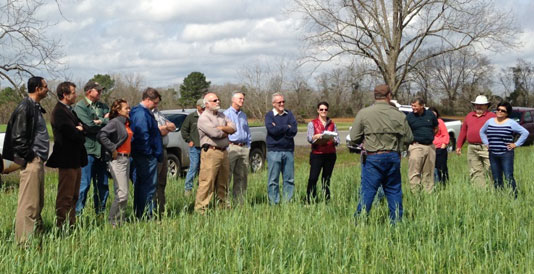 February 24, 2014 - The FCI-supported Tri-state climate learning community for row crop agriculture held their ninth workshop on Feb. 20th in Headland, Alabama at the Wiregrass Research Station. Twenty-seven people attended, including producers, researchers and extension professionals from 12 counties in FL, GA and AL. The morning fieldtrip was organized by William Birdsong (Auburn University Cooperative Extension) and highlighted climate-related risk management at the Satsuma orchard of Hertzog farms. During an additional two other farm visits producers, Myron Johnson and Thomas Kirkland guided the group in a discussion about the benefits and practices associated with cover crops (hairy vetch and cereal rye). David Zierden, FL state climatologist (FSU) provided a seasonal climate review and outlook. Growers were particularly interested in hearing about the physical drivers responsible for recent cold weather. David also piqued interest in learning more about the theory of arctic amplification.
February 24, 2014 - The FCI-supported Tri-state climate learning community for row crop agriculture held their ninth workshop on Feb. 20th in Headland, Alabama at the Wiregrass Research Station. Twenty-seven people attended, including producers, researchers and extension professionals from 12 counties in FL, GA and AL. The morning fieldtrip was organized by William Birdsong (Auburn University Cooperative Extension) and highlighted climate-related risk management at the Satsuma orchard of Hertzog farms. During an additional two other farm visits producers, Myron Johnson and Thomas Kirkland guided the group in a discussion about the benefits and practices associated with cover crops (hairy vetch and cereal rye). David Zierden, FL state climatologist (FSU) provided a seasonal climate review and outlook. Growers were particularly interested in hearing about the physical drivers responsible for recent cold weather. David also piqued interest in learning more about the theory of arctic amplification.The Tri-state climate group was initiated in April 2010 and is coordinated by Dr. Wendy-Lin Bartels, Assistant Research Scientist at FCI. Row crop stakeholders meet twice a year in Florida, Alabama or Georgia in February (prior to planting) and in early August during summer “downtime” (prior to harvest). The broad aim of this climate learning network is to create a space for on-going interactions among row crop stakeholders at a regional scale (SE USA) to identify and assess adaptation options that can reduce climate-related risks. Workshops emphasize hands-on, peer-to-peer learning through on-farm field visits, in-depth discussions, and experimentation. Interactions enable local experiences to influence research directions (and vice versa). Researchers from the Florida Climate Institute and the Southeast Climate Consortium coordinate and facilitate the group with support through a USDA-NIFA-funded project.
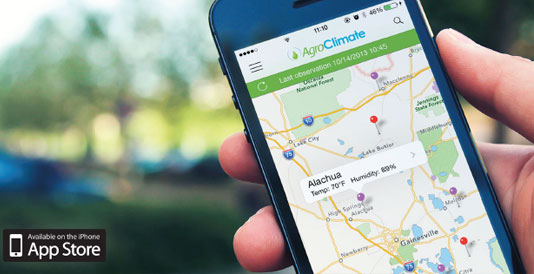 February 25, 2014 - The AgroClimate Mobile app is an innovative way to help Florida growers make more informed decisions based on weather and climate information. Growers can check current weather conditions at FAWN weather stations and summarize observations during the last 7, 14 and 30 days. They can also register farms and fields for customized reports based on crop, planting /start date, soil texture and irrigation management.
February 25, 2014 - The AgroClimate Mobile app is an innovative way to help Florida growers make more informed decisions based on weather and climate information. Growers can check current weather conditions at FAWN weather stations and summarize observations during the last 7, 14 and 30 days. They can also register farms and fields for customized reports based on crop, planting /start date, soil texture and irrigation management.Download PDF flyer
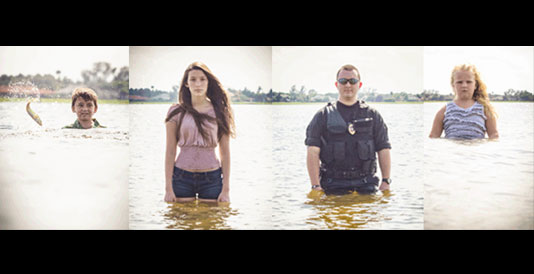 February 28, 2014 - The Kresge Foundation is funding Florida research with a two year, $250,000 Grant to The Florida Public Health Institute (FPHI) and Florida Atlantic University (FAU). FPHI is working to establish public health as a primary consideration in sea-level rise adaptation planning efforts and will partner with researchers from FAU to identify and model the health impacts of sea-level rise on South Florida residents. For information about this project, please contact Nicole Hammer at This email address is being protected from spambots. You need JavaScript enabled to view it..
February 28, 2014 - The Kresge Foundation is funding Florida research with a two year, $250,000 Grant to The Florida Public Health Institute (FPHI) and Florida Atlantic University (FAU). FPHI is working to establish public health as a primary consideration in sea-level rise adaptation planning efforts and will partner with researchers from FAU to identify and model the health impacts of sea-level rise on South Florida residents. For information about this project, please contact Nicole Hammer at This email address is being protected from spambots. You need JavaScript enabled to view it..
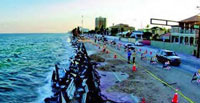 February 28, 2014 - The Florida Center for Environmental Studies (CES) at Florida Atlantic University with its partners, the CLEO Institute, the Good Government Initiative, UCS and WRI recently collaborated to host a workshop for 40 local elected officials in Miami-Dade County, FL. The workshop presented the impacts of sea-level rise and climate change science in an interactive format. The workshop goal was to increase local decision-makers’ understanding of impending sea level rise issues in their communities. The workshop provided a tool kit with key points to help them make informed decision, increase their support, and implement plans to address the impacts of climate change. CES is seeking funding to replicate this successful model in other Florida counties. For information please contact Nicole Hammer at This email address is being protected from spambots. You need JavaScript enabled to view it..
February 28, 2014 - The Florida Center for Environmental Studies (CES) at Florida Atlantic University with its partners, the CLEO Institute, the Good Government Initiative, UCS and WRI recently collaborated to host a workshop for 40 local elected officials in Miami-Dade County, FL. The workshop presented the impacts of sea-level rise and climate change science in an interactive format. The workshop goal was to increase local decision-makers’ understanding of impending sea level rise issues in their communities. The workshop provided a tool kit with key points to help them make informed decision, increase their support, and implement plans to address the impacts of climate change. CES is seeking funding to replicate this successful model in other Florida counties. For information please contact Nicole Hammer at This email address is being protected from spambots. You need JavaScript enabled to view it..
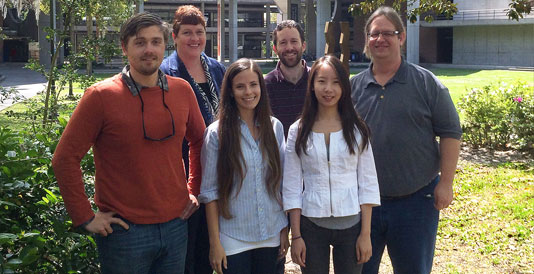 March 26, 2014 - An interdisciplinary team at the University of Florida's College of Design, Construction and Planning has won the American' Planning Association's (APA) Excellence in Small Town and Rural Planning - Student Project Award. The APA's Small Town and Rural Division will present the award to the team at the national APA conference in Atlanta in late April 2014. Information about the team’s winning project, "Yankeetown-Inglis Adaptive Design," and a link to the final report are at http://changinglevycoast.org/2014/01/03/yankeetown-inglis-adaptive-design-report/. This project was part of the two-year "Planning for Coastal Change in Levy County" project focusing on the issue of sea level rise and funded by the Florida Sea Grant (http://changinglevycoast.org). The student team was: Sean Reiss (Urban and Regional Planning), Rong Zeng (Urban and Regional Planning), Jana Rosenbloom (Landscape Architecture), and Kevin Bennett (Building Construction). Advisors were: Kathryn Frank (Urban and Regional Planning) and Michael Volk (Center for Landscape Conservation Planning). The award comes with a $200 subsidy for travel to the national conference.
March 26, 2014 - An interdisciplinary team at the University of Florida's College of Design, Construction and Planning has won the American' Planning Association's (APA) Excellence in Small Town and Rural Planning - Student Project Award. The APA's Small Town and Rural Division will present the award to the team at the national APA conference in Atlanta in late April 2014. Information about the team’s winning project, "Yankeetown-Inglis Adaptive Design," and a link to the final report are at http://changinglevycoast.org/2014/01/03/yankeetown-inglis-adaptive-design-report/. This project was part of the two-year "Planning for Coastal Change in Levy County" project focusing on the issue of sea level rise and funded by the Florida Sea Grant (http://changinglevycoast.org). The student team was: Sean Reiss (Urban and Regional Planning), Rong Zeng (Urban and Regional Planning), Jana Rosenbloom (Landscape Architecture), and Kevin Bennett (Building Construction). Advisors were: Kathryn Frank (Urban and Regional Planning) and Michael Volk (Center for Landscape Conservation Planning). The award comes with a $200 subsidy for travel to the national conference.
 March 26, 2014 - Dr. Reed Noss, a co-director of the FCI at the University of Central Florida (UCF), has been named a UCF "Pegasus Professor." The award is the most prestigious a faculty member can receive at UCF. The honor recognizes extraordinary contributions to the UCF community through teaching, research and service. Each recipient receives a statue of the UCF Pegasus, a gold Pegasus Professor medallion and a check for $5,000.
March 26, 2014 - Dr. Reed Noss, a co-director of the FCI at the University of Central Florida (UCF), has been named a UCF "Pegasus Professor." The award is the most prestigious a faculty member can receive at UCF. The honor recognizes extraordinary contributions to the UCF community through teaching, research and service. Each recipient receives a statue of the UCF Pegasus, a gold Pegasus Professor medallion and a check for $5,000. 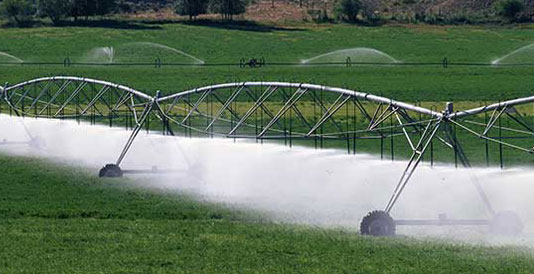 March 26, 2014 - A new University of Florida web-based tool worked well during its trial run to measure water consumption at farms in four Southern states. The system measures the “water footprint” of a farm, which is a measure of the consumptive water use required to produce a crop. Water footprint is described in units of water volume used relative to mass of produce (gallons/lb or liters/kg). The tool was developed by Daniel Dourte, Clyde Fraisse, and Oxana Uryasev through AgroClimate.
March 26, 2014 - A new University of Florida web-based tool worked well during its trial run to measure water consumption at farms in four Southern states. The system measures the “water footprint” of a farm, which is a measure of the consumptive water use required to produce a crop. Water footprint is described in units of water volume used relative to mass of produce (gallons/lb or liters/kg). The tool was developed by Daniel Dourte, Clyde Fraisse, and Oxana Uryasev through AgroClimate.Water Footprint Calculator
Southeast Farm Press article
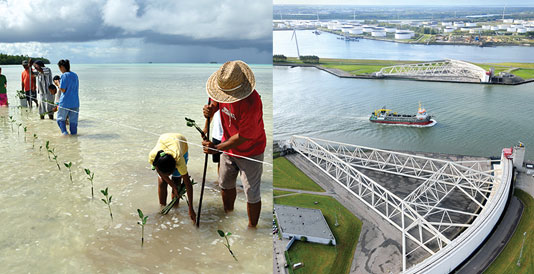 April 1, 2014 - The Intergovernmental Panel on Climate Change (IPCC) Working Group II has released a report titled Climate Change 2014: Impacts, Adaptation, and Vulnerability. The objective of this contribution of Working Group II to the IPCC's Fifth Assessment Report is to consider the vulnerability and exposure of human and natural systems, the observed impacts and future risks of climate change, and the potential for and limits to adaptation. The chapters of the report assess risks and opportunities for societies, economies, and ecosystems around the world. The 30-chapter report is divided into two volumes. Volume I focuses on global and sectoral aspects. It introduces the report with chapters that provide the context for the AR5, followed by those on natural and managed resources and systems; human settlements, industry, and infrastructure; and human health, well-being, and security. Volume I has a set of four chapters on adaptation. The final three chapters in Volume I synthesize information from Volume I and II chapters to provide multi-sector impacts, risks, vulnerabilities, and opportunities. Volume II chapters provide assessments on regions.
April 1, 2014 - The Intergovernmental Panel on Climate Change (IPCC) Working Group II has released a report titled Climate Change 2014: Impacts, Adaptation, and Vulnerability. The objective of this contribution of Working Group II to the IPCC's Fifth Assessment Report is to consider the vulnerability and exposure of human and natural systems, the observed impacts and future risks of climate change, and the potential for and limits to adaptation. The chapters of the report assess risks and opportunities for societies, economies, and ecosystems around the world. The 30-chapter report is divided into two volumes. Volume I focuses on global and sectoral aspects. It introduces the report with chapters that provide the context for the AR5, followed by those on natural and managed resources and systems; human settlements, industry, and infrastructure; and human health, well-being, and security. Volume I has a set of four chapters on adaptation. The final three chapters in Volume I synthesize information from Volume I and II chapters to provide multi-sector impacts, risks, vulnerabilities, and opportunities. Volume II chapters provide assessments on regions.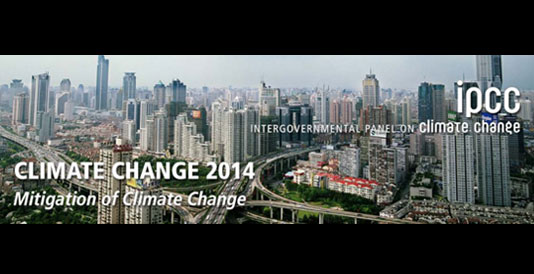 April 14, 2014 - Concluding four years of intense scientific collaboration by hundreds of authors from around the world, this report responds to the request of the world's governments for a comprehensive, objective and policy neutral assessment of the current scientific knowledge on mitigating climate change. The report has been extensively reviewed by experts and governments to ensure quality and comprehensiveness. The quintessence of this work, the Summary for Policymakers, has been approved line by line by member governments at the 12th Session of IPCC WG III in Berlin, Germany (7-11 April 2014).
April 14, 2014 - Concluding four years of intense scientific collaboration by hundreds of authors from around the world, this report responds to the request of the world's governments for a comprehensive, objective and policy neutral assessment of the current scientific knowledge on mitigating climate change. The report has been extensively reviewed by experts and governments to ensure quality and comprehensiveness. The quintessence of this work, the Summary for Policymakers, has been approved line by line by member governments at the 12th Session of IPCC WG III in Berlin, Germany (7-11 April 2014).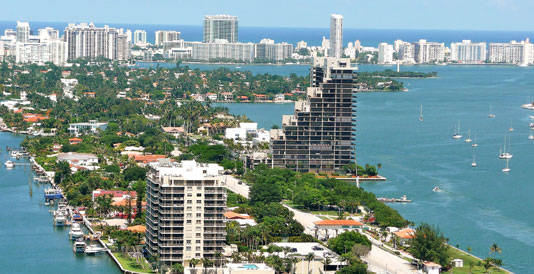 April 15, 2014 - Miami could know as early as 2020 how high sea levels will rise into the next century, according to a team of researchers including Florida International University scientist René Price. Price and a team of international researchers analyzed data from 10 sea level monitoring stations throughout the world. They examined historical data to identify the timing at which accelerations might first be recognized in a significant manner and extended projections through 2100. The findings are published in this week's issue of the journal Nature Communications.
April 15, 2014 - Miami could know as early as 2020 how high sea levels will rise into the next century, according to a team of researchers including Florida International University scientist René Price. Price and a team of international researchers analyzed data from 10 sea level monitoring stations throughout the world. They examined historical data to identify the timing at which accelerations might first be recognized in a significant manner and extended projections through 2100. The findings are published in this week's issue of the journal Nature Communications.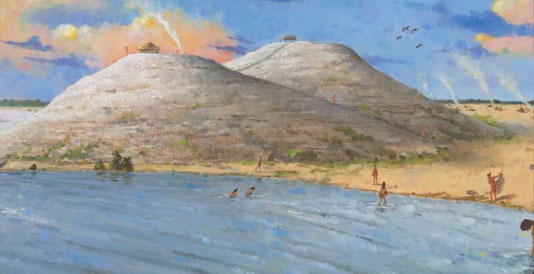 April 17, 2014 - In collaboration with the National Park Service and local educators, researchers from Dr. Linda Walter's biology lab at the University of Central Florida, has produced a book entitled We Will Remember Turtle Mound: Uncovering the Past and Saving the Future of Florida’s First People. This book, geared toward fourth grade curriculum, tells the story of the Timucuan people and Turtle Mound, one of the largest coastal shell middens on the east coast. After describing the past, it tells about recent losses of artifacts due to climate change and “living shoreline” efforts to preserve and protect the midden into the future.
April 17, 2014 - In collaboration with the National Park Service and local educators, researchers from Dr. Linda Walter's biology lab at the University of Central Florida, has produced a book entitled We Will Remember Turtle Mound: Uncovering the Past and Saving the Future of Florida’s First People. This book, geared toward fourth grade curriculum, tells the story of the Timucuan people and Turtle Mound, one of the largest coastal shell middens on the east coast. After describing the past, it tells about recent losses of artifacts due to climate change and “living shoreline” efforts to preserve and protect the midden into the future.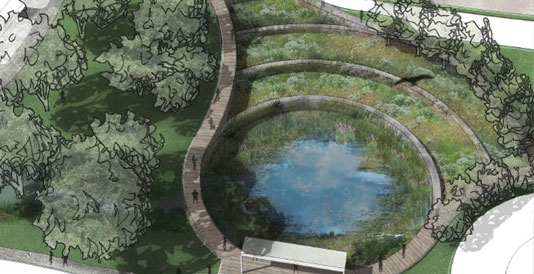 April 23, 2014 - The U.S. Environmental Protection Agency (EPA) today announced the four winners of its second annual Campus RainWorks Challenge, a design challenge created to engage college and university students in reinventing our water infrastructure and developing innovative green infrastructure systems to reduce stormwater pollution and build resilience to climate change.
April 23, 2014 - The U.S. Environmental Protection Agency (EPA) today announced the four winners of its second annual Campus RainWorks Challenge, a design challenge created to engage college and university students in reinventing our water infrastructure and developing innovative green infrastructure systems to reduce stormwater pollution and build resilience to climate change.The University of Florida won 1st Place in the Master Plan Category for a design addressing a 67.6 acre subwatershed in the northeast corner of campus. To engage students with the journey of water, the three-phase plan would transform two detention facilities into campus amenities and daylight the flow of stormwater into above ground pipes and vegetated bioswales. In addition to treating and retaining stormwater and improving groundwater recharge, the team’s plan would improve aesthetics and safety along a major road.
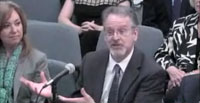 April 23, 2014 - On April 22, Dr. Frederick Bloetscher (FAU) testified to the Science and Space Sub-committee of the Commerce, Science and Transportation committee for the US Senate on the impacts of sea level rise. He noted that occasional flooding is not new to Florida, but the increasing frequency we currently experience is related to sea level rise, not just along the coast, but for large expanses of developed property inland due to topography and groundwater levels. As a result, the challenge for water managers in the state, especially in southeast Florida, is to control the groundwater table, because control of the water table is essential to prevent flooding of the low terrain. He noted that in Miami Beach, as elsewhere in Florida, the lowest lying areas are the roadways, which are also the location of electrical, water, sewer, phone and drainage infrastructure. Fortunately given the current Federally funded special imagery and NOAA data systems we are able to predict pretty accurately where flooding will occur. Linking that information with our detailed projections of sea level rise impacts we can begin now to map vulnerability and build adaptive measures into every action and plan we undertake.
April 23, 2014 - On April 22, Dr. Frederick Bloetscher (FAU) testified to the Science and Space Sub-committee of the Commerce, Science and Transportation committee for the US Senate on the impacts of sea level rise. He noted that occasional flooding is not new to Florida, but the increasing frequency we currently experience is related to sea level rise, not just along the coast, but for large expanses of developed property inland due to topography and groundwater levels. As a result, the challenge for water managers in the state, especially in southeast Florida, is to control the groundwater table, because control of the water table is essential to prevent flooding of the low terrain. He noted that in Miami Beach, as elsewhere in Florida, the lowest lying areas are the roadways, which are also the location of electrical, water, sewer, phone and drainage infrastructure. Fortunately given the current Federally funded special imagery and NOAA data systems we are able to predict pretty accurately where flooding will occur. Linking that information with our detailed projections of sea level rise impacts we can begin now to map vulnerability and build adaptive measures into every action and plan we undertake. He noted that he is positive on Florida’s future. Our best option is adaptation and there are many options available - for example we can install more coastal salinity structures, raise road beds, abandon some local roads, increase storm water pumping, add storm water retention etc. to address many of the problems. FAU has developed a toolbox of these options that can be applied to address these adaptation demands, resulting in an approach that will need a more managed integrated water system, more operations and inevitably more dollars. Much of the actual needs are local, but the problem is regional and requires a concerted effort of federal, state and local agencies and the private sector to address the scales of the problem. A community can address the local problems, but the regional canals, barriers, etc., are beyond the scope of individual agencies. Collaboration and discussion are needed. The Four County Compact is an excellent example, but the longer term solutions need the state and federal agencies and the related dollars to address larger impacts.
The needs will be large - in the tens of billions. But there are two things in south Florida’s favor – time and money. The expenditures are over many, many years. Most important in the near term need is the early planning and identification of critical components of infrastructure and policy needs and timing for same. At risk are nearly 6 million of Floridians their economy and lifestyle, $3.7 trillion in property (2012) in south east Florida alone and a $260 billion annual economy. All of these are expected to continue to increase assuming the appropriate plans are made to adapt to the changing sea level. Protection of the area for the next 100-150 years is achievable as long as we have the science, the understanding and the will to do it. Plan now, and over the rest of this century starting now we can raise those billions of dollars needed.
 April 24, 2014 - On April 24, 2014, Dr. Rajendra Pachauri, Chair of the Intergovernmental Panel on Climate Change (IPCC) became the first recipient of the University of South Florida's Patel College “Eminent Global Scholar in Sustainability Award” in recognition of his extraordinary accomplishments in advancing the science and understanding of climate change and international policy. Dr. Pachauri’s visit to the USF Patel College comes on the heels of the recent Climate Change report released earlier this month by the U.N. IPCC that identified a clear human influence on the climate system. His compelling lecture to USF faculty, staff and students on “Energy Scenarios and Climate Impacts” was followed by a vibrant question and answer session.
April 24, 2014 - On April 24, 2014, Dr. Rajendra Pachauri, Chair of the Intergovernmental Panel on Climate Change (IPCC) became the first recipient of the University of South Florida's Patel College “Eminent Global Scholar in Sustainability Award” in recognition of his extraordinary accomplishments in advancing the science and understanding of climate change and international policy. Dr. Pachauri’s visit to the USF Patel College comes on the heels of the recent Climate Change report released earlier this month by the U.N. IPCC that identified a clear human influence on the climate system. His compelling lecture to USF faculty, staff and students on “Energy Scenarios and Climate Impacts” was followed by a vibrant question and answer session. 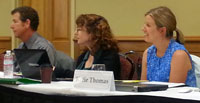 April 24, 2014 - On April 22-23, the Florida State University Department of Earth, Ocean and Atmospheric Science hosted the National Academy of Sciences (NAS) Board on Atmospheric Sciences and Climate (BASC) spring meeting. This meeting was part of the board’s efforts to connect more directly with atmospheric sciences and climate researchers and users of our science outside the beltway. The board was excited to hear about new research that faculty and students at FSU are pursuing, to learn more about challenges the region faces, especially on climate preparedness and weather extremes, and to consider how regional issues and approaches related to federal priorities and initiatives. The co-directors of the FSU branch of the FCI, Drs. Eric Chassignet and Vasu Misra, both gave presentations that included FCI research.
April 24, 2014 - On April 22-23, the Florida State University Department of Earth, Ocean and Atmospheric Science hosted the National Academy of Sciences (NAS) Board on Atmospheric Sciences and Climate (BASC) spring meeting. This meeting was part of the board’s efforts to connect more directly with atmospheric sciences and climate researchers and users of our science outside the beltway. The board was excited to hear about new research that faculty and students at FSU are pursuing, to learn more about challenges the region faces, especially on climate preparedness and weather extremes, and to consider how regional issues and approaches related to federal priorities and initiatives. The co-directors of the FSU branch of the FCI, Drs. Eric Chassignet and Vasu Misra, both gave presentations that included FCI research.BASC is the focal point within the National Academy of Sciences for activities related to the atmospheric and climate sciences, serving as a source for objective, independent advice to the federal government and others. Through its board meetings, study committees, and convening functions, BASC strives to advance understanding of atmospheric science, meteorology, and climate; foster application of this knowledge to benefit the public; guide US research programs so they address key scientific opportunities and the needs of the nation; and ensure that the voice of the science community is considered in government planning and decision making.
New features include:
- downloadable data - including detailed projections, place summary tables, and low-lying facility lists
- improved map: includes property value layer
- more forecasts: including the latest IPCC projections
- more variables analyzed: military areas, parks, protected land, colleges & universities,
- more more places analyzed: FL county commission districts, FL city council and commission districts, state legislative districts and more
- dynamic threat rankings (by variable and water level)
- tablet-friendly layout
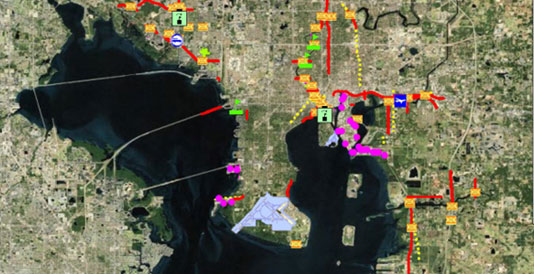 April 30, 2014 - A visualization tool has been developed by the University of Florida Urban and Regional Planning research team directed by Dr. Zhong-Ren Peng as part of the Mississippi-Alabama Sea Grant Consortium project “Development of Sea Level Rise Adaptation Planning Procedures and Tools Using NOAA Sea Level Rise Impacts Viewer.” The tool helps local planners identify the most vulnerable infrastructures and places using the inundation data provided by the NOAA Sea Level Rise and Coastal Flooding Impacts Viewer. Using the online visualization tool (University of Florida sea level rise viewer), the users can easily view the estimated vulnerability under 1-foot, 2-foot, and 5-foot scenarios. Detailed information regarding the vulnerable infrastructure and the vulnerable census block groups can also be viewed.
April 30, 2014 - A visualization tool has been developed by the University of Florida Urban and Regional Planning research team directed by Dr. Zhong-Ren Peng as part of the Mississippi-Alabama Sea Grant Consortium project “Development of Sea Level Rise Adaptation Planning Procedures and Tools Using NOAA Sea Level Rise Impacts Viewer.” The tool helps local planners identify the most vulnerable infrastructures and places using the inundation data provided by the NOAA Sea Level Rise and Coastal Flooding Impacts Viewer. Using the online visualization tool (University of Florida sea level rise viewer), the users can easily view the estimated vulnerability under 1-foot, 2-foot, and 5-foot scenarios. Detailed information regarding the vulnerable infrastructure and the vulnerable census block groups can also be viewed. The tool is available at http://plaza.ufl.edu/dengyujun11/SLR7.0.html. More information regarding the viewer could be found at NOAA’s website http://csc.noaa.gov/digitalcoast/stories/tampa-viewer.
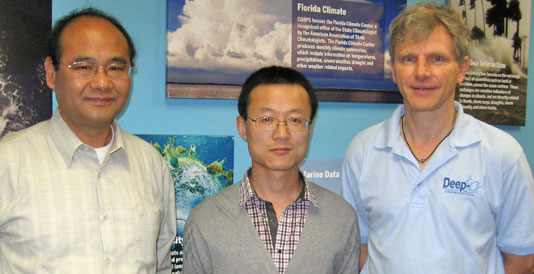 May 5, 2014 - New research by a team of Florida State University scientists shows the first detailed look at global land surface warming trends over the last 100 years, illustrating precisely when and where different areas of the world started to warm up or cool down. The research indicates that the world is indeed getting warmer, but historical records show that it hasn’t happened everywhere at the same rate.
May 5, 2014 - New research by a team of Florida State University scientists shows the first detailed look at global land surface warming trends over the last 100 years, illustrating precisely when and where different areas of the world started to warm up or cool down. The research indicates that the world is indeed getting warmer, but historical records show that it hasn’t happened everywhere at the same rate. “Global warming was not as understood as we thought,” said Zhaohua Wu, an assistant professor of meteorology at FSU. Wu led a team of climate researchers including Fei Ji, a visiting doctoral student at FSU’s Center for Ocean-Atmospheric Prediction Studies (COAPS); Eric Chassignet, director of COAPS; and Jianping Huang, dean of the College of Atmospheric Sciences at Lanzhou University in China. The group, using an analysis method newly developed by Wu and his colleagues, examined land surface temperature trends from 1900 onward for the entire globe, minus Antarctica. Previous work by scientists on global warming could not provide information of non-uniform warming in space and time due to limitations of previous analysis methods in climate research.
FSU Press Release: http://news.fsu.edu/More-FSU-News/New-study-sheds-light-on-global-warming-trends
Nature Climate Change Article: http://dx.doi.org/10.1038/nclimate2223
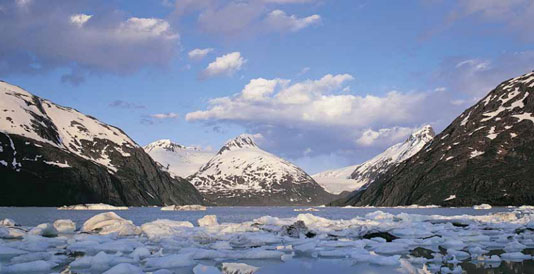 May 29, 2014 - Yesterday, the U.S. Environmental Protection Agency (EPA) released the third edition of a report, Climate Change Indicators in the United States. The report pulls together observed data on key measures of our environment, including U.S. and global temperature and precipitation, ocean heat and ocean acidity, sea level, length of growing season, and many others. With 30 indicators that include over 80 maps and graphs showing long-term trends, the report demonstrates that climate change is already affecting our environment and our society.
May 29, 2014 - Yesterday, the U.S. Environmental Protection Agency (EPA) released the third edition of a report, Climate Change Indicators in the United States. The report pulls together observed data on key measures of our environment, including U.S. and global temperature and precipitation, ocean heat and ocean acidity, sea level, length of growing season, and many others. With 30 indicators that include over 80 maps and graphs showing long-term trends, the report demonstrates that climate change is already affecting our environment and our society. EPA Press Release: http://yosemite.epa.gov/opa/admpress.nsf/0/461768B5CE68DC8B85257CE600558D63
Report: http://www.epa.gov/climatechange/science/indicators/index.html
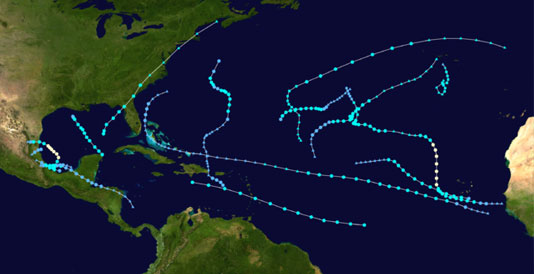 May 30, 2014 - Scientists at Florida State University’s Center for Ocean-Atmospheric Prediction Studies (COAPS) believe this year’s hurricane season, starting June 1, will be a quiet one. In the center’s sixth annual Atlantic hurricane forecast, FSU scientists predict that there is a 70 percent chance of five to nine named storms this year and two to six hurricanes. The average is seven named storms, four of them hurricanes, and an average accumulated cyclone energy (a measure of the strength and duration of storms accumulated during the season) of 60. The primary reason for the below normal numbers, said lead scientist Timothy LaRow, is that an El Niño — or warmer than normal water temperatures — is forecast to develop in the tropical Pacific. “El Niño develops when sea surface temperatures in the eastern equatorial Pacific Ocean are warmer than normal for several consecutive months, leading to increased vertical wind shear in the Atlantic, which can disrupt developing tropical systems,” LaRow said. “How quickly and how intense the El Niño becomes will determine its impact on the North Atlantic hurricane season.” The 2014 North Atlantic hurricane forecast numbers are based on 60 individual seasonal atmospheric forecasts conducted at FSU on its High Performance Computing Cluster using sea surface temperatures predicted by the National Oceanic and Atmospheric Administration (NOAA) climate model. LaRow’s forecast is developed using a unique atmospheric model created at FSU that has had remarkable success in predicting seasonal tropical activity. Since 1995, when the North Atlantic entered the period of heightened activity, the model has predicted 14.1 named storms and 7.9 hurricanes per year compared to the observed 14.7 named storms and 7.7 hurricanes. The model is one of only a handful of climate models being used to study seasonal hurricane activity. Hurricane season begins June 1 and runs through Nov. 30.
May 30, 2014 - Scientists at Florida State University’s Center for Ocean-Atmospheric Prediction Studies (COAPS) believe this year’s hurricane season, starting June 1, will be a quiet one. In the center’s sixth annual Atlantic hurricane forecast, FSU scientists predict that there is a 70 percent chance of five to nine named storms this year and two to six hurricanes. The average is seven named storms, four of them hurricanes, and an average accumulated cyclone energy (a measure of the strength and duration of storms accumulated during the season) of 60. The primary reason for the below normal numbers, said lead scientist Timothy LaRow, is that an El Niño — or warmer than normal water temperatures — is forecast to develop in the tropical Pacific. “El Niño develops when sea surface temperatures in the eastern equatorial Pacific Ocean are warmer than normal for several consecutive months, leading to increased vertical wind shear in the Atlantic, which can disrupt developing tropical systems,” LaRow said. “How quickly and how intense the El Niño becomes will determine its impact on the North Atlantic hurricane season.” The 2014 North Atlantic hurricane forecast numbers are based on 60 individual seasonal atmospheric forecasts conducted at FSU on its High Performance Computing Cluster using sea surface temperatures predicted by the National Oceanic and Atmospheric Administration (NOAA) climate model. LaRow’s forecast is developed using a unique atmospheric model created at FSU that has had remarkable success in predicting seasonal tropical activity. Since 1995, when the North Atlantic entered the period of heightened activity, the model has predicted 14.1 named storms and 7.9 hurricanes per year compared to the observed 14.7 named storms and 7.7 hurricanes. The model is one of only a handful of climate models being used to study seasonal hurricane activity. Hurricane season begins June 1 and runs through Nov. 30. FSU COAPS Hurricane Forecast Webpage: http://coaps.fsu.edu/hurricanes
FSU Press Release: http://news.fsu.edu/More-FSU-News/2014-hurricane-forecast-predicts-below-average-season-ahead
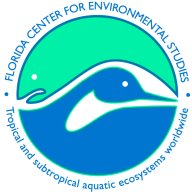 May 30, 2014 - Florida Atlantic University (FAU) continues studying the effects of sea level rise in South Florida with a new focus on climate change related health risks. The Florida Public Health Institute (FPHI) serves as the lead on the project, made possible by a $250,000 grant from the Kresge Foundation over a two year period. Project Lead Dr. Leonard Berry, Director of the Center for Environmental Studies at FAU (CES), said the project provides CES the opportunity to expand its area of study. “Of all the potential impacts of sea-level rise, health may be one of the least studied and yet is one of the most important. This grant will enable us to begin to redress this imbalance.”
May 30, 2014 - Florida Atlantic University (FAU) continues studying the effects of sea level rise in South Florida with a new focus on climate change related health risks. The Florida Public Health Institute (FPHI) serves as the lead on the project, made possible by a $250,000 grant from the Kresge Foundation over a two year period. Project Lead Dr. Leonard Berry, Director of the Center for Environmental Studies at FAU (CES), said the project provides CES the opportunity to expand its area of study. “Of all the potential impacts of sea-level rise, health may be one of the least studied and yet is one of the most important. This grant will enable us to begin to redress this imbalance.”According to FHIP, potential health risks include water quality changes such as saltwater intrusion, landfill/brownfield seepage, higher levels of sewage and toxic pollutants, increasing rates of waterborne diseases, and higher rates of respiratory-related illness due to increasing levels of airborne allergens such as mold exposure.
The project resulted from four years of collaboration between Debora Kerr (FPHI Chief Operating Officer) and Nicole Hernandez Hammer, Co-Principal Investigator (FAU). Researchers will map storm-related health data across time and geography in Palm Beach, Broward, Miami-Dade and Monroe C ounties. Hammer and Co-Principal Investigators from FAU, Drs. Frederick Bloetscher and Diana Mitsova, will be overlaying health data onto FAU-developed groundwater maps. The funding represents one of the many outcomes of the October 2013 Sea Level Rise Summit hosted by FAU.
Contributing to the health data collection are Kristina Kitzinger and Meredith Jagger, leads on the Florida BRACE Project, one of fourteen national initiatives of the Centers for Disease Control and Prevention in Building Resilience Against Climate Effects initiatives.
For more information on climate change research and education at FAU’s Center for Environmental studies, please visit http://www.ces.fau.edu.
 May 30, 2014 - Dr. Kathleen Ruppert received the University of Florida’s Champion of Change award in the academics category through the Office of Sustainability and Healthy Gators for her work in developing an Action Plan for promoting sustainability in extension offices. Many Extension offices are being asked to save money for their county in any way possible. The University of Florida (UF) Institute of Food and Agricultural Sciences Program for Resource Efficient Communities, working with UF's Office of Sustainability and undergraduate students in UF's College of Design, Construction and Planning, produced the document, Action Plan for Promoting Sustainability in Extension Offices. The intent is to help Extension offices become models for resource-efficient, sustainable, behavior for the clients and community they serve as well as saving money for the county. Note that the Excel spreadsheet, found at http://buildgreen.ufl.edu/Extension_and_Sustainability.htm, is referenced in the Word document also found on the same website. The students who worked on this document hope that a few faculty, staff members, and volunteers working within each county Extension office will take on this challenge to create and promote a greener and more sustainable world. Both the Word document and the Excel spreadsheet are intended to be copied to your hard drive and edited to fit the needs of individual county Extension offices. Note that, with some minor changes, these materials could be utilized by any group or organization. Please consider the students’ request and show that all organizations are interested in initiating practices that contribute to a more sustainable, high quality of life in and for all communities. If you have questions or suggestions for improving the document or spreadsheet, contact Kathleen Ruppert (This email address is being protected from spambots. You need JavaScript enabled to view it.) with the Sustainable FloridiansSM program.
May 30, 2014 - Dr. Kathleen Ruppert received the University of Florida’s Champion of Change award in the academics category through the Office of Sustainability and Healthy Gators for her work in developing an Action Plan for promoting sustainability in extension offices. Many Extension offices are being asked to save money for their county in any way possible. The University of Florida (UF) Institute of Food and Agricultural Sciences Program for Resource Efficient Communities, working with UF's Office of Sustainability and undergraduate students in UF's College of Design, Construction and Planning, produced the document, Action Plan for Promoting Sustainability in Extension Offices. The intent is to help Extension offices become models for resource-efficient, sustainable, behavior for the clients and community they serve as well as saving money for the county. Note that the Excel spreadsheet, found at http://buildgreen.ufl.edu/Extension_and_Sustainability.htm, is referenced in the Word document also found on the same website. The students who worked on this document hope that a few faculty, staff members, and volunteers working within each county Extension office will take on this challenge to create and promote a greener and more sustainable world. Both the Word document and the Excel spreadsheet are intended to be copied to your hard drive and edited to fit the needs of individual county Extension offices. Note that, with some minor changes, these materials could be utilized by any group or organization. Please consider the students’ request and show that all organizations are interested in initiating practices that contribute to a more sustainable, high quality of life in and for all communities. If you have questions or suggestions for improving the document or spreadsheet, contact Kathleen Ruppert (This email address is being protected from spambots. You need JavaScript enabled to view it.) with the Sustainable FloridiansSM program. June 26, 2014 - At the latest in a series of workshops known as InTeGrate: Teaching about Risk and Resilience, educators and managers learned about transferring actionable knowledge on climate change and disaster preparedness to relevant sectors, including policy-makers and the general public.
June 26, 2014 - At the latest in a series of workshops known as InTeGrate: Teaching about Risk and Resilience, educators and managers learned about transferring actionable knowledge on climate change and disaster preparedness to relevant sectors, including policy-makers and the general public. InTeGrate, a project funded by the National Science Foundation, brought sixty professionals, including scientists and researchers, to the Florida Atlantic University (FAU) campus in Boca Raton, Florida on May 14-16, 2014. A central question in the series is, “How do we prepare students for careers where they can make useful and valuable contributions that mitigate risks and increase resilience in the face of a growing population and changing environment?” The interdisciplinary project was developed by Cathy Manduca, Director of the Science Education Resource Center (SERC) at Carleton College and David Blockstein, National Council for Science and the Environment. For the May workshop Leonard Berry, Director of the Florida Center for Environmental Studies (CES) at FAU, Mantha Mehallis at FAU’s College of Business and John Taberof IRIS (Incorporated Research Institutions for Seismology) joined the team to develop the workshop topic of Risk and Resilience.
In response, Ricardo A. Alvarez, former Deputy Director, International Hurricane Center, Research Affiliate at CES, spoke about the challenges of interpreting science to vulnerable communities. After extolling the use of real life case studies in teaching about risk and resilience, he and Nancy Gassman, Assistant Director of Public Works Sustainability, City of Fort Lauderdale, presented a sea level rise scenario from South Florida, while Mark Benthien of University of Southern California (USC) and Keith Porter of SPA Risk LLC presented an earthquake scenario from California.
Panel discussions led to breakout discussions related to flooding, coastal erosion, water-management, and seasonal, extreme high tides. For example, participants most interested in the Fort Lauderdale case study noted the indirect impact of Hurricane Sandy exacerbated by sea level rise. The session, moderated by Eileen Johnson of Bowdoin College, examined the scientific and engineering aspect of the study, and addressed teaching the subject matter to undergraduates.
Rounding out the team of workshop presenters and conveners, Monica Bruckner of SERC at Carleton College and Mary Beth Hartman of CES at FAU coordinated and hosted the event.
For more information on climate change research and education at FAU’s Center for Environmental studies, please visit http://www.ces.fau.edu
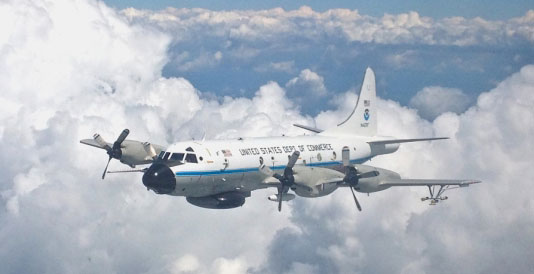 July 8, 2014 - Drs. Mark Powell (NOAA/FSU) and Steve Cocke (FSU) are part of a new collaboration between NOAA and the Dept. of Energy to collect data that could lead to improved offshore wind turbine designs. Powell's efforts will involve boundary layer research, and Cocke will work on hurricane risk modelling.
July 8, 2014 - Drs. Mark Powell (NOAA/FSU) and Steve Cocke (FSU) are part of a new collaboration between NOAA and the Dept. of Energy to collect data that could lead to improved offshore wind turbine designs. Powell's efforts will involve boundary layer research, and Cocke will work on hurricane risk modelling. 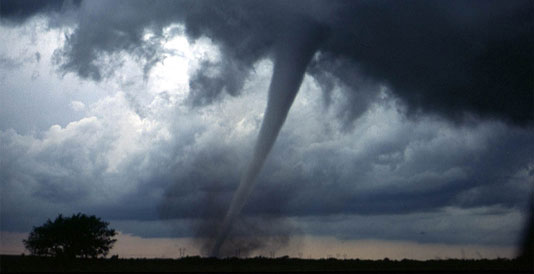 August 6, 2014 - New research by a Florida State University geography professor shows that climate change may be playing a key role in the strength and frequency of tornadoes hitting the United States.
August 6, 2014 - New research by a Florida State University geography professor shows that climate change may be playing a key role in the strength and frequency of tornadoes hitting the United States. Published Wednesday in the journal Climate Dynamics, Professor James Elsner writes that though tornadoes are forming fewer days per year, they are forming at a greater density and strength than ever before. So, for example, instead of one or two forming on a given day in an area, there might be three or four occurring.
Climate Dynamics Article: http://link.springer.com/article/10.1007%2Fs00382-014-2277-3
 August 14, 2014 - To continue momentum under the Climate Data Initiative, the Obama Administration is renewing the President’s call to America’s private-sector innovators to leverage open government data and other resources to build tools that will make the U.S. and global food systems more resilient against the impacts of climate change. In response to this call, today’s launch includes a number of commitments by Federal agencies and private-sector collaborators to combat climate change and support food resilience through data-driven innovation.
August 14, 2014 - To continue momentum under the Climate Data Initiative, the Obama Administration is renewing the President’s call to America’s private-sector innovators to leverage open government data and other resources to build tools that will make the U.S. and global food systems more resilient against the impacts of climate change. In response to this call, today’s launch includes a number of commitments by Federal agencies and private-sector collaborators to combat climate change and support food resilience through data-driven innovation. The Agricultural Model Intercomparison & Improvement Program and the Center for Integrated Modeling of Sustainable Agriculture and Nutrition Security. The Agricultural Model Intercomparison & Improvement Program (AgMIP) and the Center for Integrated Modeling of Sustainable Agriculture and Nutrition Security (CIMSANS), in partnership with the International Food Policy Research Institute (IFPRI), are announcing a new public-private partnership on open data and open-source code modeling to enhance the climate-resilience of food systems. The new partnership will secure the resources and expertise necessary to evaluate seven novel nutrition and sustainability metrics of global food systems, including all of the world’s important staple and non-staple foods, through the year 2050.
Monsanto. Monsanto is announcing that it will donate a multi-site/multi-year maize breeding trial dataset to open data portals maintained by the International Center for Tropical Agriculture (CIAT) and the Agricultural Model Intercomparison & Improvement Project (AgMIP). Opening these data will it make it possible for public- and private-sector scientists to improve models being used to understand how climate and water-availability changes will impact crop productivity and therefore food security. Monsanto is also partnering with a number of external scientists in the AgMIP community to improve one of the leading publicly available crop-growth simulation models (AgMaize).
Fact Sheet: http://www.whitehouse.gov/the-press-office/2014/07/29/fact-sheet-empowering-america-s-agricultural-sector-and-strengthening-fo
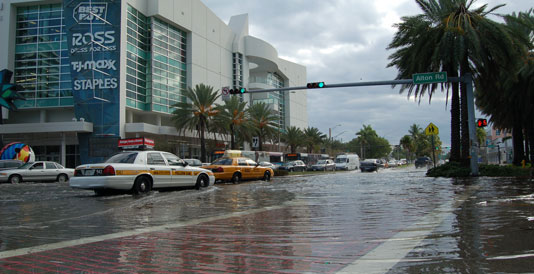 August 29, 2014 - Thanks to co-authors Alicia Betancourt and Maia McGuire, along with contributors Libby Carnahan, JP Gellermann and Mary Campbell, the Sustainable FloridiansSM program has a new module. The module, Climate Change and Sea Level Rise, was reviewed by Libby Carnahan and Gary Mitchum (USF) and consists of a PowerPoint presentation, a pdf of the PowerPoint presentation including the notes, lesson plan/facilitator outline, evaluation and post-test, action plan, and resources list.
August 29, 2014 - Thanks to co-authors Alicia Betancourt and Maia McGuire, along with contributors Libby Carnahan, JP Gellermann and Mary Campbell, the Sustainable FloridiansSM program has a new module. The module, Climate Change and Sea Level Rise, was reviewed by Libby Carnahan and Gary Mitchum (USF) and consists of a PowerPoint presentation, a pdf of the PowerPoint presentation including the notes, lesson plan/facilitator outline, evaluation and post-test, action plan, and resources list. http://buildgreen.ufl.edu/Extension_and_Sustainability/SF_Climate_Change_and_Sea_Level_Rise_public.pdf
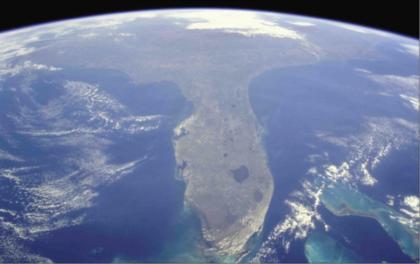 August 29, 2014 - The Florida Climate Institute has developed the Florida CARES center request that will bring together prominent universities across the State in partnership with state and regional agencies and the business community to create an economy more resilient to risks from hurricane damage, periodic droughts and floods, higher sea levels, and future climate trends. It will develop research and deliver education programs in support of Florida’s major economic engines (e.g., tourism, agriculture, trade, transportation and coastal marine resources). Working with partners from industries and agencies, it will help develop the workforce to manage Florida’s resources while growing its economy. Florida CARES will make Florida more competitive through its collaborative research and training programs, and create marketable expertise and technologies to meet the increasing demands of the state’s future.
August 29, 2014 - The Florida Climate Institute has developed the Florida CARES center request that will bring together prominent universities across the State in partnership with state and regional agencies and the business community to create an economy more resilient to risks from hurricane damage, periodic droughts and floods, higher sea levels, and future climate trends. It will develop research and deliver education programs in support of Florida’s major economic engines (e.g., tourism, agriculture, trade, transportation and coastal marine resources). Working with partners from industries and agencies, it will help develop the workforce to manage Florida’s resources while growing its economy. Florida CARES will make Florida more competitive through its collaborative research and training programs, and create marketable expertise and technologies to meet the increasing demands of the state’s future.http://floridaclimateinstitute.org/images/document_library/publications/201408LBRStrategyDocument.pdf
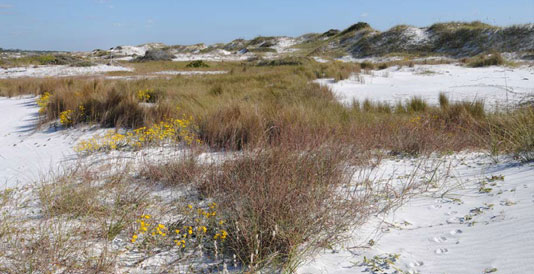 September 2, 2014 - This report was led by the FCI's Dr. Reed Noss and funded by the Kresge Foundation and the Florida Fish and Wildlife Conservation Commission. The study focuses on vulnerability of species and natural communities to interacting threats from sea level rise and projected land-use change (primarily urbanization), with some attention also to temperature and precipitation change. A range of adaptation options was analyzed for ca. 300 species and 30 natural communities of conservation concern.
September 2, 2014 - This report was led by the FCI's Dr. Reed Noss and funded by the Kresge Foundation and the Florida Fish and Wildlife Conservation Commission. The study focuses on vulnerability of species and natural communities to interacting threats from sea level rise and projected land-use change (primarily urbanization), with some attention also to temperature and precipitation change. A range of adaptation options was analyzed for ca. 300 species and 30 natural communities of conservation concern.http://floridaclimateinstitute.org/images/reports/201409NossKresge.pdf
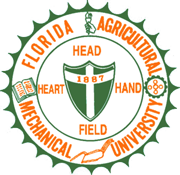 September 4, 2014 - The FCI is pleased to welcome Florida A&M University in Tallahassee as its 8th member university! Dr. Odemari Mbuya is the branch director and Dr. Daniel Solis is the branch co-director. Both are from FAMU's College of Agriculture and Food Sciences.
September 4, 2014 - The FCI is pleased to welcome Florida A&M University in Tallahassee as its 8th member university! Dr. Odemari Mbuya is the branch director and Dr. Daniel Solis is the branch co-director. Both are from FAMU's College of Agriculture and Food Sciences.
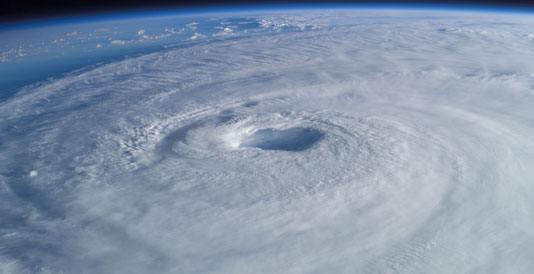 September 16, 2014 - A new study by Florida State University researchers demonstrates a different way of projecting a hurricane’s strength and intensity that could give the public a better idea of a storm’s potential for destruction.
September 16, 2014 - A new study by Florida State University researchers demonstrates a different way of projecting a hurricane’s strength and intensity that could give the public a better idea of a storm’s potential for destruction. Vasu Misra, associate professor of meteorology and co-director of the Florida Climate Institute, and fourth-year doctoral student Michael Kozar introduce in the Monthly Weather Review of the American Meteorological Society a new statistical model that complements hurricane forecasting by showing the size of storms, not just the wind speed.
http://news.fsu.edu/More-FSU-News/Research-offers-new-way-to-predict-hurricane-strength-destruction
http://journals.ametsoc.org/doi/abs/10.1175/MWR-D-14-00117.1
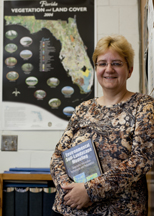 September 30, 2014 - Warm temperatures and a wet landscape increase soil’s ability to store carbon, which in turn helps mitigate greenhouse gas emissions, according to a new University of Florida study covering 45 years of data.
September 30, 2014 - Warm temperatures and a wet landscape increase soil’s ability to store carbon, which in turn helps mitigate greenhouse gas emissions, according to a new University of Florida study covering 45 years of data. Soil-stored carbon can slow the build-up of carbon-based gases in the atmosphere, a phenomenon believed to be a cause of global climate change. So it’s vital to preserve soil carbon, said Sabine Grunwald, a UF soil and water science professor who led the research.
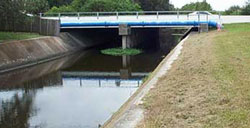 October 1, 2014 - Dr. Ni-Bin Chang, Professor and Director of the University of Central Florida’s Stormwater Management Academy, Rahim Harji, Pinellas County’s Watershed Management Unit Manager, and Thomas Ruppert, Florida Sea Grant Coastal Planning Specialist, were awarded a grant from Florida Sea Grant titled “Coupling Risk and Resilience Assessment for Networked Sustainable Drainage Systems in a Coastal City under Climate Change Impact.” The team will assist Pinellas County to implement an effective, efficient, and resilient stormwater system in the Cross Bayou Watershed of Pinellas County that increases infrastructure resilience and robustness by incorporating low impact development (LID) controls and flood proofing technologies to harmonize existing storm sewer systems under climate change and sea-level rise scenarios.
October 1, 2014 - Dr. Ni-Bin Chang, Professor and Director of the University of Central Florida’s Stormwater Management Academy, Rahim Harji, Pinellas County’s Watershed Management Unit Manager, and Thomas Ruppert, Florida Sea Grant Coastal Planning Specialist, were awarded a grant from Florida Sea Grant titled “Coupling Risk and Resilience Assessment for Networked Sustainable Drainage Systems in a Coastal City under Climate Change Impact.” The team will assist Pinellas County to implement an effective, efficient, and resilient stormwater system in the Cross Bayou Watershed of Pinellas County that increases infrastructure resilience and robustness by incorporating low impact development (LID) controls and flood proofing technologies to harmonize existing storm sewer systems under climate change and sea-level rise scenarios. This project is motivated by the fact that there are no standard methods/criteria/matrices to measure the sustainability of coastal stormwater sewer systems in terms of resilience and robustness in association with varying risk levels of episodic disturbances including climate variability and sea-level rise scenarios. This project proposes a new concept, the networked sustainable drainage systems, which are featured by ‘system of systems’ or "network of networks" characteristics (i.e., with cascade effect) that should be less vulnerable to flood impact under climate variability and sea-level rise. The project will provide a suite of quantitative tools and methods to build an innovative platform via coupling the risk and resilience assessment to pave a pathway for producing adaptive stormwater management strategies for Pinellas County Government. This advancement will: 1) inform the County engineering solutions to flood hazards, 2) allow Pinellas County to implement its current policies seeking to promote LID, 3) serve as a model for innovative stormwater management technique in the County, 4) incorporate climate change and sea-level rise impacts into stormwater infrastructure in the County, 5) review policies or plan of the County for a better cost-benefit-risk trade-off for stormwater management in the County, 6) deliver the final products to local and regional partners by a series of outreach activities, and 7) disseminate new knowledge to help the County optimize future planning and design of networked sustainable drainage systems.
 October 2, 2014 - Daniel Solís, Ph.D., Assistant Professor at FAMU’s College of Agriculture and Food receives the 2014 - 2015 FAMU’s Faculty Research Award for his research project: "The Effect of IFQs on the Total Productivity of the U.S. Gulf of Mexico Red Snapper Industry". With grant support from The National Oceanic and Atmospheric Administration, this Agribusiness Program professor, set a goal to analyze the impact of regulations and climate variability on the technical efficiency and composition of the Gulf of Mexico Red Snapper commercial fleet. For more details, please visit: http://dsolisw.weebly.com/
October 2, 2014 - Daniel Solís, Ph.D., Assistant Professor at FAMU’s College of Agriculture and Food receives the 2014 - 2015 FAMU’s Faculty Research Award for his research project: "The Effect of IFQs on the Total Productivity of the U.S. Gulf of Mexico Red Snapper Industry". With grant support from The National Oceanic and Atmospheric Administration, this Agribusiness Program professor, set a goal to analyze the impact of regulations and climate variability on the technical efficiency and composition of the Gulf of Mexico Red Snapper commercial fleet. For more details, please visit: http://dsolisw.weebly.com/
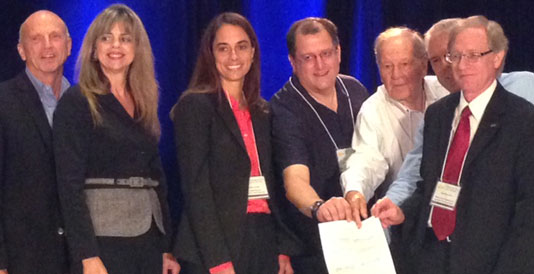 October 2, 2014 - A partnership between the Southeast Florida Regional Climate Change Compact (Compact) and the Florida Climate Institute (FCI) aims to increase the effectiveness of current collaborations among Florida’s institutions of higher learning and the local governments and regional agencies of Southeast Florida. The purpose of the Partnership Agreement, signed Wednesday, October 1 in Miami, is to seek better alignment between public sector information and management needs and ongoing research objectives, to improve coordination among the parties in pursuing competitive research funding opportunities, and to assure that the best and brightest ideas emerging from Florida’s world-class institutions are well positioned for implementation in supporting Southeast Florida’s efforts to adapt to climate change and sea level rise and transition to a more resilient economy and coastal infrastructure.
October 2, 2014 - A partnership between the Southeast Florida Regional Climate Change Compact (Compact) and the Florida Climate Institute (FCI) aims to increase the effectiveness of current collaborations among Florida’s institutions of higher learning and the local governments and regional agencies of Southeast Florida. The purpose of the Partnership Agreement, signed Wednesday, October 1 in Miami, is to seek better alignment between public sector information and management needs and ongoing research objectives, to improve coordination among the parties in pursuing competitive research funding opportunities, and to assure that the best and brightest ideas emerging from Florida’s world-class institutions are well positioned for implementation in supporting Southeast Florida’s efforts to adapt to climate change and sea level rise and transition to a more resilient economy and coastal infrastructure. Created in 2009 by forward-thinking elected officials, the Compact has emerged as one of the preeminent regional metropolitan climate change governance models nationally and globally. The collaboration and coordination across cities and counties and among federal, state, and local agencies has advanced the region rather quickly toward increased shared aspirations for greater climate resilience and reductions in regional emissions. Likewise, the Florida Climate Institute, created in 2010, is a path-breaking collaboration among eight of Florida’s world-class universities that serves as a multidisciplinary network for research and education aimed at helping Florida meet the many challenges of global climate change. Together, the Compact and FCI recognize that responsible action on global climate change will require the talents and insights of nearly every academic discipline from primary climate science to architecture, agriculture, and engineering, and from the arts and humanities to ecology and finance.
Students interested in a BASE scholarship should contact Dr. Charles Magee at This email address is being protected from spambots. You need JavaScript enabled to view it. or call (850) 412-5594.
Download Flyer
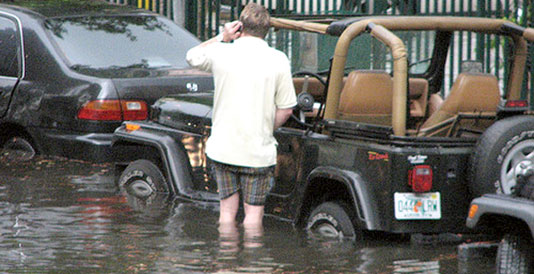 October 30, 2014 - Along South Florida’s coast a yearly event known as the King Tide has become an inconvenience to residents--the abnormally high tide pushes into sewage pipes and drowns roads in its path. The King Tide occurs when the sun and the moon are the closest to the earth. Over time the flooding has been getting more severe and has caused the local government millions of dollars in repairs. As a reprisal, local counties have implemented various methods to combat the flooding this year. Miami Beach has installed $15 million dollars’ worth of pumps to save the beachfront from excessive flooding, which is part of its five-year plan to protect the area from the consequences of sea level rise. The pumps have minimized the flooding to a more manageable amount; however, this temporary solution may not be the correct way to solve a progressing problem. A study done on tidal flooding using data collected for the White House’s National Climate Assessment illustrates how the flooding will increase over time, especially in Miami and Key West, due to sea level rise and the lack of preventative measures being taken.
October 30, 2014 - Along South Florida’s coast a yearly event known as the King Tide has become an inconvenience to residents--the abnormally high tide pushes into sewage pipes and drowns roads in its path. The King Tide occurs when the sun and the moon are the closest to the earth. Over time the flooding has been getting more severe and has caused the local government millions of dollars in repairs. As a reprisal, local counties have implemented various methods to combat the flooding this year. Miami Beach has installed $15 million dollars’ worth of pumps to save the beachfront from excessive flooding, which is part of its five-year plan to protect the area from the consequences of sea level rise. The pumps have minimized the flooding to a more manageable amount; however, this temporary solution may not be the correct way to solve a progressing problem. A study done on tidal flooding using data collected for the White House’s National Climate Assessment illustrates how the flooding will increase over time, especially in Miami and Key West, due to sea level rise and the lack of preventative measures being taken. The highest peak of the tide was predicted to be on Wednesday, October 8th but due to rain and the aid from the pumps the highest was recorded on Tuesday, October 7th. In Fort Lauderdale, Broward County installed 44 special tidal valves that helped combat flooding. Since King Tide flooding is predicted to occur more frequently as sea level continues to rise, the question is, where are the long term solutions? Natural events like these represent a perfect opportunity for informing the public and government officials about the costs of sea level rise adaptation and mitigation.
Sources:
Photo caption/credit: The flood-prone streets of Miami. Photo credit: Maxstrz / Creative Commons
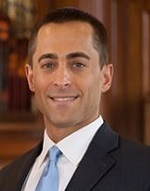 October 30, 2014 - The Florida Center for Environmental Studies (CES) at FAU begins an exciting new chapter and welcomes a new Director, Dr. Colin Polsky. CES has updated their mission of improving Florida's sustainability through research, education and outreach on ecology, climate change, and society.
October 30, 2014 - The Florida Center for Environmental Studies (CES) at FAU begins an exciting new chapter and welcomes a new Director, Dr. Colin Polsky. CES has updated their mission of improving Florida's sustainability through research, education and outreach on ecology, climate change, and society.In August 2014, Dr. Polsky joined FAU as Professor of Geosciences and successor to Dr. Leonard Berry, who founded CES in 1994 and remains active as Emeritus Professor of Geosciences. Dr. Polsky joins Dr. Berry on the Executive Board of the Florida Climate Institute (FCI).
Dr. Polsky is trained as a geographer, specializing in the Human Dimensions of Global Environmental Change. His programs of study and postdoctoral work in mathematics, humanities, French, geography, and Science & International Affairs (from U. Texas, Penn State, and Harvard, respectively) have led to a sustained interest in advancing knowledge of U.S. climate vulnerabilities, in both methodological and applied terms.
In addition to multiple NSF grants, peer-reviewed articles and co-authored books, Polsky has served as co-Convening Lead Author for a chapter in the 2013 National Climate Assessment, served on NRC, NSF, and USGCRP committees, and prepared reviews for several IPCC reports.
His experience and strong sense of purpose for CES will lead the Center in further expanding its impact on sustainability in Florida. Contact him at This email address is being protected from spambots. You need JavaScript enabled to view it..
For more information on climate change research and education at FAU’s Center for Environmental studies, please visit http://www.ces.fau.edu
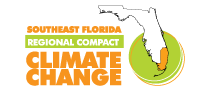 October 30, 2014 - In 2011, the interagency group known as the Compact Sea Level Rise (SLR) Working Group, organized by the Southeast Florida Regional Climate Change Compact, came to an agreement on the projections for sea level rise that the Compact would use for sea level change up to the year 2060. In light of this year’s IPCC Report from NOAA, revised SLR Considerations from the U. S. Army Corps of Engineers, and the 2014 National Climate Assessment SLR projections, the Compact SLR Working Group is now meeting again to update the projections through 2100. Led by Dr. Samantha Danchuk, P.E., Assistant Director, Environmental Planning and Community Resilience Division, Broward County, group members include representatives from several South Florida universities and municipalities, and the South Florida Water Management District.
October 30, 2014 - In 2011, the interagency group known as the Compact Sea Level Rise (SLR) Working Group, organized by the Southeast Florida Regional Climate Change Compact, came to an agreement on the projections for sea level rise that the Compact would use for sea level change up to the year 2060. In light of this year’s IPCC Report from NOAA, revised SLR Considerations from the U. S. Army Corps of Engineers, and the 2014 National Climate Assessment SLR projections, the Compact SLR Working Group is now meeting again to update the projections through 2100. Led by Dr. Samantha Danchuk, P.E., Assistant Director, Environmental Planning and Community Resilience Division, Broward County, group members include representatives from several South Florida universities and municipalities, and the South Florida Water Management District.
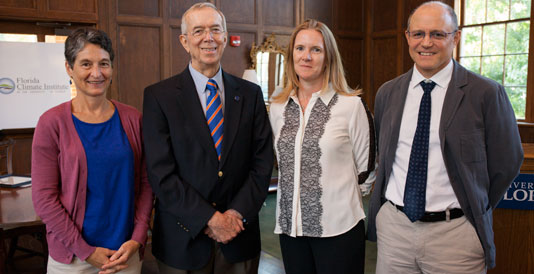 October 31, 2014 - The Florida Climate Institute at UF has awarded its 2014-15 Faculty Fellows. Dr. Jane Southworth and Jonathan Dain received this year’s award for their superior contributions to the FCI and its programs on the UF campus and abroad. Both fellows receive a 3 year stipend in recognition of their efforts in climate research, education, and outreach. Dr. Jane Southworth is a Professor in the Department of Geography and Jonathan Dain is the Director of the Florida Natural Resources Leadership Institute and faculty in the Center for Latin American Studies. Congratulations to both on their well-deserved awards!
October 31, 2014 - The Florida Climate Institute at UF has awarded its 2014-15 Faculty Fellows. Dr. Jane Southworth and Jonathan Dain received this year’s award for their superior contributions to the FCI and its programs on the UF campus and abroad. Both fellows receive a 3 year stipend in recognition of their efforts in climate research, education, and outreach. Dr. Jane Southworth is a Professor in the Department of Geography and Jonathan Dain is the Director of the Florida Natural Resources Leadership Institute and faculty in the Center for Latin American Studies. Congratulations to both on their well-deserved awards!
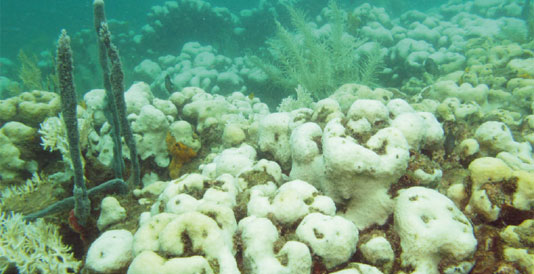 November 19, 2014 - A new study by a Florida State University biologist shows that bleaching events brought on by rising sea temperatures are having a detrimental long-term impact on coral.
November 19, 2014 - A new study by a Florida State University biologist shows that bleaching events brought on by rising sea temperatures are having a detrimental long-term impact on coral. Professor Don Levitan, chair of the Department of Biological Science, writes in the latest issue of Marine Ecology Progress Series that bleaching — a process where high water temperatures or UV light stresses the coral to the point where it loses its symbiotic algal partner that provides the coral with color — is also affecting the long-term fertility of the coral.
FSU Press Release: http://news.fsu.edu/More-FSU-News/Study-Environmental-bleaching-impairs-long-term-coral-reproduction
Journal Article: http://dx.doi.org/10.3354%2Fmeps11063
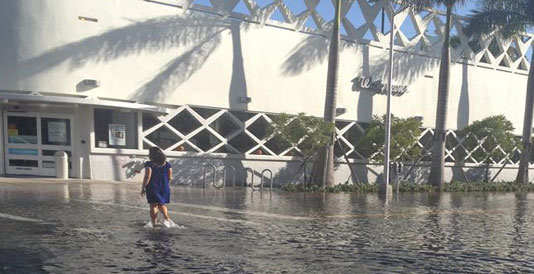 December 3, 2014 - Will vector-borne diseases such as Dengue Fever and West Nile Virus increase along with sea level rise? Florida Atlantic University (FAU) continues to support the Florida Institute for Health Innovation (FIHI, formerly FPHI) in its work studying climate change related health risks. The project has been made possible by a $250,000 grant from the Kresge Foundation to FIHI over a two year period ending in 2015. (See related article.)
December 3, 2014 - Will vector-borne diseases such as Dengue Fever and West Nile Virus increase along with sea level rise? Florida Atlantic University (FAU) continues to support the Florida Institute for Health Innovation (FIHI, formerly FPHI) in its work studying climate change related health risks. The project has been made possible by a $250,000 grant from the Kresge Foundation to FIHI over a two year period ending in 2015. (See related article.)FAU’s Department of Civil, Environmental, and Geomatics Engineering teamed with FAU’s School of Urban and Regional Planning to provide GIS data mapping and analysis. Combined with health data from the Florida Department of Health, researchers are seeking to identify populations in Southeastern Florida vulnerable to the effects of sea level rise and to determine if these populations will be at an increased risk for disease as sea levels rise. This phase of the project focuses on cryptosporidiosis, giardiasis, vector-borne diseases, vibriosis, and salmonellosis.
Project planning committee member Dr. Colin Polsky, Director of the Center for Environmental Studies at FAU (CES), said the project is in line with the Center’s vision of improving Florida's sustainability through research, education and outreach on ecology, climate change, and society: "The interdisciplinary nature of the project is the kind CES is designed to support. Targeted research in the health domain is particularly needed, and addressing this need puts CES on the cutting edge.”
For more information on climate change research and education at FAU’s Center for Environmental Studies, please visit www.ces.fau.edu.
Photo Caption: Lunar High Tide Flooding Miami Beach. Photo Credit: FAU CES.
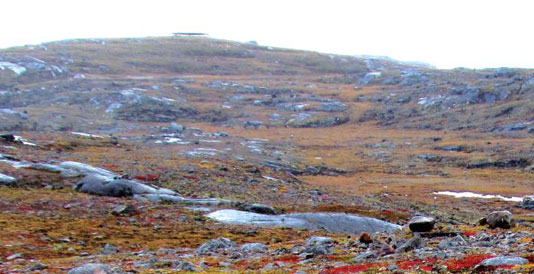 December 3, 2014 - Dr. Thomas Bianchi (UF), Dr. Mead Allison, and collaborators are developing a high-resolution record of the climate from the Holocene into the late Pleistocene in the Arctic, using sediment from the Beaufort Sea in Alaska. In a Q&A published in International Innovation, they jointly describe the reasons for studying the climate record in this region, and how the different members of their term converged to effectively do so.
December 3, 2014 - Dr. Thomas Bianchi (UF), Dr. Mead Allison, and collaborators are developing a high-resolution record of the climate from the Holocene into the late Pleistocene in the Arctic, using sediment from the Beaufort Sea in Alaska. In a Q&A published in International Innovation, they jointly describe the reasons for studying the climate record in this region, and how the different members of their term converged to effectively do so. Access the article through Dr. Bianchi's website or the International Innovation website.
The designation honors the “decisive action to cut carbon pollution and build resilience” already undertaken by the four Compact counties—Broward, Palm Beach, Miami-Dade, and Monroe. Since its establishment in 2009, the Compact has produced a series of technical planning documents providing a common framework for planning, including a unified sea level rise projection; published a five-year Regional Climate Action Plan (RCAP) and undertaken significant efforts to implement its 110 recommendations; and held annual summits reaching hundreds of local and regional leaders.
Full Broward County Press Release: https://webapps.broward.org/newsrelease/AdminDisplayMessages.aspx?intMessageId=5727
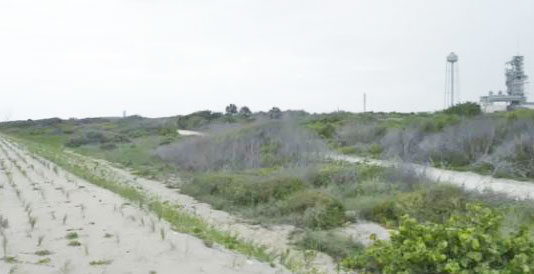 December 8, 2014 - The effects of climate change are already showing up in places from Miami to Alaska, scientists say, but two University of Florida geologists are focusing their attention on one especially noteworthy and vulnerable piece of waterfront real estate: Kennedy Space Center. What’s more, they say, the problem could affect operations at the space center within the next decade. “We were a little blind to it, like pre-Katrina New Orleans,” said one of the researchers, assistant professor Peter Adams of the UF Geological Sciences department. “Now that we’ve seen it, we’re sensitive to it.” Adams and associate professor of geology John Jaeger, who have been studying Cape Canaveral’s dunes and beach since 2009, say the impacts became most apparent after Hurricane Sandy. “Sandy got a lot of press up north, but it really did a tremendous amount of damage at Cape Canaveral,” Jaeger said. “Areas that had previously been relatively stable for decades … suddenly they were gone.” Adams said a combination of climate change-related sea-level rise and increased wave energy is almost certainly to blame.
December 8, 2014 - The effects of climate change are already showing up in places from Miami to Alaska, scientists say, but two University of Florida geologists are focusing their attention on one especially noteworthy and vulnerable piece of waterfront real estate: Kennedy Space Center. What’s more, they say, the problem could affect operations at the space center within the next decade. “We were a little blind to it, like pre-Katrina New Orleans,” said one of the researchers, assistant professor Peter Adams of the UF Geological Sciences department. “Now that we’ve seen it, we’re sensitive to it.” Adams and associate professor of geology John Jaeger, who have been studying Cape Canaveral’s dunes and beach since 2009, say the impacts became most apparent after Hurricane Sandy. “Sandy got a lot of press up north, but it really did a tremendous amount of damage at Cape Canaveral,” Jaeger said. “Areas that had previously been relatively stable for decades … suddenly they were gone.” Adams said a combination of climate change-related sea-level rise and increased wave energy is almost certainly to blame.Full UF Press Release and Video
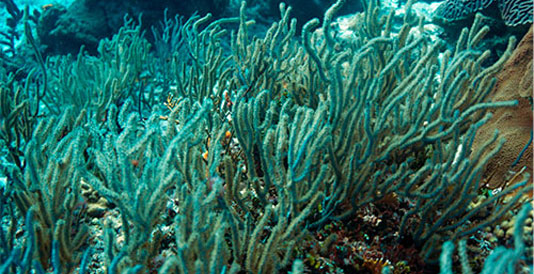 December 8, 2014 - A new study on tropical shallow-water soft corals, known as gorgonians, found that the species were able to calcify and grow under elevated carbon dioxide concentrations. These results suggest that Caribbean gorgonian corals may be more resilient to the ocean acidification levels projected by the end of the 21st century than previously thought.
December 8, 2014 - A new study on tropical shallow-water soft corals, known as gorgonians, found that the species were able to calcify and grow under elevated carbon dioxide concentrations. These results suggest that Caribbean gorgonian corals may be more resilient to the ocean acidification levels projected by the end of the 21st century than previously thought. An international team of scientists, including from the University of Miami (UM) Rosenstiel School of Marine and Atmospheric Science (RSMAS), tested the effects of elevated CO2 concentrations on the growth and calcification rates of the sea rod, Eunicea fusca, a type of gorgonian or soft coral found throughout the Bahamas, Bermuda, South Florida and into the Gulf of Mexico. Researchers collected E. fusca specimens from Big Pine Shoals in the Florida Keys to simulate a range of predicted future ocean acidification conditions – CO2 concentrations from 285-2,568 parts per million (pH range 8.1-7.1) – during a four-week experiment at the UM Rosenstiel School’s Coral Reefs and Climate Change Laboratory. Eunicea fusca showed a negative response to calcification under elevated CO2 concentrations, but growth and calcification did not stop under any of the CO2 levels used in the study.
Full UM RSMAS Press Release and Video
Related Miami Herald Article
Photo Caption: Eunicea fusca, Curacao. Photo Credit: Juan A. Sanchez – Universidad de los Andes, Bogota Colombia
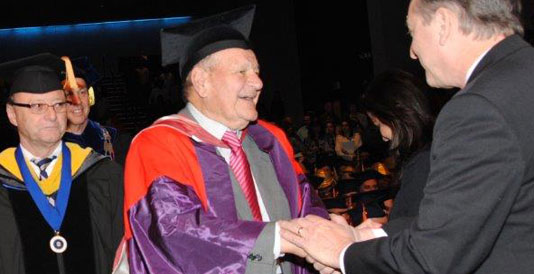 January 9, 2015 - On December 12, 2014, Dr. Leonard Berry was honored for his work in understanding climate change with the President’s Distinguished Service Medallion, awarded to individuals who have rendered service of great value to Florida Atlantic University (FAU) and the community at large, for example, US Senator Bill Nelson. Upon receiving the award, Dr. Berry said, “It was an acknowledgement at the university level of the importance of this topic.”
January 9, 2015 - On December 12, 2014, Dr. Leonard Berry was honored for his work in understanding climate change with the President’s Distinguished Service Medallion, awarded to individuals who have rendered service of great value to Florida Atlantic University (FAU) and the community at large, for example, US Senator Bill Nelson. Upon receiving the award, Dr. Berry said, “It was an acknowledgement at the university level of the importance of this topic.” A lead author of Chapter 17, Southeast and the Caribbean, of the National Climate Assessment, Dr. Berry has worked on climate change issues locally, nationally and globally for over 40 years. He is the founder and immediate past Director (1994-2014) of the Florida Center for Environmental Studies, Emeritus Professor of Geosciences and the Director of the Climate Change Initiative at FAU. He is also an Executive Committee member of The Florida Climate Institute (FCI). In April 2012, he testified to the United States Senate full committee on Natural Resources and Energy on the impacts of sea level rise in Florida.
He has worked on environmental research and development training programs for USAID, UNDP, UNESCO, GEF and UNEP, and the World Bank. He is a core member of the Inter-American Water Resources Network, The Southeast Florida Regional Climate Change Compact’s sea level rise technical working group, Florida Department of Economic Opportunity Community Resilience Group, Public Water Supply Utilities Climate Impacts Working Group, National Council for Science and the Environment, and the WaterWeb Consortium, an international water information group. Dr. Berry continues his work in climate change with FCI.
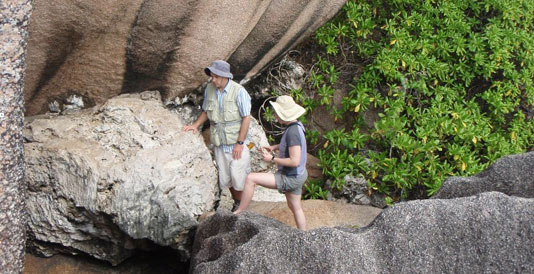 January 12, 2015 - The balmy islands of Seychelles couldn’t feel farther from Antarctica, but their fossil corals could reveal much about the fate of polar ice sheets.
January 12, 2015 - The balmy islands of Seychelles couldn’t feel farther from Antarctica, but their fossil corals could reveal much about the fate of polar ice sheets. About 125,000 years ago, the average global temperature was only slightly warmer, but sea levels rose high enough to submerge the locations of many of today’s coastal cities. Understanding what caused seas to rise then could shed light on how to protect those cities today.
By examining fossil corals found on the Indian Ocean islands, University of Florida geochemist Andrea Dutton found evidence that global mean sea level during that period peaked at 20 to 30 feet above current levels. Dutton’s team of international researchers concluded that rapid retreat of an unstable part of the Antarctic ice sheet was a major contributor to that sea-level rise.
University of Florida Press Release: http://news.ufl.edu/archive/2015/01/on-a-tropical-island-fossils-reveal-the-past--and-possible-future--of-polar-ice.html
Gainesville Sun Article: http://www.gainesville.com/article/20150112/ARTICLES/150119938
Quaternary Science Reviews Article: http://dx.doi.org/10.1016/j.quascirev.2014.10.025
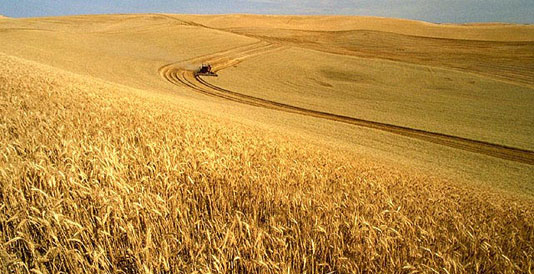 January 13, 2015 - For every degree Celsius that the temperature increases, the world stands to lose 6 percent of its wheat crop, according to a new global study led by a University of Florida scientist. That’s one fourth of the annual global wheat trade, which reached 147 million tons in 2013.
January 13, 2015 - For every degree Celsius that the temperature increases, the world stands to lose 6 percent of its wheat crop, according to a new global study led by a University of Florida scientist. That’s one fourth of the annual global wheat trade, which reached 147 million tons in 2013. Senthold Asseng, a UF professor of agricultural and biological engineering, used a computer model approach to reach the finding of temperature increases and wheat production.
“We started this with wheat, as wheat is one of the world’s most important food crops,” said Asseng, whose team’s study was published online Dec. 22 in the journal Nature Climate Change. “The simulations with the multi-crop models showed that warming is already slowing yield gains, despite observed yield increases in the past, at a majority of wheat-growing locations across the globe.”
University of Florida Press Release: http://news.ufl.edu/archive/2015/01/ufifas-study-wheat-yield-to-decline-as-temperatures-increase--.html
Nature Climate Change Article: http://dx.doi.org/10.1038/nclimate2470
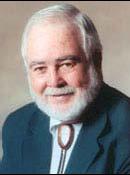 January 16, 2015 - Do you know why El Niño forecasts are so important? Robert O. Lawton Distinguished Professor James O’Brien, the guy that former Florida State University President Bernie Sliger referred to as “Dr. El Niño,” sure does. El Niño is defined by prolonged warming of sea surface temperatures in the Pacific Ocean. But researchers, including O’Brien, found over the years that those conditions often concoct the perfect storm of conditions for hurricanes and tornadoes. In the mid 1980s, he was one of three scientists recruited by the National Oceanic and Atmospheric Administration to build models to predict when we were about to experience the weather phenomenon. And when most of his colleagues began looking at how that weather pattern affected South America and Asia, he turned his attention to the United States, churning out predictions of how many hurricanes and tornadoes the country might experience. “I started out as an ocean modeler, putting math in the computer and then participating in building early prediction models,” he said.
January 16, 2015 - Do you know why El Niño forecasts are so important? Robert O. Lawton Distinguished Professor James O’Brien, the guy that former Florida State University President Bernie Sliger referred to as “Dr. El Niño,” sure does. El Niño is defined by prolonged warming of sea surface temperatures in the Pacific Ocean. But researchers, including O’Brien, found over the years that those conditions often concoct the perfect storm of conditions for hurricanes and tornadoes. In the mid 1980s, he was one of three scientists recruited by the National Oceanic and Atmospheric Administration to build models to predict when we were about to experience the weather phenomenon. And when most of his colleagues began looking at how that weather pattern affected South America and Asia, he turned his attention to the United States, churning out predictions of how many hurricanes and tornadoes the country might experience. “I started out as an ocean modeler, putting math in the computer and then participating in building early prediction models,” he said. Because of his contributions to this field, O’Brien is being recognized as a fellow of the International Union of Geodesy and Geophysics, a global organization dedicated to advancing research of the Earth and its environment. Franz Kuglitsch, executive secretary for the organization, said O’Brien received the honor for his exceptional contributions to “international cooperation in geoscience” and for having “attained eminence in the field of Earth and space sciences.” O’Brien, an accomplished meteorologist, has worked at Florida State for more than 40 years. “I was honored and surprised by the award,” O’Brien said. O’Brien, who received his bachelor’s degree from Rutgers University and his doctoral degree from Texas A&M University, is the retired director of the Center for Ocean-Atmospheric Prediction Studies (COAPS). He retired as the center’s director in 2006, but remains actively involved in the university and in his field as a professor emeritus. Eric Chassignet, O’Brien’s successor at the COAPS, called his colleague a “dynamic force.” “His work on coastal upwelling, El Niño/La Niña, and climate variability have made lasting contributions,” Chassignet said. “Not only is he known for his scientific work and his service to the community — he also has an impressive record of student mentorship. In recent years, he has worked to ensure that the next generation of scientists has the full set of skills necessary to move forward in their careers. It was his vision and relentless energy that led to the creation of COAPS, and we are grateful that even in retirement he continues to give his time and expertise to our center.”
O’Brien will be presented with the award in July in Prague.
FSU Press Release: http://news.fsu.edu/More-FSU-News/James-O-Brien-AKA-Dr.-El-Nino-Named-Fellow-of-International-Research-Group
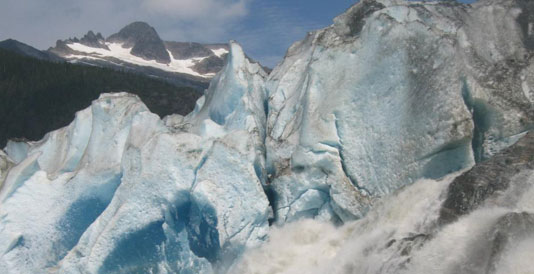 January 20, 2015 - As the Earth warms and glaciers all over the world begin to melt, researchers and public policy experts have focused largely on how all of that extra water will contribute to sea level rise. But another impact lurking in that inevitable scenario is carbon. More specifically, what happens to all of the organic carbon found in those glaciers when they melt?
January 20, 2015 - As the Earth warms and glaciers all over the world begin to melt, researchers and public policy experts have focused largely on how all of that extra water will contribute to sea level rise. But another impact lurking in that inevitable scenario is carbon. More specifically, what happens to all of the organic carbon found in those glaciers when they melt? That’s the focus of a new paper by a research team that includes Florida State University assistant professor Robert Spencer. The study, published in Nature Geoscience, is the first global estimate by scientists at what happens when major ice sheets break down.
“This is the first attempt to figure out how much organic carbon is in glaciers and how much will be released when they melt,” Spencer said. “It could change the whole food web. We do not know how different ecological systems will react to a new influx of carbon.”
FSU Press Release: http://news.fsu.edu/Top-Stories/Study-Melting-glaciers-have-big-carbon-impact
Nature Geoscience Article: http://dx.doi.org/10.1038/ngeo2331
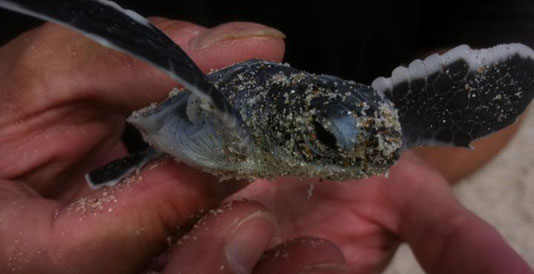 January 21, 2015 - A new University of Central Florida study is sounding the alarm about climate change and its potential impact on more than 30 years of conservation efforts to keep sea turtles around for the next generation.
January 21, 2015 - A new University of Central Florida study is sounding the alarm about climate change and its potential impact on more than 30 years of conservation efforts to keep sea turtles around for the next generation. Climate change is causing sea-level rise, and how coastal communities react to that rise could have dire consequences for sea turtles and other wildlife that rely on an unobstructed beach for survival. That's the conclusion of a University of Central Florida study recently published in Chelonian Conservation and Biology.
Llewellyn Ehrhart, a biology professor emeritus at UCF, began studying sea turtles in what later became the Archie Carr National Wildlife Refuge in southern Brevard County 31 years ago. By documenting the number of turtles laying eggs, the number of eggs that hatch and how many turtles make it to the water, he was able to demonstrate what is documented fact today: The 13-mile stretch of beach in southern Brevard is one of the most important nesting habitats for green and loggerhead turtles in the western hemisphere.
UCF Press Release: http://www.eurekalert.org/pub_releases/2015-01/uocf-cct012115.php
Chelonian Conservation and Biology Article: http://dx.doi.org/10.2744/CCB-1100.1
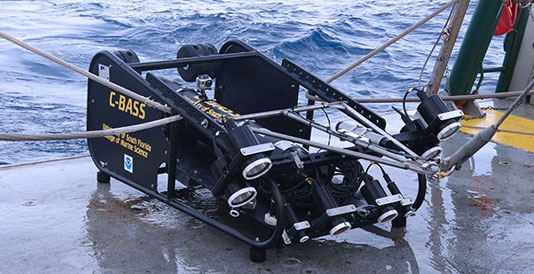 February 4, 2015 - The project will deploy a towed camera system called C-BASS (Camera-Based Survey Assessment System). Developed at the USF Center for Marine Technology, C-BASS will be deployed to determine the density, species composition and size structure of fishes using the various habitats.
February 4, 2015 - The project will deploy a towed camera system called C-BASS (Camera-Based Survey Assessment System). Developed at the USF Center for Marine Technology, C-BASS will be deployed to determine the density, species composition and size structure of fishes using the various habitats. "This set of studies will use state-of-the-art ocean imaging technologies to better understand and protect habitats off the west coast of Florida,” said College of Marine Science Dean Jackie Dixon."
- Read the full article at WUSF News
- Read the full article at Tampa Bay Newswire
 February 18, 2015 - Small wireless computing devices, ranging from the size of a matchbox to the size of a dime are going to change the way Florida monitors its water quality, sea level rise, hurricanes, agriculture, aquaculture, and even its aging senior population. The types of sensing devices developed by computer scientist Jason Hallstrom, Ph.D., who recently joined Florida Atlantic University, can collect information about the surrounding environment and transmit that information to cloud-based computing systems that store, analyze and present that information to educators, researchers and decision-makers. Deployable at massive scales, the technology represents a paradigm shift in how our world is observed and managed.
February 18, 2015 - Small wireless computing devices, ranging from the size of a matchbox to the size of a dime are going to change the way Florida monitors its water quality, sea level rise, hurricanes, agriculture, aquaculture, and even its aging senior population. The types of sensing devices developed by computer scientist Jason Hallstrom, Ph.D., who recently joined Florida Atlantic University, can collect information about the surrounding environment and transmit that information to cloud-based computing systems that store, analyze and present that information to educators, researchers and decision-makers. Deployable at massive scales, the technology represents a paradigm shift in how our world is observed and managed.Read Full FAU Press Release: http://www.ceecs.fau.edu/news/1502_hallstrom.php
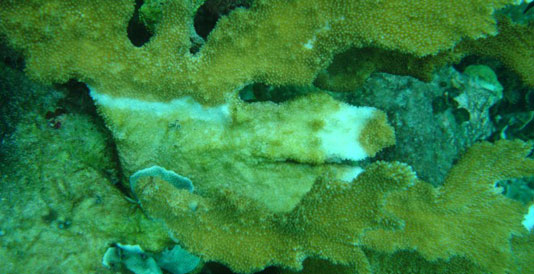 February 23, 2015 - Over the last four decades, the iconic elkhorn and staghorn corals that dominated Caribbean reefs for millions of years have all but disappeared. According to a new study from Florida Institute of Technology, ocean warming has played a significant role in this dramatic decline. The results of the study also suggest that limiting the rate of ocean warming, which would require curbing greenhouse gas emissions, could support the recovery of these critical reef-building corals.
February 23, 2015 - Over the last four decades, the iconic elkhorn and staghorn corals that dominated Caribbean reefs for millions of years have all but disappeared. According to a new study from Florida Institute of Technology, ocean warming has played a significant role in this dramatic decline. The results of the study also suggest that limiting the rate of ocean warming, which would require curbing greenhouse gas emissions, could support the recovery of these critical reef-building corals. White-band disease is a widespread coral disease that affects elkhorn and staghorn corals, and this disease has been plaguing these corals for decades. Florida Tech Ph.D. student Carly Randall and her faculty advisor, Robert van Woesik, studied the relationship between ocean temperatures and white-band disease and reported their findings in the February issue of Nature Climate Change. The study was posted this morning on the journal’s website at http://dx.doi.org/10.1038/nclimate2530.
Read Full FIT Press Release: http://newsroom.fit.edu/2015/02/22/new-florida-tech-study-links-coral-disease-to-a-warming-atlantic/
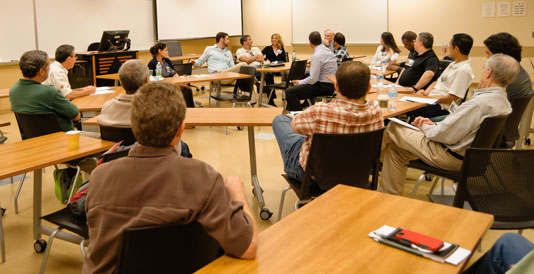 February 26, 2015 - Collaboration between US Geological Service (USGS) and Florida Atlantic University (FAU) scientists will continue to flourish and hopefully increase, thanks to a jointly-hosted event held on February 6, 2015 at the Florida Center for Environmental Studies (CES) on the FAU Davie Campus. The trans-disciplinary meeting aimed to strengthen partnerships between the two groups, which since 2014 have neighboring office space in the Davie West Building. By sharing research interests and facilitating conversations, both teams hope to develop new linkages among participants and strengthen existing ones.
February 26, 2015 - Collaboration between US Geological Service (USGS) and Florida Atlantic University (FAU) scientists will continue to flourish and hopefully increase, thanks to a jointly-hosted event held on February 6, 2015 at the Florida Center for Environmental Studies (CES) on the FAU Davie Campus. The trans-disciplinary meeting aimed to strengthen partnerships between the two groups, which since 2014 have neighboring office space in the Davie West Building. By sharing research interests and facilitating conversations, both teams hope to develop new linkages among participants and strengthen existing ones.After opening remarks, each of the 30 researchers had two minutes to present two slides highlighting their individual research backgrounds and interests. Experts presented their work in fields such as biology, civil engineering and geosciences. Other colleagues showcased the answers they’re seeking in hydrology, carbon cycling, ecological modeling and human dimensions. Subsequent break-out groups and informal networking provided opportunities to identify common goals and needs and to make connections.
Dr. Colin Polsky, Director of CES, said, “The meeting exemplified the kind of interaction CES is known for—interaction between scientists in diverse fields with the chance to advance Sustainability Science.”


